



The Delfina Foundation selected Jean-Paul Kelly to undertake a residency in winter 2015. During his residency, Kelly regularly attended the City of London Magistrate’s court in Central London as a visitor. For eight weeks, he observed the routine events and procedures that took place in the courtroom. The UK’s Criminal Justice Act prohibits any form of documentation within the courtroom, whether it be a sketch or a recording, and only allows illustrators to take notes, most likely in the quick and loose form of stenography.
The absence and overall restriction of documentation within a courtroom (and beyond) leads to the fairly obvious skewing of narrative events. Kelly, who works with found photographs, videos and sounds originating from documentaries, photojournalism and online media streams, realised that the particular restriction was advantageous to the concept and the production of his new work, That Ends That Matter. For him, lack of evidence or documentation of a specific event elucidates a direct relationship between physical materiality and subjective perception of each individual.
Such situations, in which evidence is lacking, fabricate image representations based on a very unreliable form of intangible reflection and recollection as both shared and personal memories. In our day and age, information is as effortlessly accessible as the Evening Standard on the Underground. However, within the courtroom, a place of supposed honesty and acknowledged transparency, the lack of documentation is paradoxical and challenges the sovereignty of such proceedings. That Ends That Matter is an eight-minute, three-channel video acting as a subjective reproduction of the events Kelly witnessed at court. One video re-enacts the court proceedings, another shows a constant photographic image stream as a retelling of the events and the remaining video acts as a visual soundtrack animation made out of geometric shapes.
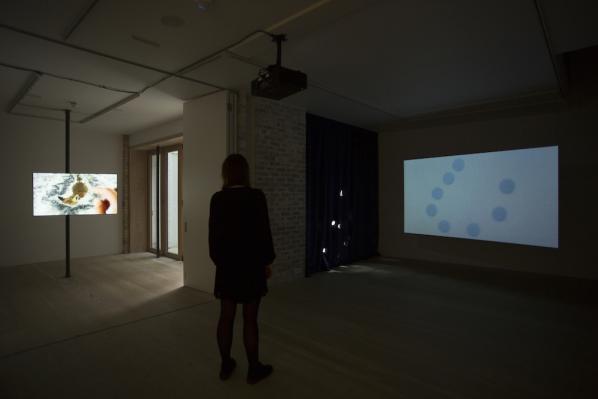
Initially walking underground into Delfina’s bunker exhibition space, the viewer is confronted by the loud noise coming from the visual animation. To the left of the space, two screens are paired together – the image stream with the animation – and to the right of the space, the re-enactment stands alone. Encountering three screens, viewers may feel bewildered as to how to view the work, however, after a bit of floating, it becomes quite apparent that viewing order doesn’t really matter as each visitor finds their own. Some focus solely on the paired screens, others on the lone screen, and some sit against the wall and view the two screens (image stream and re-enactment) of the two spaces from the side together.

The re-enactment screen video begins, and a soothing female voice sets the tone for the three-channel video:
‘Excuse me, are you appearing before us today? No? Alright, so you’re here as an observer then? Okay, thank you. Welcome… Now we’re going to switch on some noise so we can discuss the matters properly.’
White noise immediately becomes a means of blocking transparent communication, in turn emphasizing the notion of skewing memory and representation of factual information. The re-enactment is played around a table, whereby the actors appear to be waiting around, lingering and passing the time. Although the scene is filled with white noise, none of the participants are talking to each other and there is a particularly eerie focus on an old man who keeps caressing the table with his finger – he soon looks up at us. The environment itself is immersive; the longer the viewer stays with them and observes, the more explicitly the viewer’s presence is felt by the actors. Presence is noticed and through direct and uncomfortable staring at the viewer, it is implied that the viewer’s observation is not wanted. The viewer is thus inclined to move to the left space and look at the other two screens.

Kelly uses a series of motifs and shapes interacting with the tactility of the artist’s finger or palm in order to establish image representation. When the visual animation screen shows a circle and emits noise, the image-stream presents a finger hiding a specific aspect of the photograph. When it is a square or a rectangle, it is usually a palm that hides a part of the photograph. Tactility in an immovable image stream represents an abstraction towards the idea of transparency. The artist’s hands touch, caress, hide, rub, caress and thus at times become overtly sexual when corresponded with homoerotic images – the hole becomes a motif frequently expended. The motifs of tactility cover people’s faces, acts of violence found in protests, and various scenes of despair. Here, tactility not only acts as a way of forming a temporal moment of surrealism, but also as a method by which one can learn how to connect to the images one sees, much like children touching things for the first time. The white noise itself, from being disturbing becomes soothing and harmonious with all three screens.
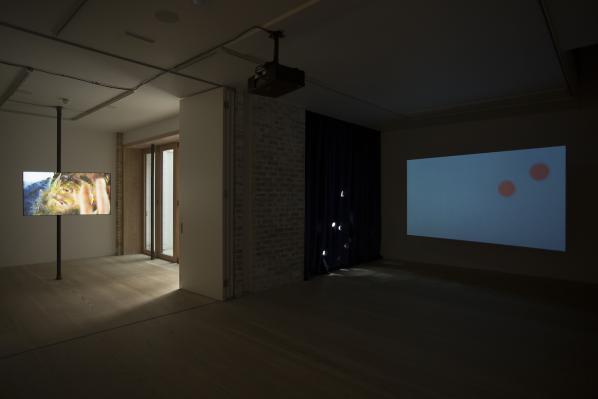
Smoke acts as another motif in images the viewer is shown. In a photograph where protesters are suffocated by teargas, the solution to the pain is pouring milk over your face, another act of blindness. Smoke becomes recurrent, and in the final frames of both the image-stream screen and the re-enactment screen, smoke presents itself with vigour. Smoke appears in the court of the re-enactment screen, and simultaneously, the sound stops altogether as the figures disappear in the haze.

That Ends That Matter’s representational strategy is based solely on memory and subjectivity as its response, much like the creation of human memories. To a certain degree, Kelly’s work embodies apophenia, a way of drawing connections and conclusions from sources that have no direct correlation other than their lasting perceptions – a spontaneous connection. It’s about communicating signs and non-objective matter, behaving in a way that strives to avoid both nostalgia and emotionlessness in order to question indexical notions of ethics in matters of transparency. Kelly may be asking, is abstraction fairer?
All images by Tim Bowditch, courtesy of Delfina Foundation.
At first glance networks and the practice of drawing would seem to be worlds apart. However, the diagram, originally a hand-drawn symbolic form, has long been employed by science as a means of visualising and explaining concepts. Perhaps the most important of these concepts is that of relationships visualised as circles and lines that represent nodes and links or effectively what is related. As such networks, that is groupings of relationships, have come to be visualised through the use of the same styles and iconography employed in diagrams. For artists to reclaim the diagram as a part of their own practice and thereby adopt the practice of visualising networks developed within science sees the practice of creating diagrams in a sense come full circle. Artists have time and time again drawn diagrams and networks that explore relationships. For example: Josef Beuys famously used blackboard diagrams as part of his teaching performances concerning art and politics; Stephen Willats has since the 1960s developed drawn diagrammatic works that explore his socially formed practice; Mark Lombardi drew societies’ networks of power relations throughout the 1990s; Torgeir Husevaag has since the late 1990s drawn diagrams of a number of networks within which he participated while Emma McNally draws diagrammatic networks “bringing different spaces into relation [such as] the virtual world, the networked world and the supposedly real world” (Hayward, 2014).
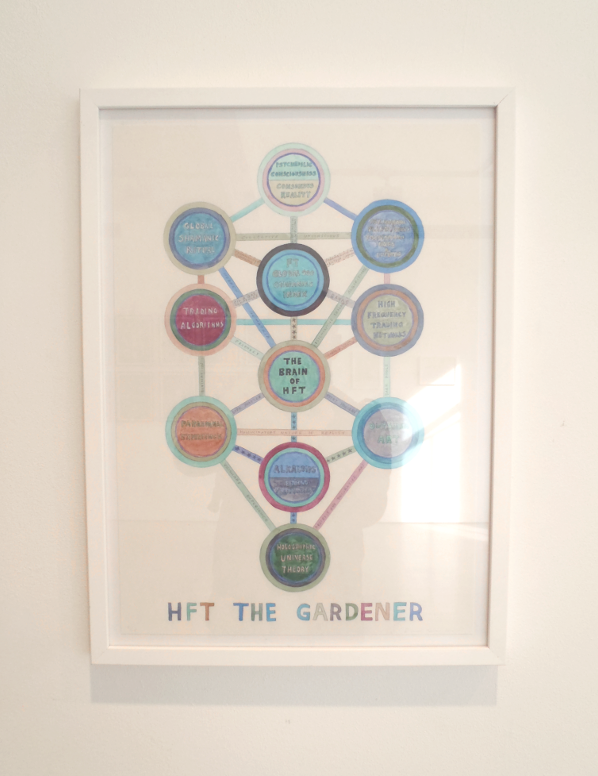
The work of Suzanne Treister resides within this category of artist’s drawing, and in this instance also painting, networks. With a background in painting Treister works across video, the internet, interactive technologies, photography, drawing and watercolour painting (Treister, n.d.). Her work employs “eccentric narratives and unconventional bodies of research to reveal structures that bind power, identity and knowledge” (ibid) within contemporary contexts. As a result of this process of revealing structures, essentially the relationships within the subject matter she addresses and the resulting networks they form, her practice has since the 1990s been closely allied with art that employs or explores technology. She has been repeatedly included in exhibitions and publications that link her work with networks, cybernetics, new media and most recently Post-Internet Art (Flanagan and Booth, 2002; Pickering, 2012; Larsen, 2014; Warde-Aldam, 2014).
HFT the Gardener (2014-15), a recent solo exhibition by Treister at Annely Juda Fine Art in London, is a body of artworks consisting of drawings, paintings, photographs and digital prints supposedly created by a fictional character and a documentary video about the same character. The character, Hillel Fischer Traumberg, is an algorithmic high-frequency trader (HFT) within the London Stock Exchange. After an optically induced semi-hallucinogenic state, Traumberg experiments with psychoactive drugs in order to recreate and further the experience (Treister, 2015). Along the way Traumberg becomes fascinated with botany, experiments with the molecular formulae of drugs as trading algorithms, makes links between the numerological equivalents of plants’ botanical names and the FT Global 500 index, visually documenting all of his research and ultimately becoming an ‘outsider’ artist (ibid). In the process Traumberg transitions from an insider of one network, a trader within the stock exchange, to that of an outsider in another, the contemporary art world.


This juxtaposition of opposites is repeated throughout the exhibition. For example, the drawings and paintings of HFT the Gardener employ illustrations of networks containing nodes and links. These illustrate a number of different sets of relationships that are established by the artist. These include: that of the central character to his concepts, research and environment; the locations where drugs were taken; states of consciousness; the components of an algorithm; different companies within a sector and different aspects of the universe including life and art. Additionally a variety of diagrammatic forms are co-opted in the creation of the drawings and paintings including the Judaic Kabbalah Tree of Life, radial diagrams, flowcharts similar to those used in software design and reference is made to a number of other abstracted forms including star charts, snow crystals, fractals and paisley design. Through both form and subject matter the illustrations of networks and the diagrams gather together combinations of opposites. There is of course the use of what can be considered traditional media to illustrate new media forms, however among others there are also the opposites of painting and software, science and art, corporate and counter-culture, belief and fact, fiction and reality.
To coincide with the creation of the artwork a book of the same name has been published. In the foreword Erik Davis states that there is an “initial shock of Treister’s juxtaposition of esoterica and the financial sector” (2016). The same could be said of the numerous other juxtapositions that occur within HFT the Gardener. However, are Treister’s, or is it Traumberg’s, combinations really contrasts that shock? Treister does more than simply juxtapose opposites. The artist effectively synthesises them into a whole that is indicative of our networked era where individuals routinely select, cut, paste and combine combinations ad-hoc to suit a moment or context. HFT the Gardener is an artwork that could only be created in this era of networks and as such it cannot be considered shocking or out of context with the eclectic recombinatory society that surrounds it.
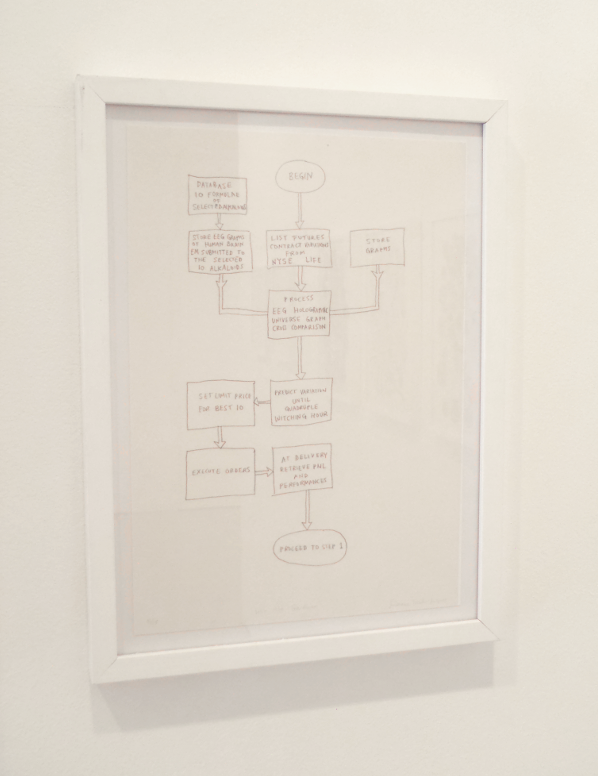
Not only are drawn diagrams and networks employed extensively throughout the exhibition in a number of ways but a network-like structure is also employed to arrange the artworks within the space of the gallery. Initially on entering the gallery space it seems as if artworks are arranged in no particular order. However it gradually becomes clear that this arrangement is purposefully obliging the visitor to enter into and move through the space as if it were a network; that is entering at any point and navigated in any order. While some series of artworks within HFT the Gardener, such as the Botanical prints, maintain an order to illustrate the ranking of companies employed in their creation, the majority of artworks are experienced out of the order they have been created and the documentary video about Traumberg, presumably from Treister’s perspective, is encountered at the midpoint of the exhibition. As such the artworks are presented as if they are interconnected nodes in a network.
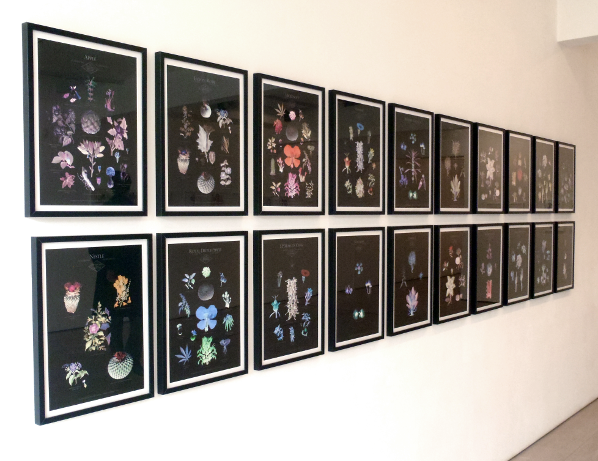
As a result of the diagrams, illustrations of networks, juxtaposed combinations of subject matter and a network-like structure in arranging the artworks within the exhibition Treister successfully manages to make one last combination of opposites, that of non-linearity of experience and linearity of narrative. In doing so the visitor experiences the juxtapositions, combinations and resulting networks formed by Traumberg’s hallucinatory non-linear associations and yet manages to steadily interpret the detailed narrative carefully constructed by the artist. It is in this last combination where the strength of Treister’s exhibition lies as it not only reflects society at large but also suggests that art is and perhaps always has been, a non-linear networked experience that is only now coming into its own.
An exhibition catalogue of HFT The Gardener is available through ISSUU (https://issuu.com/annelyjuda/docs/treister_cat) and a fully illustrated book of the same name is available from Black Dog Publishing, London.
HFT The Gardener will continue to tour throughout 2017 at the following venues. Please see the artist’s website for exhibition updates.
22/10/2016 – 05/03/2017
Selected works from HFT The Gardener exhibited in The World Without Us
Hartware MedienKunstVerein (HMKV),
Dortmund, Germany.
07/01/2017 – 18/02/2017
HFT The Gardener diagrams exhibited in Underlying system is not known
Western Exhibitions, Chicago, USA.
03/02/2017 – 05/03/2017
Selected works from HFT The Gardener exhibited in Alien Ecologies
Transmediale 2017
Haus der Kulturen der Welt, Berlin, Germany.
Featured image: Image from When Drones Fall From the Sky, by Craig Whitlock, Washington Post. [link]
At 0213 ZULU on the 2 March 2013, a Predator drone, tail number 04-3133, impacted the ground 7 nautical miles southwest of Kandahar Air Base, Afghanistan, and was destroyed with a loss valued at $4,688,557.[1]
On the 27th March 2007, a crashed spy plane was discovered by Yemeni military officials in the southern province of Hadramaut, along the country’s Arabian Sea coastline. The following day, Yemen’s state media identified the plane as being of Iranian origin, and that it was yet another example of an Iranian provocation at a time of high diplomatic tensions between the two countries. It was three years later, upon Wikileaks’ release of the so-called Cablegate archive, that a US Embassy cable revealed the “Iranian spy plane” was in fact a “Scan Eagle” drone. The drone was remotely piloted from the US Navy’s USS Ashland which was patrolling the Arabian Sea as part of an international counterterror task force. The United States Military was not “officially” conducting military operations in Yemeni territory at the time, and had not sought permission to conduct operations in the country’s airspace.
The discovery of the crashed drone could have posed a difficult political problem for the US to solve. However, in the cable, the official makes it clear that Yemen’s President Saleh had been keen to reach an agreeable deal with the Americans and apportion blame on a convenient third party — Iran. The cable states:
“He could have taken the opportunity to score political points by appearing tough in public against the United States, but chose instead to blame Iran. No doubt focused on the unrest in Saada and our support for the transfer of excess armored personnel carriers from neighboring countries (reftel), Saleh decided he would benefit more from painting Iran as the bad guy in this case.” [2]
By 2007, aside from occasional reporting in the media and among some activist circles, there was little public awareness of the US drone program. In fact, the program was not officially acknowledged on-the-record by a US government official until 2012. This official was John O. Brennan, then Counterterror Advisor to Barack Obama, and the momentous occasion was a speech at Washington DC’s Wilson Centre—a “key non-partisan policy forum for tackling global issues through independent research and open dialogue”.[3] Brennan states:
“So let me say it as simply as I can. Yes, in full accordance with the law—and in order to prevent terrorist attacks on the United States and to save American lives—the United States Government conducts targeted strikes against specific al-Qa’ida terrorists, sometimes using remotely piloted aircraft, often referred to publicly as drones.”[4]
While the use of unmanned aircraft in warfare goes back to the early 20th Century[5], the distinctive image of the drone has come to characterise the ambiguous geopolitics of The Global War on Terror. Their hubristic names—Reapers, Predators — evoke visions of carnivorous animals carefully and selectively stalking their prey. With their stealth and capacity to observe targets for hours on end before striking, the drone selectively adopts the tactics of the insurgency: it is an emergent weapon directed onto an emergent threat. Drones, like their intended targets, are not necessarily contained by borderlines, or to territories on which the US has declared war. They are in a suspended state of exception, and are decried both as being outright illegal by experts in international law, and simultaneously, as Brennan contests, strictly adherent to the doctrine of Just War.

In Brennan’s Wilson Centre speech, he draws on medical analogies to justify the “wisdom” of drone warfare, emphasising its “surgical precision—the ability, with laser-like focus, to eliminate the cancerous tumor called an al-Qa’ida terrorist while limiting damage to the tissue around it—that makes this counterterrorism tool so essential.”[6] But are drones as precise as Brennan’s rhetoric implies? Drones are often said to be heard, and not seen—their whirring noise inspiring local derisive colloquialisms[7]. But it is especially in the drone crash that the drone can be seen, and what’s more, subjected to inspection. It alerts us to a vital consideration: the failure of so-called precision military technology.

In IOCOSE‘s Drone Memorial, our attention is drawn to the fact that these complex systems are precarious, that the drone is indeed a fallible technology. The memorial, a sculpture of a fallen Predator drone driven into a copper plinth like a blade, subverts the surgical metaphor proposed by John O. Brennan. The drone’s mirrored surfaces create a fractured, tesselated reflection of its surroundings, its form almost vanishing in a specular camouflage. Inscribed on its wings are the memorial’s “fallen comrades”, the hundreds of other drones that have crashed, listed by location and date. This list can only be considered a selection, however, such is the secrecy around the use of drones in the War on Terror. As such, it should also be considered a monument to the journalists who manage to report on the discrete events of drone warfare in incredibly challenging circumstances.
A GPS beacon embedded in Drone Memorial broadcasts the location of the sculpture on the project website, hinting to us that this seemingly trivial technology in our smartphones has more nefarious uses. Global Positioning Systems have their roots in Cold War ballistics research, specifically in a program by DARPA codenamed TRANSIT, developed to direct the US Navy submarine missiles to “within tens of meters of a target”[8]. Today, GPS is one of many components in the assemblage of technologies used in the drone, and a key enabler of its apparent “precision”. Nevertheless, GPS can of course fail—it can be “jammed” inadvertently, or indeed tactically manipulated by malicious third parties. When the satellite link is lost with a drone, the aircraft goes into a holding pattern, flying autonomously until control is regained. In the Washington Post‘s story “When Drones Fall From the Sky”, they note that in order to keep its weight at a minimum there is little redundancy built into the drone’s on-board systems. Without backup power supplies, transponders and GPS links fail, and in several cases “drones simply disappeared and were never found.”[9]

IOCOSE’s positioning of the memorial as existing in a hypothetical, post-war scenario poses some interesting questions, but this temporal dissociation is perhaps unnecessary, for this is an issue very much of the present. It is certainly a topic more than worthy of critical investigation—the spectacle and the political consequences of failure have largely been left out of typical artistic engagement with drone warfare. In their press release accompanying the work[10], the artists suggest that the sculpture has an absurd quality. To me, it is not absurd as much as it works as an apt memorial to the violence of failure. In reading the long list of drone crash locations, the viewer might begin to probe the question of what information should be open to public scrutiny. IOCOSE pose the following question to us: “Does a drone crash count as a technological failure, or as a casualty?” This question would appear to have a clear answer: we must see the drone crash as a technological failure, so as not to make a false equivalence with the real casualties of drone warfare—the civilians who are subjected to it, the very same people who might also counter Brennan’s claims that the drone is a surgical, precise weapon of war.
Drone Memorial is the third work in a series titled In Times of Peace. This most recent work is the most astute in challenging the legally and ethically disruptive paradigm of drone warfare: it pierces the reflective rhetoric of US defense officials, and directs our attention to the high-stakes violence of its technological failure. The memorial, of course, ordinarily comes after the historical moment. This ‘moment’ is very much still unfolding 15 years later, and as the Trump administration takes form, it seems that the way in which drones will be deployed in the future is an ‘unknown unknown’. Thus, Drone Memorial is a temporal snapshot, an aesthetic pause on an ongoing, mutable war that seems to operate on a parallel continuum, only occasionally visible. More drones will continue to fail, as the drone war inevitably continues. These failures present a moment for critical analysis, a flash of visibility that should be seized upon.
Featured image: Pandora’s Dropbox by Matt Bower
The Disruption Network Lab (DNL) has been presenting in Berlin some of the finest platforms for the discussion of art, hacktivism and disruption, presenting academic debates on not-so-conventional forms of thought. In their event IGNORANCE: The Power of Non-Knowledge, the second in the series Art and Evidence, various scientists and researchers discussed ignorance, not merely as a subaltern issue but as a central tool in knowledge production.
In previous events, DNL debated how ignorance is deployed as a mechanism of truth and power negotiation, mainly through the omission of the known by the means of secrecy, obfuscation and military classification. There are many forms of understanding ignorance, and this program intended to elucidate the potentialities and pitfalls within the concept. According to DNL, the first step towards approaching ignorance is to recognise it and become aware of it. As co-curator of DNL Daniela Silvestrin said (despite the paradox) that it is necessary to render the “unknown unknown into a known unknown.” The field of ignorance studies investigates the spread of ignorance, what kind of forms it takes depending on the context, how science “converts” it into probabilistic calculations of risk, and even how it can be used to push certain political, economical or religious agendas.

In the opening keynote, Matthias Gross, a sociologist and science studies scholar who has written extensively on ignorance studies, co-editing with Linsey McGoey the “Handbook of Ignorance Studies,” starts by stating that “new knowledge always creates new ignorance” and that throughout history humans have been in constant relation – acceptance, denial, resignation – with the unknown. Gross has covered how ignorance operates in different scientific milieus, namely, how risk is widely used in natural sciences as an attempt to project an idea of the future, as demonstrated in weather forecasting, but also how not knowing operates in everyday life; through secrets, the spread of false knowledge, feigning ignorance, or even through actively not wanting to know.
Gross presented a compelling body of research, exposing numerous examples in which ignorance serves the purpose as a tool to acknowledge what we don’t know in science (important in fields such as Epidemiology) or how positions of power use ignorance to manipulate public opinion within our social structures. However, the debate felt somehow stranded in an optimistic loop, where ignorance was seen mostly as a catalyst to search for further knowledge. Yet, I believe, while duelling with the binary knowledge vs ignorance, one should never forget to tackle the universalistic shape that ‘knowledge’ tends to adopt. In the end, the discussion felt insufficient, failing to examine knowledge/ ignorance from a non-hegemonic perspective when it would have been interesting to borrow criticism from postcolonial or feminist thought.
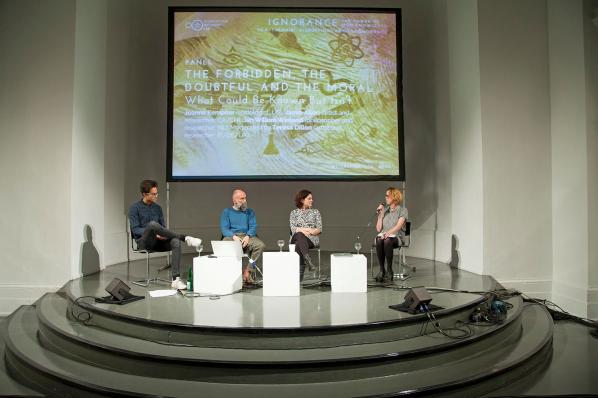
The first panel, moderated by Teresa Dillon, was deemed to shake the consensus in the room by joining the moralistic perspectives in science, the forbidden and undesired, the paranormal and the apocryphal together. Sociologist Joanna Kempner presented astonishing research focused on ‘negative knowledge,’ described as taboo, dangerous or threatening to the status quo. In an attempt to demystify the neutrality of knowledge production in sciences, Kempner interviewed various scientists to discover forbidden areas in their fields. The outcome of this research revealed that due to a fear of loss of funding and/ or sullying their reputation, scientists restrain themselves from researching illegitimate topics. For example, in Psychology one is expected not to study extra-sensory/ paranormal senses as these studies are usually associated to parasciences, a term that is in itself revealing of the hierarchies of knowledge. Kempner also exemplified how knowledge production is pressured by political interests and recalled the research-bans during the G.W.Bush government that cut funds to research related to sex and drugs under the assumption that remaining ignorant about any possible positive aspects (of recreational drug consumption) guarantees the maintenance of conservative moral values.
On the maintenance of moral values, the philosopher Jan Wieland presented an interesting experiment: “What would you do if you wouldn’t know? And what would you do if you’d know?” Giving the example of a social experiment by Fashion Revolution, a movement that calls for “greater transparency in the fashion industry”, Wieland examined consumers’ choices as they acknowledged the conditions in which clothing is actually produced. The project invokes a sentimental story with an excerpt from the daily life of a young girl living in Dhaka, Bangladesh, who works in a garment factory. Coming to terms with the girl’s story, the reactions differed — from not buying and empathically connecting with her situation to total indifference and still buying. Wieland attempts to analytically evaluate their intentions, good or bad, and how ignorance affects choices, stating that some of us might willfully remain ignorant (willful ignorance) as a way to better cope with our habits of consumption. However, I find it difficult to extrapolate these findings to a moralistic and individualistic criticism of people’s consumerist choices, since we know there is a structure that keeps consumers far from well-informed. A good example of how economy capitalises on ignorance, we know that the international division of labour is intentionally built to alienate the consumers from the “dirty” phases of production.

Jamie Allen, artist and researcher, also analyses at the economy of non-knowledge that is in the genesis of apocryphal technologies. “Do pedestrian’s crossroads’ buttons actually work?” We have all thought about this, yet has it stopped us from pressing the buttons? As long as we do not know whether a certain technology actually works, it “works”. Such an economy is boosted by acknowledging that some things remain as common ignorance. If we are not sure whether a lie detector works or not, then it can be used to incriminate — amidst ignorance, it shall produce the truth.

Informative and somewhat frightening, “Merchants of Doubt”, directed by Robert Kenner (2014), reveals how bendable ‘truth’ is in the interests of big corporations. The documentary investigates how the tobacco industry spread false information among firefighters, leading the world to believe that the domestic fires caused by cigarettes were the fault of the furniture rather than the cigarettes. This is where it goes from uncannily funny to scary. While interviewing scientists, whistleblowers and activists, the film unveils the dreadful story of corporate campaigns designed to unleash confusion and scientific scepticism among the masses, putting the life and security of millions at stake. This scepticism is not passive, thus it turns into a cynical endeavour. As corporations claim that there is no consensus surrounding issues such as global warming, conferences and books are forged to sustain their statement, while scientists who defend the existence of greenhouse gases are accused of ceding to their political biases in order to get funding for their research. What about facts? They seem to become irrelevant in the face of expensive lies.
Watch Merchants of Doubt’s trailer here.

Karen Douglas, a social psychologist, presented an empirical study of conspiracy theories whilst trying to trace a particular psychological profile of those more prone to elaborate and believe in them. Douglas used widely known conspiracy theories as examples, such as the infamous car crash that killed Princess Diana (which became a true “Schrödinger’s cat” case, instigated by the media-produced hyperreality in which Diana was both alive and dead — along with Elvis Presley) and the theory that 9/11 was orchestrated by the United States government to instigate and justify the “war on terror”. Douglas believes we are naturally hardwired to believe in conspiracy theories and sees them as a way to cope with things we are unable to answer. A socio-analytical view on conspiracy theories also seems to fail the complexity of forces that make us consider why certain theories are conspiracies and other perspectives are just theories. The issue with Douglas’ approach lies within its socio-psychological analysis, which tries to find a pathological pattern in people who believe in conspiracy theories, such as describing these people as being intentionally biased, or stating that those who tend to perceive patterns in things or believe in more than one conspiracy theory all show the “symptoms” of a conspiracy theorist. Yet, as pointed out by a member of the audience, this approach seems to lack a sensibility to the entire concept of “conspiracy theory” as a political tool to dismiss and undermine other narratives, such as narratives from an undesired other (e.g. how Russia’s government agenda is seen by the USA). Nevertheless, it is interesting to understand how these bodies of “disbelief”, should you wish to call them conspiracy theories or not, have a huge impact on our lives and inevitably our deaths (e.g. global warming, vaccination). As with apocryphal technologies, certain forms of unknown seem to crystallise as forms of knowledge – we know that we do not know and that is the way it is.
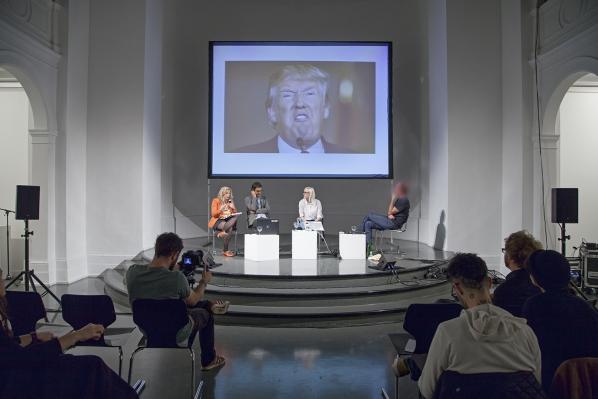
The closing panel, moderated by Tatiana Bazzichelli, has overseen our entanglement on social media and its algorithms, promising to be oracles of truth while their complex structures grow beyond our understanding. Ippolita, a group of activists and writers, warned how social media promotes emotional pornography, where our feelings are exploited by click baits in exchange for our personal data. By establishing clear metrics of interaction, like the number of likes and comments, social media creates an addictive game of forged interactivity, while we are scrutinised by biometric evaluation resultant from the same data we produce. Also analysing the manipulation of data and its weight in political agendas, Hannah Parkison, a journalist focused on digital culture, analysed Trump’s run for presidency propaganda in digital media. By using mostly social networks, such as Facebook and Twitter, Trump has kept control of his narrative without entering into risky interviews broadcast on TV. This is an effective way to get away with lies, regardless of the constant warnings from fact checkers – according to Politict 78% of what Trump said on the run for the election is not factually true. These lies spread across the internet, rendering their own truth.
Vladan Joler, chair of New Media Department at the University of Novi Sad, presented his project in which he tries to map the tentacular structure of the Facebook algorithm, an expansive database incorporating individuals’ personal information that implies the fabrication of assumptions about potential consumers’ habits, wants and needs. Facebook was thus framed as an immaterial factory of information, the functioning of its assembly line still unknown, constantly mutating and growing. A speculative visual image of Facebook’s processes was rendered as Vladan tried to map something unknown; this mapping has similarities to the work of early cartographers. And much like early anthropological stances, the nodes of information produced have the potential to define thoughts and discussions about what we are and how we are supposed to behave. As Vladan ironically concluded, these are the tools used by the cybernet dominators – the digital monarchies that will accentuate asymmetries.
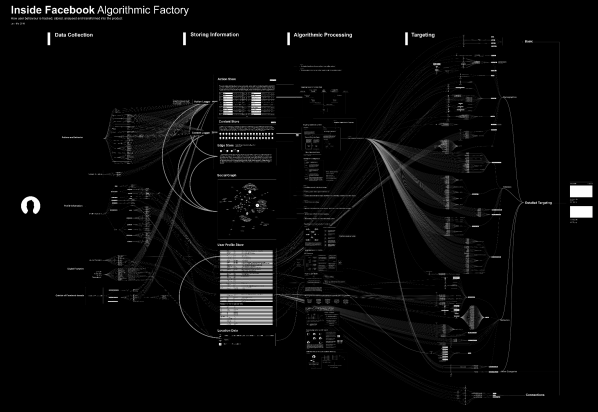
Ideas such as ‘knowledge’ find resistance and defiance from other epistemes that fall out from the western-centric productions of knowledge, such as the Amerindian ‘perspectivism’ defended by Viveiros de Castro or even the Alien phenomenologies (see Ian Bogost) that instigate the thought of non-anthropocentric ontologies. Bearing those in mind, I found that talking about the ‘dark’ side of knowledge is an invitation to dismantle and boycott its mechanisms of production, sustained in frail ideas of “truth”, “reality”, or “science”. In addition to the initial concept of ignorance, the conference provided a fertile ground for questioning the multiple ways in which humans deal with intangible phenomena, try to bypass obscurity and profit from that same obscurity. It provided insight on the relevance of knowledge to map and create reality, while bodies of power render webs of mystification of the tangible – corporations forging lies, politics of manipulation, cultural colonisation – reproducing ad nauseam epistemic violence.
The third edition of the Art and Evidence series from Disruption Network Lab, which took place on the 25th and 26th of November, wrapped up with the event TRUTH-TELLERS: The Impact of Speaking Out. TRUTH-TELLERS asks a question that could not be more crucial at the moment: “Can we trust the sources and can the sources trust us?” We have recently experienced a presidential battle between Clinton and Trump in which one of the most divisive topics were the thousands of emails sent to and from Hillary Clinton’s private email server while she was Secretary of State. A battle from which Trump left victorious despite having failed almost every fact-checking test. While Assange is forbidden to use the Internet for fear of him interfering with the presidential run in the USA, Chelsea Manning remains convicted, sentenced to 35 years of imprisonment due to her 2013 accusations of violating the Espionage Act. DNL gathered hacktivists, privacy advocates, investigative journalists, artists and researchers to “reflect on the consequences of leaking and whistleblowing from a political, cultural and technological perspective”. Unfortunately, due to a lack of funding, this could have been the very last DNL event. Let’s hope not, as these are vital, particularly in times of political despair.
Feature image: Still from Dreams Rewired: original source Das Auge der Welt (Germany 1935); dir: C. Hartmann
Dreams Rewired / Mobilisierung der Träume – Trailer from Amour Fou on Vimeo.
The 2015 film Dreams Rewired, recently shown at the Watermans Digital Weekender in London on 12-13 November, will be screened again at Watermans on 3 December. Directed by Manu Luksch, Martin Reinhardt and Thomas Tode, the film has the tagline ‘Every age thinks it’s the modern age’. It looks back to the early 20th Century, to the development and implementation (first locally, then globally) of the telephone, the radio and television.
The makers of Dreams Rewired unearthed and arranged early film recordings and brought them into the 21st century context. This was done via a playful narrative written by Manu Luksch and Mukul Patel and read by Tilda Swinton. The tagline was well chosen; almost everything Swinton says would have been relevant at almost any point within the last century. Time periods, machineries and political movements are connected in clever and unexpected ways, meaning that Dreams Rewired, a durational video whose narrative follows a recognisable storytelling structure, makes numerous links between times, places and people, which branch off from the safety of its linear structure.
Dreams Rewired is something of a treasure trove, not only for the glimpses its found-footage building-blocks gives into a past era but also because of the inter-generational, inter-national, inter-thematic connections it makes. Frequently while watching the film I felt the urge to burrow into an investigation of one of the clips, stories or introduced contexts. To emulate this ‘tip of the iceberg’ effect, this review will pull words directly from the film, linking quotations to some of the themes which appear and reappear throughout.
“A new electric intimacy”
With new media come new practices of communication. One of the recurring themes described in Dreams Rewired is the coupling of intimacy and invasion of privacy introduced to society along with a new communication method. Just as a new invention is prototyped, its social implementation causes new prototypical behaviours – new ways of caring, new ways of injuring, new comings-together, new separations. Uncertainty is inherent to experimentation.
“The waves travel at the speed of light, defining what simultaneous means. Information can travel no faster.”
When something is newly possible it also newly achievable – new precedents are set and new avenues opened for exploration. There is a flurry of activity, a rapid diversification. For those looking to gain or retain power over others, this is a problem; diversity requires more effort to manage. Initial flurries of activity are curtailed by the introduction of rules, the setting of precedents.
This limitation sets new targets to meet, new challenges to overcome. The cycle starts again as those in power look for ways to consolidate it while those without look to gain what they can. This is a simplistic, but not inaccurate, description of the machinery of the capitalist world.
This cycle of diversification and restriction is always coupled with the establishment and transcendence of thresholds. Experimentation with a new technology reveals some of its limits. (Side note – of course, what is understood as a limit is defined by wider cultural contexts.) “Information can travel no faster” is a provocation to speed up.
“Geography is history”
New advances cause conceptual shifts. Early telephony and television shrunk the gap in time between a thought or plan and its activation. Understandings of time and geography changed, and it became possible to move into new spaces and in new ways at socially impressive speeds. New powers, in short, were available to those who knew how to access them, to those who understood the preceding context well.
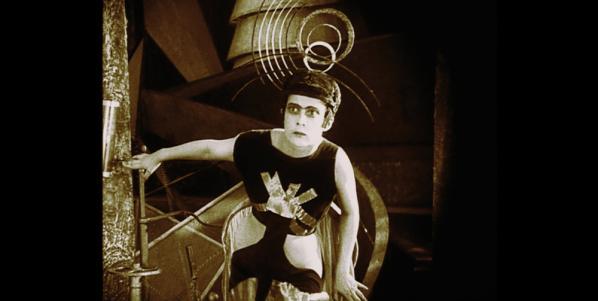
“A model of the new human is put into circulation”
A network grows, its complexity and partner processes intensifying. The machinery of daily life is altered, and daily life is a testing ground. Social interactions change as the new set of behaviours required to work the new machinery collide with existing social norms and rituals. New jobs and new workplace structures appear and people previously without responsibility or power find themselves in contact with it (though they may not understand the possibilities at first). People are no longer the same beings as before. Cycles of experimentation and consolidation reach into the body.
“Someone will have to lift us up. But who will lift them up?”
The flurry of excitement surrounding a new invention is based on the idea that ‘our’ lives will be improved, that ‘we’ will be able to do, see, have more. There is a problem here. The words ‘we’ and ‘us’ are too abstract – they bracket whoever the speaker wants them to bracket and recapitulate the prejudices they have. Anyone who is not included as part of the ‘we’ simply does not exist. This is convenient for the ‘us’ – while ‘we’ rush excitedly towards a future in which we have more and better, what ‘they’ do is of little concern. The ‘us’ does not care – or even think much – about the ‘them’. The ‘us’ cannot understand why the ‘them’ has not joined the ‘us’. After all, the ‘us’ is at a new threshold – who would not want to reach the other side?
“Personal profiles, passwords, biometrics..fully documented. Every trace filed. Bigger data, better analytics. Opt out, and we lose our place in the world. So…we share the keys to our desire, our habits, to ourselves.”
To be part of the ‘us’ and the ‘we’ requires effort. To ‘opt in’ requires sacrifice. At the same time, ‘opting in’ is the easiest thing in the world when ‘opting out’ means facing a void. Advice on how to do well, how to achieve, how to be healthy is easy to come by, but there is little guidance for those who find themselves, or wish themselves, outside the mainframe. Losing one’s place in the world means losing access to that mainframe and the stability that comes with a highly legible structure. Today the legible structure is far-reaching and well established, to the extent that opting out is dealt with violently. The new models of human coming into circulation have trouble recognising the old. There is a mutual rejection.

“Government regulation stifles amateur culture – military and commercial interests occupy most of the spectrum … transmission becomes a privilege, not a right”
As I wrote earlier, the ‘us’ and ‘them’ structure is too simple. It would be more accurate to think of people as communicating on multiple frequencies. The machinery of society is complicated to say the least, and made more so by the mainframe, which amplifies transmissions at some frequencies while restricting others. In the early 20th Century, multiple obscure radio channels were repressed, responsibility placed with public backlash following rumours that amateur radio was responsible for the sinking of the Titanic. Side questions: where did the rumours come from? What were they based on? How was the public response measured?
“For the first time he hears himself as others do. A voice absolutely familiar but estranged…But her power also grows: by controlling his voice she controls her time”
There is a strange relationship between the controller and the controlled. For every CEO there is a team whose own agenda seeps into the workings of the company. Dislocated power and fragmented or unplaceable identity are some of the symptoms of a complex system undergoing change. When a system is so complex as to involve multiple timescales, spaces, materials and structures, it is impossible to predict the future.
—
Dreams Rewired is part of the Technology is Not Neutral Symposium
3 December 2016
Watermans, London
https://www.watermans.org.uk/events/technology-is-not-neutral-symposium/
Two years after his death, Harun Farocki continues to maintain an archetypal role in the world of the visual arts. Many mourned for the loss of a gifted artist who was as not just a filmmaker but a critic, activist and philosopher en masse. Farocki succeeded his German New Wave filmic predecessors as his work would seamlessly and at once command hilarity, disparagement and intellect. A project-retrospective collaboration of his work was undertaken, just two years after his death, with its first part at The Institut Valencià d’Art Modern (IVAM) named ‘What is at Stake’, and more recently the second-part titled ‘Empathy’at the Fundació Antoni Tàpies compiled of at least 8 works focusing on an analysis of labour within the framework of capitalist demands.
The title of the exhibition, ‘Empathy’ originates from Ancient Greek; ‘εμπάθεια’ is a compound of ‘έν’ and ‘πάθος’ meaning ‘moved by passion’. In German, empathy translates to ‘Einfühlung’ and was ironically exploited by Farocki in 2008 as the title for his text and reads:
‘A compound of Eindringen (to penetrate) and Mitfühlen (to sympathize). Somewhat forceful sympathy. It should be possible to empathize in such a way that is produces the effect of alienation.’
Taking into account Farocki’s liking of Brechtian ‘distanciation’, he formulated rather quickly that to ‘empathise’ means to project one’s own feelings, therefore infiltrating objective opinion. The notion of ‘empathy’ for Farocki was carefully tailored to a synthesis that gave him the patience to be simultaneaously attentive and austere towards his subjects’ predicaments. As paradoxical as it may seem, empathy and distance are nurtured companions. With Farocki’s interpretation of empathy in mind, I entered the dark bunker where the retrospective took place. A space usually leaking brightness from the glass roof was now transformed into an industrious zone of projections, obsolete TV sets and the mellifluous humming of those operative machines. Farocki’s filmic oeuvre overflowed from devices onto white surfaces, accentuating the techno-capitalistic condition of labour operating eradically for our Western communities.
As you enter, the video-installation of Workers Leaving the Factory in Eleven Decades (2006) dominates the center. Twelve TV monitors are laid out in a horizontal line, juxtaposing chronologically the moment where the worker leaves the factory in Farocki’s twelve chosen films – among them, Workers Leaving the Lumiére Factory in Lyon (1895), Deserto Rosso (1964) and Dancer in the Dark (2000). Here, the excerpts are used as a mnemonic tool as Farocki’s montage gravitates around the entrance of each factory. Each scene extrapolates the repetition of entering as a rhetorical techne, an emphatic mimesis of organising and preserving power through the image of the factory and its systems of subjugation. Yet, distance and empathy are circular and procedural.
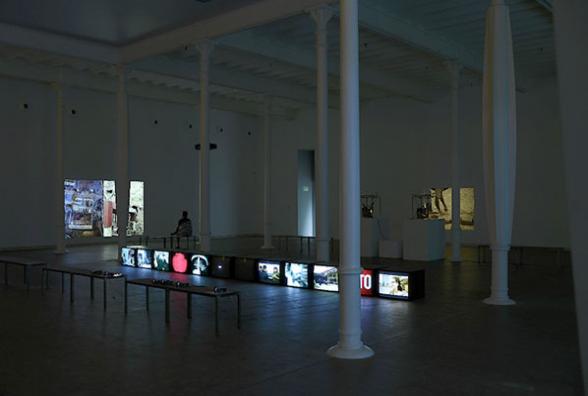
Curated to encourage a clockwise movement following the introductory piece, A New Product (2012) is being televised to the left. It commences during a mundane corporate board meeting for a consulting company violently regurgitating neoliberal logic. The goal of the meeting is to amplify competition and ascertain efficiency of their employees in the workplace by creation of a new product. Through the repetitive flipping of charts and reports, Farocki succeeds in capturing the vocabulary of rationalisation regarding their employees’ assets while unfolding the dynamics of the team and its public presentation. The narrative’s structure being static and unobtrusive, in conjunction with the ascetic use of the camera implies a degree of distancing from the subject. Still, the absence of Farocki’s own evaluation additionally contains the capability to bolster the viewer’s assessment of the situation thus achieving the artist’s desired equilibrium between empathy and distancing.
There existed a sense of rituality by which the projections were transmuted from a seemingly simple and observational nature, to one which was filled with the allegory of transparency and distance. Re-pouring (2010) was an ode to Tomas Scmidt’s Cycle for Water Buckets (or Bottles) from 1959. The original piece was a carefully choreographed mise-en-scene by which Scmidt poured one glass, a bottle of bucket of water into another. The act of pouring for Schmidt was one which indicated a simple and natural process of vaporisation with each pouring. Farocki had programmed machines to perform the artistic gesture for him, a re-pouring of the performative fluxus notion. A paradoxical act, since as human beings our navigational processes depend heavily on our cognitive ability, the mechanical hands were able to seamlessly perform the act of re-pouring. Farocki’s hyperrealism allows him to jump to a certain scale of futurity whilst also being rigorous of scrutinizing reality. The act of programming robots to perform a ritualistic and performative task goes undoubtebly implies distancing from the artistic practice of Fluxus. The Fluxus movement was predominantly a practice governed by experimental notions of performativity which were heavily conceptual. It therefore comes into stark contrast to the idea that such act could be thought by algorithm machines as notions of ‘thinking/feeling machines’ in contemporary society are rudimental and dreams of a future imagination. Farocki, able to perform the task himself such as with Indistinguishable Fire, does not. He steps out, physically distances himself from undertaking the task himself but maintains his empathy to former Fluxus activities but also expressing a empathy towards machines who today perform most human labour.
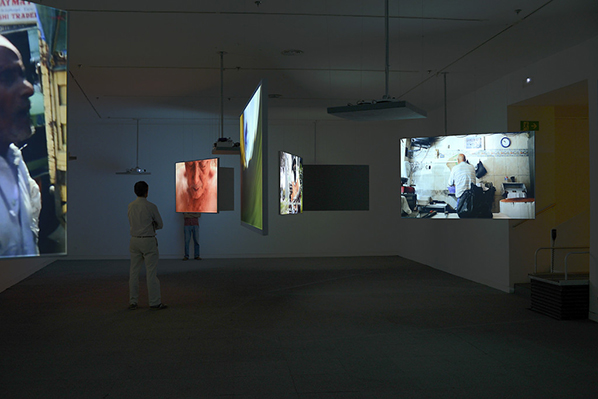
Amidst one of the spectacular accummulations of Farocki’s body of work, the apogee of the retrospective would be Labour in a Single Shot, shown for the first time in Spain. The project was initiated in 2011 by Harun Farocki and Antje Ehmann, co-curator of the retrospective. Located in an entirely different bunker, the work was compiled from a series of workshops whereby a fixed camera filmed paid, unpaid, material and immaterial labour from fifteen workshop locations. Projection screens are hanged in a room, most facing eachother whilst the noise of all labour taking place floods the space. Harmonious parallels are created as sequences from butcher shops and surgeries face eachother. The repetitive looping and sequencing of labour is used as a means of distancing and signifies non-judgmental watching as an active practice of iconic power. Our lasting impression is a call-girl sucking on a lollipop explaining how her artifice encourages clients into believing the gratification she provides is sincere. Here, we understand that just as she, through sex, retains empathy and distance in unison, Farocki’s empathy can thrive.
Featured image: The Refusal of Time, film still, courtesy William Kentridge, Marian Goodman Gallery, Goodman Gallery and Lia Rumma Gallery
There is a show of art by W K now in town. My friend, if you see but one show of art works this year or the next one or yet the next I beg of you see this one. The world of these works is both our world and not our world. The world of these works is thick and dense with rune and script and sign and light. And do you know the show is called THICK TIME and this seems as they say bang on for there is a sense in which the world and all that we are in it is here boiled down is made dense or thick. And it flows in front of us and we can see in what way and where from and where to it flows. Rune and script and sign and glyph and folk and things are drawn with ink or shown with torn or cut up scraps or light yes light much of it. And since light then dark too. Yes dark. This world flows yes and this world jumps and swells and shakes too.
And song and sound. There is song and there is sound of all kinds. There is a drum a big loud drum and a thing which marks time tick tock tick tock. There are sweet sounds and harsh sounds too. There is song. And there is change. Things change this way and that. This world will fill you with joy and at times it might make you sick at heart. It will make your head ache and pulse and spin. You might need to close your eyes. This world will speed your pulse and make you sweat. You start to dance when you see this world. You might smile. You might cry. You might have as they say a lump in your throat. W. K sees the world as we see it and knows our world as we know it and sees a world that we don’t see and we don’t know and shows it to us and now we think why did we not know this world it was there in front of us all that time.
Please note W K makes stuff with his hands. That is what he does and then he makes the stuff move. He makes things come and he makes things go and he makes things flow or stay still, he makes a world but he is not a God. He makes art. This is art. If you say to me what is art I would say art is a thing like this. The best of art is a thing like this. This is rich. This is not poor thin soup but a meal we can feast on for a long time and then come back for more. (And when we come back we will find things we did not see or taste the first time!)
He is like us and in this lies his strength. And I think he likes us and in this too lies his strength. Oh and did I say he does tricks with chairs.
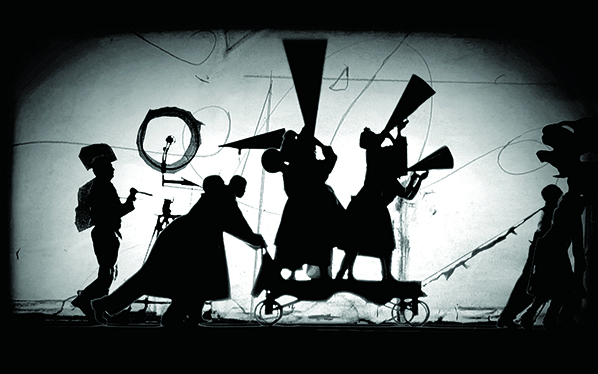
I will tell you more. Let us as they say zoom in. In the first room is a pair of lungs or things that stand for lungs. Things made of wood and nail and screw and cloth which go back and forth as if they pump and move the air. And there are screens and on the screens is light and dark. Folk walk and dance. W K too is on the screens. He does tricks with chairs (and hats too) and he walks. I think I saw once he had a stick but I might be wrong. Once he bore a young girl round his neck and walked with her on the screen. He looks you might say sad but no more as if he is in deep thought. He looks at the world. And there are such sounds now here now there it is like a spell. It is a sweet pain. And there is print and type—there are words and there are sums. Now there now crossed out now smudged now clear to read but hard to grasp what it all means.
What does ‘means’ mean? What does it mean to say art, or a work of art, means? Hmm. Though not hard for sure to feel. Not thoughts but a way to feel. The strange words and the maths make you feel. The words and the dance and what you see on the screens make you sad and glad too (and your heart beats fast). And there are folk who come and go in a long line like in a march they come and go. They come in one end and walk and dance and march and then they go out. And you smile and you think hard and you see them there and then you are there and you are them. Oh a dream of life. Oh a real hard life. Oh a life of hard dream. All pass us by. King and queen and poor and knave and prince and thief and saint and the well and the sick those who live and those who will all too soon die and those who have died they pass by us, and show us the way things are and the way things might be, both the best and the worst of it. There is filth and dirt and there is joy and a bright light and there is dark and there is space. Look! It goes on and on dark and dark. The man ails—the girl does a dance. The man jigs a jig—the girl is sick. The bird flies. The old man lives—the young girl dies. A man is in a fat suit. He looks like a great white pea. She plays a tune on a thing of brass. The clock ticks. And ticks. Oh look now there is a flash. A flash of light. It is so bright. There is death. There is an end. But look now things flow once more. There is life. Here is a new start.
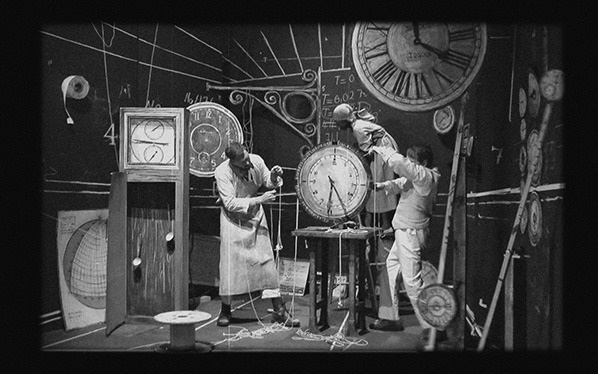
Things in a row. Things put in a row in a space, the right space. A space on a wall a space in a screen a screen in a space a space in a space. A gap. A pause. To look at— to put in the right space since this will help to make us feel and see what it might be like to be one who is not us.
I want to say W K is not cool. He dares much and this can make him trip and fall. (One piece I will not say which is not as good as the rest. What do you think?) He might fall on his face. At times he lacks grace. But so do we all. He does not fear this fact and this gives him strength. He does not seem to fear what folk might think. I like this. I do not like cool. I do not care for when art folk act as if they do not feel or they do not fear or hurt or love. As if this is not the stuff of our short life. And I do not like it when they claim this lack is good that to not feel is for them some sort of good thing.
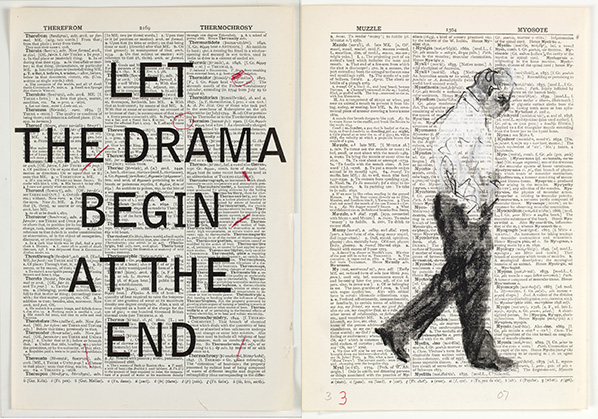
There are six rooms in all I think and all will make you feel and make you think new thoughts and a warm shock will run down your spine now and then in all those rooms. (One just one is not so good I think. Which one do you think it might be?)
There comes a point where words cease to be of help. Where they lose their point or at least their edge. For just think if we could gloss the whole of a work of art why would she or he who made it want to make it—the art ? There comes a point where words must stop where we must look and feel and not say. And if we know when to stop it seems to me we are wise and we know how to live. And in a way I think this work might help us to know how to live.
Michael Szpakowski October 2016
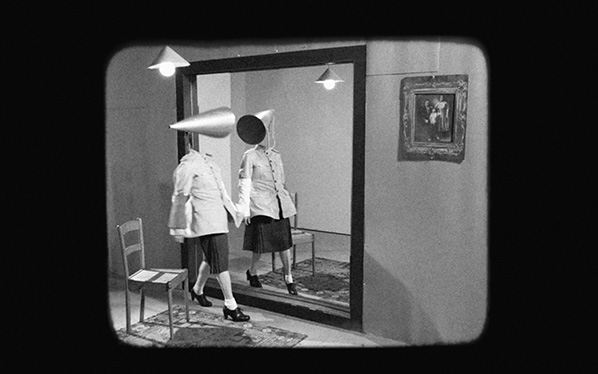
A Book Review for Benjamin Peters’ How Not to Network a Nation: The Uneasy History of the Soviet Internet, The MITPress, 2016
“At the philosophical scale, the abundance of information and the plurality of worldviews now accessible to us through the internet is not producing a coherent consensus reality, but one riven by fundamentalist insistence on simplistic narratives, conspiracy theories, and post-factual politics. We do not seem to be able to exist within the shifting grey zone revealed to us by our increasingly ubiquitous information technologies, and instead resort to desperate modification strategies, bombarding it from the air with images and opinions in order to disperse and clarify it. It’s not working.” -James Bridle [1]
In Benjamin Peters’ “How not to Network a Nation” we learn that the USSR had the engineers with the technical knowhow and capacity to construct national computer networks of scale. Indeed, the Soviet military had such a network already in the 60s, but the question Peters wants to ask is why the USSR did not develop a ‘civilian’ computer network akin to the Internet we know and love today. The USSR did not develop a ‘civilian computer network’ because there was officially no part of the society which was independent of the state. Also, by the time anything approximating what we call the Internet began to emerge in the US, the USSR was already deep in decline. Thus, Peters’ question is moot and he only finds what is obvious from the beginning: that the social system of the USSR was incompatible with the liberal information-sphere of the capitalist West.
The book, though, should be praised for opening up and translating to English various documents, not yet available, which describe the work of early Soviet cyberneticists, and for mapping the institutional vicissitudes of the USSR at the time. We learn, for instance, about the brilliant cyberneticists Anatoly Kitov and Viktor Glushkov and their travails attempting to gather institutional support for a national civilian computer network in the USSR. Glushkov’s atrophied OGAS project forms the central narrative of the book, a project for an Inter-network of computers proposed years before Vint Cerf coined the term Internet in 1972. However, rather than appreciating the precocious cybernetic accomplishments of early Soviet theory, Peters blandly uses the “failure” of the OGAS to argue that the USSR was too perversely corrupt and bureaucratic to let progress take its course.
“Because the OGAS threatened to reorganize the social and economic spheres of life into the kind of national planned system that the command economy imagined itself to be in principle, it threatened the very practice of Soviet economic life: in [Eric P.] Hoffman’s analysis, “creates more choice and accountability and threatens firmly established formal and informal bases of power throughout the entrenched bureaucracies” [2]
Interdisciplinary historical studies of the academic, philosophical life of the USSR in English are sorely needed. Peters is sadly not sufficiently technically competent to give the reader any substantial insight into the structural concepts or proposals of the early USSR cyberneticists. It is certainly not clear from the information in the book whether any of the proposals would have produced anything akin to the Internet. In order to compensate for inadequate knowledge of political economy Peters sadly defaults to half-hearted liberal reproaches.
“Glushkov’s vision directly opposed the informal economy of mutual favours that oiled the corroded gears of Soviet production. In the end, the OGAS Project fell short because, by committing to rationalize and reform the heterarchical mess that was the command economy in practice, it promised to encourage the rational resolution of informal conflicts of interest — which worked against the instinct to preserve the personal power of almost every actor that it sought to network.”[3]
For readers interested in how the various prototype networks in the USSR (the OGAS, ESS and EASU) technically actually worked, anything about the USSR military computer network (analogous to ARPANET), how USSR computer industry differed from that of the capitalist countries, o how USSR computer theory differed from that of the capitalist countries, the book experience will be disappointing; it has too little of this. What’s really lacking is a strong attachment to the subject, the meat and bones of the OGAS, its material scale, how the projects actually ran, on a daily basis. Peters’ seems more passionately concerned with reasserting that capitalism is better than socialism because it produced the Internet.
Peters’ thesis is specious: “The first global civilian networks (sic) developed among cooperative capitalists, not among competitive socialists. The capitalists behaved like socialists, and the socialists behaved like capitalists. “ [4] The capitalists in this formulation are merely individualists, who, to Peters’ mind, surprisingly cooperated to build the network. The socialists, in his formulation, are altruists who couldn’t live up to their principles, competing with each other for resources like professors in a badly run faculty. Peters unfortunately appears not sufficiently interested in either socialism or capitalism to nuance these historically heavily-laden terms.
The utopian project, imagined by the Soviet cyberneticists for the USSR and exemplified in the Cybersyn project in Chile, was that a socialist society could manage the entirety of national production distribution and disposal more efficiently and effectively through an internally transparent communication system. Cybersyn was, however, no prototypical Internet. Such a network as Cybersyn would also likely have to be highly secure (since national security would depend on it) and the data exchanged there only selectively available to an exclusive few. Thus, such a system would not likely have produced the vibrant media environment of the Internet we know today.
Peters does not technically imagine how such alternative forms of networked computation might work. Instead he consistently returns to the vague claim that the USSR was too ideologically conflicted, flawed and corrupt to allow the flourishing of the genius of figures like Glushkov to permit the panacea of an Internet-like network to be developed there. “The history of the OGAS project is akin to the history of a miscarried effort to perform an IT upgrade for the corrupt corporation that was the USSR itself.” [5] And cloaks his disparaging attitude in befuddling doubletalk. “The Soviet network projects did not fail because they did not possess the engines of a particular Western political or technological values. They broke down for their own reasons.” [6]
What reasons? They broke down because there could be no Internet in the Soviet Union.
The book points out that the difference that created the conditions for the development of a civilian network such as the Internet was the fact that the US had a private sector which could fund research and production independent of central governmental approval. Curiously, Peters’ gives the example of Paul Baran, inventor of the packet-switching technology essential for the Internet as we know it today, who, seeing his projects disregarded by the priorities of the military industrial complex at the time, eventually abandoned it, only to see it implemented in the US after the British Post system’s research generated the same idea. Here we have two “socialist” government-funded communication projects in “capitalist” competition, apparently the secret to the technical success of the Internet.
A Soviet civilian network, equivalent to that of the nascent Internet in the US, would have meant a network of scientific/academic institutions working outside the classified military information-sphere. There was no such “civilian” sphere. What Peters shows instead is that many of the efforts to implement a national computer network outside of the military were reformist, intending to ‘liberalize’ the Soviet economy and make it more compatible with the capitalist West. “Most of the new employees [of Glushkov’s state-of-the-art cybernetics institute CEMI] were young researchers with bold ambitions and a distaste for the culture of totalitarian control in the 1940s and 1950s. Enthusiasm for decentralized economic reform met with central flows of funding”. [7] Glushkov’s senior ally in the bureaucracy Vasily Nemchinov “sought to impose ‘economic cybernetics’ and its plausibly nonsocialist “dynamic models of balancing capital investment” in the ideologically most acceptable light”. [8]
Peters points out that the USSR’s ideals of social egalitarianism were superimposed on a society which was not used to such a distribution. It is often argued, that, unlike Germany (which Marx & Engels had in mind when they wrote their Manifesto) pre-industrial Russia was lacking the institutional, industrial and economic basis for socialism. The result was that the highly abstract egalitarianism of socialism clashed with the conditions on the ground there, and generated more contradiction, inefficiencies and strife.
The promise of socialism, though it is unprecedented, is that a fairer juster society for every inhabitant of the earth can be achieved. The contradictions between the ideal and the reality need to be allowed to run their course, but this time was not afforded the USSR, as it was not afforded Chile, Cuba, Venezuela, Congo or any other nation which have dared strive for an egalitarian society. Lenin, Allende, Castro, Chavez, Lumumba came to power through popular and democratic processes but were attacked mercilessly, undermined, even assassinated by intolerant reactionary alliances from without and within. Remember that minerals from the de-liberated Congo [9], fundamental to networked computing today, are extracted under the most extreme injustice and exploitative coercion.
Peters claims the the US “succeeded in “networking a nation” because its ethos is to ask “how“ rather than “why”, and that the USSR failed because they were too concerned with “why.” The inertia of systemic unfairness socialism has to confront is immense, and, since it must deliver on its promise to improve the living conditions of the great majority, it is understandable that considerations of “why” will slow down technological choices on a national or global scale. The US and Western economies under their influence had much less of such moral compunctions. Capitalism “frees” entrepreneurs to scale ideas up to industrial scale and ‘externalises’ any deleterious consequences. Today in the age of automated techno-industrial-powered environmental degradation, resource wars and climate change, it appears far too late anymore to ask “why.” Networked capitalism has long had the answer to “how”, though: more computers.
It seems Peters wants to say with this book that socialism can be good as long as it takes place within capitalism. But since Peters’ conflates capitalism with individualism he does not see that this would mean socialist practices merely serving their conventional function as unquantified subordinate contributions to rationalizing capitalist exploitation. When Peters writes that the US built the Internet because their capitalists behaved like socialists, he is merely indicating that socialist practices are a well-spring of the value extracted by capital. Marianna Mazzucato argues convincingly how public investment in fundamental education, technologies and infrastructure brought about the great prosperity (such that it is) and unprecedented cultural affordances such was we enjoy through the Internet. [10] Socialists build things for use value, capitalists build things for surplus value. The huge edifice of Internet-based and coordinated commerce is build on functionalities built in the public interest, not to mention the house of cards ponzi scheme of contemporary financialized capital. The grand juggernaut of US capitalism is still running on infrastructure built during its brief social democratic experiment in the 1950s, which itself was a concession to labour in order to ward off nascent communism at home.
Jeremy Corbyn aims to produce a surge of public investment in vital infrastructure, which, in the proceeding decades it can be assumed, will be reappropriated piece by piece by capital. Public spending on public services do not produce merely quantifiable benefits for “stakeholders”; they produce qualitative improvements which cannot be reduced to commodities, and therefore do not require computer networks to manage or employ, but on which we nevertheless all depend for our social lives.
It is fashionable today to envisage that we are heading, or should head towards a sort of “Fully Automated Luxury Communism” (FALC), where an Internet of Things, transparently managed through a hive-mind, public-access liquid-democracy interface, a civic HyperCyberSyn, will provide unprecedented industrial efficiency and irrepressible prosperity, automatically for all. History shows however that such a system would be set upon and usurped by powerful alliances, just as has every technology in the history of humanity, for the benefit of the few and the detriment of the many. In the meantime, instead of FALC, we get Opportunistically Accelerated Predatory Rentierism, cyborg capital serving a persistent fully-automated financialized rent extraction system.
Peters attempts to close the book on a conciliatory note. “Neither American-style capitalism nor Soviet-style socialism should be considered a sufficient philosophical banner for making our way into a networked world… The social necessity of restraining self-interested competition unites, not divides, the modern legacy of cold-war capitalism.” [12] Peters’ appears to propose that capitalists (in his taxonomy) are the true socialists since they acknowledge the limits of their self-interest whereas socialists are dangerous because they must pretend as if self-interest doesn’t exist. But what can the benefit of this caricature conciliation of socialism and capitalism be? Only if we can mutualize the rentier system for the benefit of all according to their needs will we generate societies of sustainable social and economic justice worth the name communism, with all the myriad revolutionary technological affordances we can barely imagine today.
The exhibition Power and Architecture was created for viewing across several months in a particular sequence. Part 1 focused on Utopia and Modernity (12 June – 3 July), Part 2 on Dead spaces and Ruins, (July 4 – August 10), Part 3 on Citizen activated space — Museum of Skateboarding,(11 August – 11 September), and Part 4 on The afterlives of Modernity — shared values and routines, (15 September – 9 October). A conference held in June – The Centre Cannot Hold? –led by important scholars Michał Murawski (SSEES, UCL) and Jonathan Bach (New School, New York) served to frame the cultural, political, economic ramifications of “centrality and monumentality in 20th century cities” with thought from prominent researchers, architects and artists. Power and Architecture concluded this October as the Calvert 22 Foundation partners with innovative architecture, design and engineering collectives Assemble (UK), Museum of Architecture (UK) and reSITE (CZ) and an Urban Research Mobility Lab connects London with Prague by asking the question: how does migration and mobility in cities affect the experience of the urban environment? A curated series of reports, essays and photo stories further explored the themes of Power and Architecture in the online Calvert Journal available through the gallery website.
Calvert 22 is a gallery devoted to contemporary Eastern European and Russian art. They presented this exhibition as “a season on utopian public space and the quest for new national identities across the post-Soviet world.” I arrived at the gallery, a Californian artist, coincidentally just as I’d read comments from Lev Manovich about the young intelligensia of post-Soviet Russia. Thus, when thinking about the exhibition, I was also thinking about the new global mobile class and the impact of Putin’s Russia upon a new generation.
Power and Architecture is a fascinating collection of research into contemporary art, films, and research about post-Soviet urban identity and the positioning of artists therein. Obviously once communist societies have experienced dramatic change since the fall of the Berlin Wall, collapse of Soviet Russia, and rise of Putin to power. Curators used multiple cultural lenses with which to pry open a critical “western” eye on the aftermath of the Soviet era and invited exploration of cultural narratives about the “post-Soviet” city. The exhibit, particularly in certain places, looked at ideas which appear to have disappeared or become outmoded as a means of aesthetic and political communication. There was an air of longing and self-reflection towards Russian identity when experiencing the work. The Russian people have something to reckon with; a revolutionary utopia which once was, but which is no more and which has left them with the traces of an almost empire,- although to call communist Russian an empire seems to obscure the politics of the revolutionary element-. These juxtapositions were in essence the heart of the show which explored the Soviet Union as constructed space. This ”location” then functions as a backdrop to present-day national identity and urban design emerges in the portrait of a “post-Soviet” society with its own futuristic ideas as well as in the lingering relics of Soviet intentions.

Power and Architecture falls on the heels of Calvert 22’s very successful Red Africa program which examined the cultural, economic and social geography between Africa, Eastern Europe, Russia and related countries during the Cold War. The Eastern European art historical and social trend of the last thirty years labelled ‘self-historicization’ –or the self-conscious effort for Eastern European and Russian artists to articulate, archive, and collect their own history, is exercised throughout the exhibit itself designed in series of presentations directed at the problem of “historical understanding” of history. The post-Soviet city and utopian public space was used as a critical framework from which to position contemporary space, identity and the intent of the exhibiting artists. The Soviet Union has fallen, but who or how is its revising and re-examination taking place?
Part 2 which dealt with “dead spaces”, the architectural ruins of empty cities, military bases, technologial infrastructure and cavernous, open landscapes at once modern and moribund seemed to suggest that retrospective analysis of utopia could only be a well-conceived guess at what was or might have been. This Part was a sojourn into the life of Soviet artifacts both remaindered in their historical trajectory and as a convincing backdrop to a pervasive contemporary ambivalence. Danila Tkachenko’s “Restricted Areas” for instance, was a series of photographs documenting relics of the military build up of the Soviet Union only to be found on abandoned, snow-covered sites in the frozen tundra. Oversized photographs of personal ID cards from unknown persons presumably found amidst Soviet architectural rubble, large format, richly-detailed color photographs of crumbling rooms, weather-worn, orphaned Soviet-era paintings, and peeling, once colorful murals inside Soviet military bases and institutions form an historic record of obvious and shocking lack of preservation of Soviet art and architecture as Russian history. Artists participating in Dead spaces and ruins were Vahram Aghasyan, Anton Ginzburg, and Eric Lusito.
To say that this work engaged narratives which imbue modern mythologies of “utopia” with certain ideas, or contained evidence of the self-conscious effort to bring post-Soviet identity into the picture is an understatement. ‘Utopian’ ideas’ exhibited, situated in urbanism and public space, were the self-conscious investigation of old or familiar‘ or “statist” (maybe) viewpoints on public identity and gave curious attention to questions of truth, experience, voice and historic preservation found in documentary discourse. Self-historicization was apparent in Russian artist Kirill Savchenkov’s Museum of Skateboarding, a mixed media installation, which was its own entire Part 3. Savchenkov’s piece talked about the activation of public space by young people and about skateboarding as a means through which to reflect upon the post-Soviet residential suburbs of Moscow. This work suggests how certain architectural interventions or objects contain meaning and can even be accessed differently or more significantly through subculture. It alluded to tropes in notions of “world” or global “utopia” which translate across seemingly disparate spaces and identities such as Californian and post-Soviet/Soviet Russia. Moreover, this reading of public space as accessed and interpreted by youth is a powerful concept about notions of history and who it belongs to.

In Part 4 (on through Oct. 9) the urban poetics of the post-Soviet city are further contextualized by looking more closely at modernity and everyday life. The afterlives of Modernity — shared values and routines. This Part concluded the exhibit with four artists, Aikaterini Gegisian, Donald Weber, Dmytrij Wulffius, and Ogino Knauss, who examine the “afterlife” of the utopian endeavor, especially the search for new national identity. This theme is provocative to be sure, given the current political contest in the Ukraine and Russia’s role in Syrian conflicts. The curators write:
“Across the former Soviet Union there are a series of architectural and physical nostalgias connecting citizens who share the same socialist history – Part 4 of the programme reflects on these shared values and routines for citizens today.”
I asked myself the question—how does art tie societies together through processes of change? Aikaterini Gegesian’s film, “My Pink City” offers a portrait of a post-Soviet Yeravan in transition and depicts the militarisation of public space and the gendered divisions within the city. In many instances, Russian government has pushed for laws “designed to rid Ukraine’s public spaces of communist relics. Their destruction proclaims a deep desire to change the cultural narrative.” In Part 2 many documentary photographs of “dead” Soviet relics are a poignant record, and politically at odds with ideas at play in contemporary Russian national consciousness. It is a record which rightfully belongs to the Russian and Ukrainian people and which makes this show more meaningful when thought of as the struggle to preserve the past for the future.“Monumental Propaganda”, a series by Donald Weber documenting sites where Soviet monuments stood and the empty pedestals remain, speaks to exactly this. Dmytrij Wulffius’ “Traces on Concrete” is a series of photographs taken from 2009 and 2013 of his own hometown, Yalta in Crimea, which also explore its architectural landscape from the perspective of modern youth. “Re:centering Periphery: Post Socialist Triplicities” by Ogino Knauss is a fascinating examination of post-socialist history in Berlin, Belgrade, and Moscow, three cities in which modernity triggered profound utopianism towards the “radical transformation of the everyday.” The piece looks at “what is left of the architectural vision in the cities and what this legacy leaves to citizens”.

Power and Architecture aimed at a present-day coming to terms with a particular Russian existence now broken into segments and pieces. It focused profoundly on the precarity and erasure of history which plagues 21st century thought on so many levels.The real and the fake, the true and false, the meanings of “Soviet utopian vision” and its presence in time in architectural and artistic form. Without quite melding together as what that vision was in the political sense, the show formed a quasi-science fictional narrative and interpretation; a history of place, both real and imagined; promised and denied.
Central to the visual collection and comprehension of these ideas was, curiously, the strategy of the archive where the act of collection takes place and where the borders and edges of history are possible. By focusing upon the urban environment of the Soviet Union now past, Power and Architecture asked us to consider ‘what modernity is” in this context. If it is machine aesthetics as James Bridle (2011) suggests, then which machines have contributed and how do we use this modern aesthetic position on technology to examine a past? If it is the new aesthetic to be looking at old relics with a different lens, then what intellectual “spin” is constructed? For whom, how, and for what? Maybe modernity is all of these—a presence of unprecedented scale in terms of cities, and the sky and the water. How do we see this totality now? How did they see it then?
Modernity did come upon Eastern Europe and Russia, arguably in similar and dissimilar ways to how it was absorbed in the west. Power and Architecture re-examined the Soviet epoch, through what artists are seeing and thinking about what has remained. It seemed expressed as a brute emergence of a set of ideas which, because they were collective, revolutionary, technological, shaped and still shape Russian consciousness, but as a past. How the past is preserved or ingested is again a compelling idea on the power-struggles for “history” which take place in modern times. Power and Architecture elucidated key features of this new era of global subjectivity and societal change through creative lenses of the recent past.
“AI just 3D printed a brand-new Rembrandt, and it’s shockingly good” reads the title of a PC World article in April 2016. Advertising firm J. Walter Thompson unveiled a 3D printed painting called “The Next Rembrandt”, based on 346 paintings of the old master. Not just PC World, many more articles touted similar titles, presenting the painting to the public as if it were made by a computer, a 3D printer, Artificial Intelligence and deep learning. It is clear though that the programmers who worked on the project are not computers, and neither are the people who tagged the 346 Rembrandt paintings by hand. The painting was made by a team of programmers and researchers, and it took them 18 months to do so.
A very successful feat of advertising, and a great example of how eager we are to attribute human qualities to computers and see data as the magic powder bringing life to humanity’s most confusing tool. Data is the new black… it can touch our soul according to a Microsoft spokesperson on the website of the Next Rembrandt: “Data is used by many people today to help them be more efficient and knowledgeable about their daily work, and about the decisions they need to make. But in this project it’s also used to make life itself more beautiful. It really touches the human soul.” (Ron Augustus, Microsoft). We have elevated data to divine standards and have developed a tendency to confuse tools with their creators in the process. Nobody in the 17th Century would have dreamed of claiming a brush and some paint created The Night Watch, or that it’s a good idea to spend 18 months on one painting.
The anthropomorphisation of computers was researched in depth by Reeves and Nass in The Media Equation (1996). They show through multiple experiments how people treat computers, television, and new media like real people and places. On the back of the book, Bill Gates says Nass and Reeves show us some “amazing things”. And he was right. Even though test subjects were completely unaware of it, they responded to computers as they would to people, by being polite, cooperative, attributing personality characteristics such as aggressiveness, humour, expertise, and even gender. If only Microsoft would use this knowledge to improve the way people interact with their products, instead of using it for advertising campaigns promoting a belief in the magic powers of computers and data. Or… oh wait… This belief, combined with the anthropomorphising of computers, profoundly alters the way people interact with machines and makes it much more likely that users will accept and adapt to the limitations and demands of technology, instead of demanding technology should adapt to them.
Strangely enough, the anthropomorphising of computers goes hand in hand with attributing authority, objectivity, even superiority to computer output by obfuscating the human hand in its generation. It seems paradoxical to attribute human qualities to something, while at the same time considering it to be more objective than humans. How can these two beliefs exist side by side? We are easily fooled, ask any magician. As long as our attention is distracted, steered, you can hide things in plain sight. We haven’t been too bothered with this paradox in the past. The obfuscation of a human hand in the generation of messages that require an objective or authoritative feel is very old. As a species, we’ve always turned to godly or mythical agents, in order to make sense of what we did not understand, to seek counsel. We asked higher powers to guide us. These higher powers rarely spoke to us directly. Usually messages were mediated by humans: priestesses, shamans or oracles. These mediations were validated as objective and true transmissions through a formalisation of the process in ritual, and later institutionalised as religion, obfuscating the human hand in the generation of these messages. Although disputed, it is commonly believed that the Delphic oracle delivered messages from her god Apollo in a state of trance, induced by intoxicating vapours arising from the chasm over which she was seated. Possessed by her god the oracle spoke, ecstatically and spontaneously. Priests of the temple translated her words into the prophecies the seekers of advice were sent home with. Apollo had spoken.
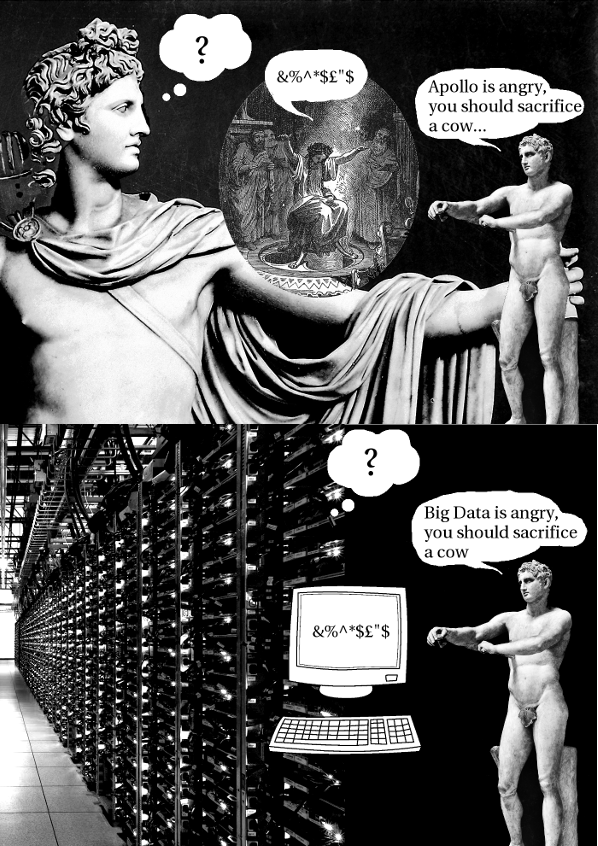
Nowadays we turn to data for advice. The oracle of big data[1] functions in a similar way to the oracle of Delphi. Algorithms programmed by humans are fed data and consequently spit out numbers that are then translated and interpreted by researchers into the prophecies the seekers of advice are sent home with. The bigger the data set, the more accurate the results. Data has spoken. We are brought closer to the truth, to reality as it is, unmediated by us subjective, biased and error-prone humans. We seek guidance, just like our ancestors, hoping we can steer events in our favour. Because of this point of departure, very strong emotions are attached to big data analysis, feelings of great hope and intense fear. Visions of utopia, the hope that it will create new insights into climate change and accurate predictions of terrorist attacks, protecting us from great disaster. At the same time there are visions of dystopia, of a society where privacy invasion is business as usual, and through this invasion an ever increasing grip on people through state and corporate control, both directly and through unseen manipulation.
Let’s take a closer look at big data utopia, where the analysis of data will protect us from harm. This ideology is fed by fear and has driven states and corporations alike to gather data like there is no tomorrow or right to privacy, at once linking it very tightly to big data dystopia. What is striking is that the fear of terrorist attacks has led to lots of data gathering, the introduction of new laws and military action on the part of governments, yet the fear of climate change has led to only very moderate activity. Yet the impact of the latter is likely to have more far reaching consequences on humanity’s ability to survive. In any case, the idea of being able to predict disaster is a tricky one. In the case of global warming, we can see it coming and aggravating because it is already taking place. But other disasters are hard to predict and can only be explained in retrospect. In Antifragility, Nicolas Taleb (2013, pp.92-93), inspired by a metaphor of Bertrand Russell, quite brilliantly explains the tendency to mistake absence of evidence for evidence of absence with a story about turkeys. Turkeys are fed for a thousand days by a butcher, leading them to believe, backed up by statistical evidence, that butchers love turkeys. Right when the turkey is most convinced that butchers love turkeys, when it is well fed and everything is quiet and predictable, the butcher surprises the turkey which has to drastically revise its beliefs.
An only slightly more subtle version of big data utopia is a utopia where data can speak, brings us closer to reality as it is, where we can safely forget theory and ideas and other messy subjective human influences through crunching enormous amounts of numbers.
“This is a world where massive amounts of data and applied mathematics replace every other tool that might be brought to bear. Out with every theory of human behaviour, from linguistics to sociology. Forget taxonomy, ontology, and psychology. Who knows why people do what they do? The point is they do it, and we can track and measure it with unprecedented fidelity. With enough data, the numbers speak for themselves.” (Anderson, 2008)
Using this rhetoric, there is no more need for models or hypotheses, correlation is enough. Just throw in the numbers and the algorithms will spit out patterns that traditional scientific methods were unable to bring to light. This promise sells well and companies providing data analysis and storage services promote it with great enthusiasm, as demonstrated by two slides in an Oracle presentation at Strata 2015: “Data Capital is the land grab of the future” and “It’s yours for the taking” (Pollock, 2015).

Can numbers really speak for themselves? When taking a closer look, a lot of assumptions come to light, constructing the myth of the oracle. Harford (2014) describes these assumptions as four articles of faith. The first is the belief in uncanny accuracy. This belief focuses all attention on the cases where data analysis made a correct prediction, while ignoring all false positive findings. Being right one out of ten times may still be highly profitable for some business applications, but uncannily accurate it is not. The second article is the belief that not causation, but correlation matters. The biggest issue with this belief is that if you don’t understand why things correlate, you have no idea why they might stop correlating either, making predictions very fragile in an ever changing world. Third is the faith in massive data sets being immune to sampling bias, because there is no selection taking place. Yet found data contains a lot of bias, as for example not everyone has a smartphone, and not everyone is on Twitter. Last but not least, the fourth belief, that numbers can speak for themselves… is hard to cling to when spurious correlations create so much noise, it’s hard to filter out the real discoveries. Taleb (2013, p.418) points to the enormous amount of cherry-picking done in big data research. There are way too many variables in modern life, making spurious relations grow at a much faster pace than real information.
As a rather poetic example, Leinweber (2007) demonstrated that data mining techniques could show a strong but spurious correlation between the changes in the S&P 500 stock index and butter production in Bangladesh. There is more to meaningful data analysis than finding statistical patterns, which show correlation rather than causation. Boyd and Crawford describe the beliefs attached to big data as a mythology, “the widespread belief that large data sets offer a higher form of intelligence and knowledge that can generate insights that were previously impossible, with the aura of truth, objectivity, and accuracy” (Boyd and Crawford, 2012). The belief in this oracle has quite far reaching implications. For one, it dehumanises humans by asserting that human involvement through hypotheses and interpretation, is unreliable, and only by removing humans from the equation can we finally see the world as it is. While putting humans and human thought on the sideline, it obfuscates the human hand in the generation of its messages and anthropomorphises the computer by claiming it is able to analyse, draw conclusions, even speak to us. The practical consequence of this dynamic is that it is no longer possible to argue with the outcome of big data analysis. This becomes painful when you find yourself in the wrong category of a social sorting algorithm guiding real world decisions on insurance, mortgage, work, border checks, scholarships and so on. Exclusion from certain privileges is only the most optimistic scenario, more dark ones involve basic human rights.
The deconstruction of this myth was attempted as early as 1984. In “A Spreadsheet Way of Knowledge”, Stephen Levy describes how the authoritative look of a spreadsheet, and the fact that it was done by a computer, has a strong persuasive effect on people, leading to acceptance of the proposed model of reality as gospel. Levy points out that all the benefits of using spreadsheets are meaningless if the metaphor is taken too seriously. He concludes with a statement completely opposite to what Anderson will state 24 years later: “Fortunately, few would argue that all relations between people can be quantified and manipulated by formulas. Of human behaviour, no faultless assumptions – and so no perfect model — can be made”. A lot has changed in 24 years. Still back in the eighties, Theodore Roszak describes the subjective core of software beautifully: “Computers, as the experts continually remind us, are nothing more than their programs make them. But as the sentiments above should make clear, the programs may have a program hidden within them, an agenda of values that counts for more than all the interactive virtues and graphic tricks of the technology. The essence of the machine is its software, but the essence of the software is its philosophy” (Roszak, 1986). This essence, sadly, is often forgotten, and outcomes of data analysis therefore misinterpreted. In order to correctly assess the outcomes of data analysis it is essential to acknowledge that interpretation is at the heart of the process, and assumptions, bias and limitations are undeniable parts of it.
In order to better understand the widespread belief in the myth of big data, it is important to look at the shift in the meaning of the word information (Roszak, 1986). In the 1950s, with the advent of cybernetics, the study of feedback in self-regulating closed systems, information transformed from short statement of fact to the means to control a system, any system, be it mechanical, physical, biological, cognitive or social (Wiener, 1950). In the 1960s artificial intelligence researchers started viewing both computers and humans as information processing systems (Weizenbaum, p.169). In the 1970s it was granted an even more powerful status, that of commodity. The information economy was born and promoted with great enthusiasm in the 1980s.
“Reading Naisbitt and Toffler is like a fast jog down a world’s Fair Midway. We might almost believe, from their simplistic formulation of the information economy, that we will soon be living on a diet of floppy disks and walking streets paved with microchips. Seemingly, there are no longer any fields to till, any ores to mine, any heavy industrial goods to manufacture; at most these continuing necessities of life are mentioned in passing and then lost in the sizzle of pure electronic energy somehow meeting all human needs painlessly and instantaneously.” (Roszak, 1986, p. 22).
Nowadays not only corporations and governments, but individuals have become information hungry. What started as a slightly awkward hobby in the 80s, the quantified self has now become mainstream with people self monitoring anything from sleep to eating habits, from sport activities to mood using smartphones and smartwatches with build-in sensors, uploading intimate details such as heart-rate, sleep patterns and whereabouts to corporate servers in order to improve their performance.
Even with this change in the way we view information in mind, it is difficult to believe we cannot see through the myth. How did it become plausible to transpose cybernetic thinking from feedback in self-regulating closed systems to society and even to human beings? It is quite a leap, but we somehow took it. Do humans have anything in common with such systems? Weizenbaum (1976) explains our view of man as machine through our strong emotional ties to computers, through the internalisation of aspects of computers in order to operate them, in the form of kinaesthetic and perceptual habits. He describes how in that sense, man’s instruments become part of him and alter the nature of his relationship to himself. In The Empty Brain (2016) research psychologist Robert Epstein writes about the idea that we nowadays tend to view ourselves as information processors, but points out there is a very essential difference between us and computers: humans have no physical representations of the world in their brains. Our memory and that of a computer have nothing in common, we do not store, retrieve and process information and we are not guided by algorithms.

Epstein refers to George Zarkadakis’ book In Our Own Image (2015), where he describes six different metaphors people have employed over the past 2,000 years to try to explain human intelligence. In the earliest one, eventually preserved in the Bible, humans were formed from clay or dirt, which an intelligent god then infused with its spirit. This spirit somehow provided our intelligence. The invention of hydraulic engineering in the 3rd century BC led to the popularity of a hydraulic model of human intelligence, the idea that the flow of different fluids in the body – the ‘humours’ – accounted for both our physical and mental functioning. By the 1500s, automata powered by springs and gears had been devised, eventually inspiring leading thinkers such as René Descartes to assert that humans are complex machines. By the 1700s, discoveries about electricity and chemistry led to new theories of human intelligence – again, largely metaphorical in nature. In the mid-1800s, inspired by recent advances in communications, the German physicist Hermann von Helmholtz compared the brain to a telegraph. Predictably, just a few years after the dawn of computer technology in the 1940s, the brain was said to operate like a computer, with the role of physical hardware played by the brain itself and our thoughts serving as software.
This explanation of human intelligence, the information processing metaphor, has infused our thinking over the past 75 years. Even though our brains are wet and warm, obviously an inseparable part of our bodies, and using not only electrical impulses but also neurotransmitters, blood, hormones and more, nowadays it is not uncommon to think of neurons as ‘processing units’, synapses as ‘circuitry’, ‘processing’ sensory ‘input’, creating behavioural ‘outputs’. The use of metaphors to describe science to laymen also led to the idea that we are ‘programmed’ through the ‘code’ contained in our DNA. Besides leading to the question of who the programmer is, these metaphors make it hard to investigate the nature of our intelligence and the nature of our machines with an open mind. They make it hard to distinguish the human hand in computers, from the characteristics of the machine itself, anthropomorphising the machine, while at the same time dehumanising ourselves. For instance, Alan Turing’s test to prove if a computer could be regarded as thinking, now is popularly seen as a test that proves if a computer is thinking. Only in horror movies would a puppeteer start to perceive his puppet as an autonomous and conscious entity. The Turing test only shows whether or not a computer can be perceived of as thinking by a human. That is why Turing called it the imitation game. “The Turing Test is not a definition of thinking, but an admission of ignorance — an admission that it is impossible to ever empirically verify the consciousness of any being but yourself.” (Schulman, 2009). What a critical examination of the IP metaphor makes clear, is that in an attempt to make sense of something we don’t understand, we’ve invented a way of speaking about ourselves and our technology that obscures instead of clarifies both our nature and that of our machines.
Why dehumanize and marginalize ourselves through the paradox of viewing ourselves as flawed, wanting a higher form of intelligence to guide us, envisioning superhuman powers in a machine created by us, filled with programs written by us, giving us nothing but numbers that need interpretation by us, obfuscating our own role in the process yet viewing the outcome as authoritative and superior. A magician cannot trick himself. Once revealed, never concealed. Yet we manage to fall for a self created illusion time and time again. We fall for it because we want to believe. We joined the church of big data out of fear, in the hope it would protect us from harm by making the world predictable and controllable. With the sword of Damocles hanging over our heads, global warming setting in motion a chain of catastrophes, threatening our survival, facing the inevitable death of capitalism’s myth of eternal growth as earth’s resources run out, we need a way out. Since changing light bulbs didn’t do the trick, and changing the way society is run seems too complicated, the promise of a technological solution inspires great hope. Really smart scientists, with the help of massive data sets and ridiculously clever AI will suddenly find the answer. In ten years time we’ll laugh at the way we panicked about global warming, safely aboard our CO2 vacuum cleaners orbiting a temporarily abandoned planet Earth.
Theinformation processing metaphor got us completely hooked on gathering data. We are after all information processors. The more data at our fingertips, the more powerful we become. Once we have enough data, we will finally be in control, able to predict formerly unforeseen events, able to steer the outcome of any process because for the first time in history we’ll understand the world as it really is. False hope. Taken to itsextreme, the metaphor leads to the belief that human consciousness, being so similar to computer software, can be transferred to a computer.
“One prediction – made by the futurist Kurzweil, the physicist Stephen Hawking and the neuroscientist Randal Koene, among others – is that, because human consciousness is supposedly like computer software, it will soon be possible to download human minds to a computer, in the circuits of which we will become immensely powerful intellectually and, quite possibly, immortal.” (Epstein, 2016).
False hope. Another example is the project Alliance to Rescue Civilization (ARC), by scientists E. Burrows and Robert Shapiro. It is a project that aims to back up human civilization in a lunar facility. The project artificially separates the “hardware” of the planet with its oceans and soils, and the “data” of human civilization (Bennan, 2016). Even thoughseeing the need to store things off-planet conveys aless than optimisticoutlook on the future, the project gives the false impression that technology can separate us from earth. A project pushing this separation to its extreme is Elon Musk’s SpaceX plan to colonize Mars, announced in June 2016, and gaining momentum with his presentation at the 67th International Astronautical Congress in Guadalajara, September 27th. The goal of the presentation was to make living on Mars seem possible within our lifetime. Possible, and fun.
“It would be quite fun because you have gravity, which is about 37% that of Earth, so you’d be able to lift heavy things and bound around and have a lot of fun.” (Musk, 2016).
We are inseparable from the world we live in. An artificial separation from earth, which we are part of and on which our existence depends, will only lead to a more casual attitude towards the destruction of its ecosystems. We‘ll never be immortal, downloadable or rescued from a lunar facility in the form of a back up. Living on Mars is not only completely impossible at this moment, nothing guarantees it will bein the future. Even if it were possible, and you would be one of the select few that could afford to go, you’d spend your remaining days isolated on a life-less, desolate planet, chronically sleep deprived, with a high risk of cancer, a bloated head, the bone density and muscle mass worse than that of a 120 year old, due to the small amount of gravity and high amount of radiation (Chang, 2014).Just like faster and more precise calculations regarding the position of planets in our solar system will not make astrology more accurate in predicting the future, faster machines, more compact forms of data storage and larger data setswill not make us able to predict and control the future. Technological advances will not transform our species from a slowly evolving one, into one that can adapt to extreme changes in our environmentinstantly, as we would need to in the case of a rapidly changing climate or a move to another planet.
These are the more extreme examples, that are interesting because they make the escapist attitude to our situation so painfully clear. Yet the more widely accepted beliefs are just as damaging. The belief that with so much data at our fingertips, we’ll make amazing new discoveries that will safe us just in time, leads to hope that distracts us from the real issues that threaten us. There are 7.4 billion of us. The earth’s resources are running out. Climate change will set in motion a chain of events we cannot predict precisely but dramatic sea level rises and mass extinction will be part of it without doubt. We cannot all Houdini out of this one, no matter how tech savvy we might become in the next decades. Hope is essential, but a false sense of safety paralyses us and we need to start acting. In an attempt to understand the world, to become less fragile, in the most rational and scientifically sound way we could think of, we’ve started anthropomorphising machines and dehumanising ourselves. This has, besides inspiring a great number of Hollywood productions, created a massive blind spot and left us paralysed. While we are bravely filling up the world’s hard disks, we ignore our biggest weakness: this planet we are on, it’s irreplaceable and our existence on it only possible under certain conditions. Our habits, our quest to become more productive, more efficient, more safe, less mortal, more superhuman, actually endangers us as a species… With technology there to save us, there is no urgency to act. Time to dispel the myth, to exit the church of big data and start acting in our best interest, as a species, not as isolated packages of selfish genes organized as information processors ready to be swooshed off the planet in a singularity style rapture.

Several months ago I stayed in an offbeat Amsterdam hotel that brewed its own beer but refused to accept cash for it. Instead, they forced me to use the Visa payment card network to get my UK bank to transfer €4 to their Dutch bank via the elaborate international correspondent banking system.
I was there with civil liberties campaigner Ben Hayes. We were irritated by the anti-cash policy, something the hotel staff took for annoyance at the international payments charges we’d face. That wasn’t it, though. Our concern was intuitive about a potential future world in which we’d have to report our every economic move to a bank and the effect this could have on marginalised people.
‘Cashless society’ is a euphemism for the “ask-your-banks-for-permission-to-pay society”. Rather than an exchange occurring directly between the hotel and me, it takes the form of a “have your people talk to my people” affair. Various intermediaries message one another to arrange an exchange between our respective banks. That may be a convenient option, but in a cashless society, it would no longer be an option at all. You’d have no choice but to conform to the intermediaries’ automated bureaucracy, giving them a lot of power and a lot of data about the microtexture of your economic life.

Our concerns are unfashionable. Without any explicit declaration, the War on Cash has begun. Proponents of digital payment systems are riding upon technology-friendly times to proclaim the imminent Death of Cash. Sweden leads in the drive to reach this state, but the UK is edging that way too. London buses stopped accepting cash in 2014 but do accept MasterCard and Visa contactless payment cards.
Every cash transaction you make is one that payments intermediary like Visa takes no fee from, so it has an interest in making cash appear redundant, deviant and criminal. That’s why, in 2016, Visa Europe launched its “Cashfree and Proud” campaign to inform cardholders that “they can make a Visa contactless payment with confidence and feel liberated from the need to carry cash.”
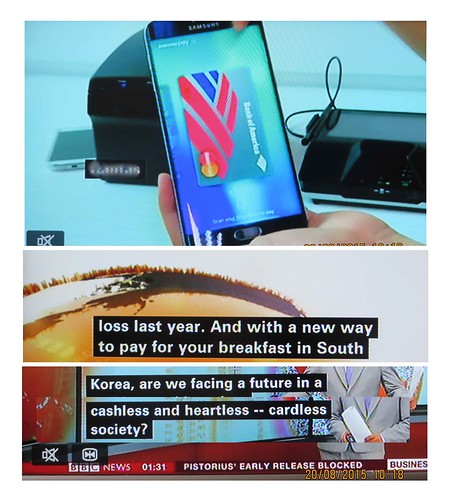
The company’s press release declared the campaign “the latest step of Visa UK’s long-term strategy to make cash ‘peculiar’ by 2020.”
There you have it. An orchestrated strategy to make us feel weird about cash. Propaganda is a key weapon of war, and all sides present themselves as liberators. Visa comes across like a paternalistic commander when assuring us that we – like a baby taking first steps – will feel a sense of achievement at liberating ourselves from the burden of cash dependence. Visa technology offers freedom without dependence or dangers.
Other propagandists join Visa. In 2014 Penny for London arrived, an apparently altruistic group set up by the Mayor’s Fund for London and Barclaycard, using charity as a hook to switch people to contactless cards on the London Underground. PayPal plastered cities with billboards claiming that “new money doesn’t need a wallet”, and a video proclaiming: “New money isn’t paper, it’s progress”. Astroturfing campaigns like No Cash Day are backed by American Express, highlighting such anti-cash themes as the environmental impact of banknotes. Other tactics include pointing out that criminals use cash, that it fuels the shadow economy, that it’s unsafe, and facilitates tax evasion.
These arguments have notable shortcomings. Criminals use many things we keep – like cars – and fighting crime doesn’t prioritise maintaining other social goods like civil liberties. The ‘shadow economy’ is a derogatory term used by elites to describe the economic activities of people they neither understand nor care about. As for safety, having your wallet cash stolen pales compared to having your savings obliterated in a digital account hack. And if you care about tax justice, start with the mass corporate tax avoidance facilitated by the formal banking sector.
However, the peculiar feature of this war is that only one side is fighting. Very few media champions defend cash. It is like a taken-for-granted public utility, whereas digital payment platforms are run by private companies with an incentive to flood the media with their key messages. When they fight this war, their target is our cultural belief in cash and the belief that its provision should be a public right.
The UK government does not plan to maintain that right and is siding with the payments industry. Their position is summed up by economist Kenneth Rogoff in his new book The Curse of Cash. He argues that, apart from facilitating crime and tax evasion, cash hampers central banks from setting negative interest rates. In the absence of cash, everyone must keep their money in the form of digital bank deposits. During recessions, central banks could then use the banking system to deliberately corrode people’s deposits via negative charges, ‘inspiring’ them to spend rather than hoard.
The emergent consensus among economic and political elites is that this is the direction to go in, but to manufacture consent for this requires a drip-drip erosion of public resistance. Hearts and minds must be shown that the change represents inevitable and desirable progress.
Anyone defending cash in this context will be labelled as an anti-progress, reactionary, and nostalgic Luddite. That’s why we must not defend cash. Rather, we should focus on pointing out that the Death of Cash means the Rise of Something Else. We are fighting a broader battle to maintain alternatives to the growing digital panopticon that is emerging all around us.
To understand this conflict, we must step back. A monetary transaction involves exchanging specific goods or services for tokens giving access to general goods and services from others. The pub landlord hands me a beer at night if I transfer tokens that allow him to get cigarettes from a shopkeeper in the morning.
There are two ways to implement this, though.
The first is to give the tokens a physical form. In this scenario, ‘getting rich’ means accumulating those physical things and ‘making a payment’ means handing them over to someone else. They are bearer instruments, which means nobody keeps a record of who owns them. Rather, whoever holds them owns them. This is your wallet with notes in it. This is cash.

Alternatively, you can use a ledger. Someone sets up a database with spaces allotted to different people. This is then used to keep a record of who has tokens. These tokens have no physical form but are written into existence. They are ‘data objects’ and are ‘moved around’ by editing the record. The keeper of the ledger thus maintains an account of what money is attributable to you, ‘keeping score’ of it for you. In this system, ‘getting rich’ means accumulating a high score on your account. ‘Making a payment’ involves identifying yourself to the keeper of the ledger via a communications system and requesting that they edit your account and the account of whoever you are paying.
Does this sound familiar? It is your bank account.
Old banks used actual books to maintain these account ledgers, but modern banks use digital databases housed in huge data centres. You then interact with them via your internet banking portal, your phone app, or by going into a branch. This is not a minor part of the monetary system. Over 90 per cent of the UK’s money supply exists nowhere but on bank databases.
It is upon this underlying infrastructure that payment card companies like Visa build their operations. They deal with situations in which someone with one bank account finds themselves in a shop owned by someone else with another bank account. Rather than the pub landlord giving me his bank details for a manual transfer, my card sends messages through Visa’s network to automatically arrange the editing of our respective accounts.
Many fintech – financial technology – startups specialise in finding ways to augment, gamify or streamline elements of this underlying infrastructure. Thus, I might use a mobile phone fingerprint reader to authorise changes to the bank databases. – ‘disruption’ merely involves putting slicker clothes on the same old emperor.
The use of high-speed communications systems to rearrange binary code information about who has what money might be new, but ledger money is as old as any bearer form. The Rai stones of the island of Yap were huge and largely unmovable stones that, while seeming like physical tokens, were a form of ledger money. Rather than being physically moved – like cash would – a record of who owned the stones was kept in people’s heads, stored in their communal memory. If the owners wished to ‘transfer’ a stone to another, they ‘edited the ledger’ of who possessed the tokens by merely informing the community. Why physically roll the stone if you can get everyone to remember that it has ‘moved’ to somebody else? The main reason that we struggle to recognise this as a form of cashlessness is that the ledger is invisible and informal.

Cashless society, though, is presented as futuristic progress rather than past history, a fashionable motif of futurists, entrepreneurs and innovation gurus. Nevertheless, while there are real trends in behaviour and tastes to be spotted in society, there are also trends in behaviour and taste among trend-spotters. They are paid to fixate upon change and have the incentive to hype minor shifts into ‘end of history’ deaths, births and revolutions. Innovation communities are always at risk of losing touch within an echo chamber of buzzwords, amplifying one another’s speculations into concrete future certainties. These prediction factories always produce the same two unprovable sentences: “In the future we will… ” and “In the future, we will no longer… “. Thus, in the future, we will all use digital payments. In the future, we will no longer use cash.
This is the utopia presented by the growing digital payments industry, which wishes to turn the perpetual mirage of a cashless society into a self-fulfilling prophecy. Indeed, a key trick to promoting your interests is to speak of them as obvious inevitabilities already underway. It makes others feel silly for not recognising the apparently obvious change.
To create a trend, you should also present it as something others demand. A sentence like “All over the world, people are switching to digital payments” is not there to describe what other people want. It’s there to tell you what you should want by making you feel in sync with them. Here’s fintech investor Rich Ricci invoking the spectre of millennials, with their strange moral power to define the future. They are repulsed by the revolting physicality of cash and feel all warm towards fintech gadgets. But these are not, on the whole, real people. They are a weapon in the arsenal of marketing departments to make older people feel prehistoric. We’re not pushing this. We’re just responding to what the new generation demands.
And so we get Visa’s Cashfree and Proud campaign. If people really were ashamed of cash, they wouldn’t need ads to tell them. Visa must engineer that shame to teach you that what you want is the same as what they want. And if you don’t want it, just remember that a cashless society is inevitable. Don’t get left behind.
But this system will leave many behind. It is hardwired to include only those with access to a bank account, and bank accounts are hosted by profit-seeking corporations that operate at scale. They have no time for your individual idiosyncrasies. They cannot make a profit off anyone who cannot easily be categorised and modelled on a spreadsheet.
So, good luck if you find yourself with only sporadic appearances in the official books of state, if you are a rural migrant without a recorded birthdate, identifiable parents, or an ID number. Sorry if you lack markers of stability if you are a rogue traveller without a permanent address, phone number or email. Apologies if you have no status symbols or are an informal economy hustler with no assets and low, inconsistent income. Condolences if you have no official stamps of approval from gatekeeper bodies, like university certificates or records of employment at a formal company. Goodbye if you have a poor record of engagements with recognised institutions, like a criminal record or a record of missed payments.
This is no small problem. The World Bank estimates that there are two billion adults without bank accounts, and even those who do have them still often rely upon the informal flexibility of cash for everyday transactions. These are people bearing indelible markers of being incompatible with formal institutional space. They are often too unprofitable for banks to justify the expense of setting them up with accounts. This is the shadow economy, invisible to our systems.
The shadow economy is not just ‘poor’ people. It’s potentially anybody who hasn’t internalised the correct state-corporate narrative of normality and anyone seeking a lifestyle outside of the mainstream. The future presented by self-styled innovation gurus has no scope for flexible, unpredictable or invisible people. They represent analogue backwardness. The future is a world of endless consumer choice built upon an inescapable digital uniformity of automated rules, a matrix outside which you can neither exist nor think.
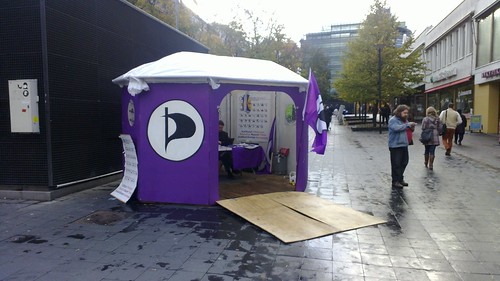
Back in Amsterdam, I hang out with Ancilla van de Leest of the Netherlands Pirate Party. She only visits establishments that accept cash, true to her political belief in individual privacy from prying eyes.
However, it would be wrong to assume that Ancilla’s primary concern involves surveillance by a Big Brother-style bogeyman. It’s true that your spending patterns reveal much about how you actually live, and the privacy implications of having these recorded in searchable database format are only starting to be uncovered. We know that targeted individual surveillance of payments occurs by the likes of the FBI and NSA, but routinised mass surveillance could become a norm. Imagine automatic flagging systems triggered by anyone engaging in a combination of transactions deemed subversive. Tax authorities are bound to be building systems to flag discrepancies between your spending patterns and your declared profits.
It’s also true that at London fintech gatherings, the exciting visions of a cashless society occasionally come with a disclaimer that we should think about the power granted to those who control the system. Not only can payment intermediaries see every time you buy access to a porn site, but they have the ability to censor your transactions, like Visa, PayPal and MasterCard attempting to choke WikiLeaksby refusing to process people’s donations. We could imagine some harsh sci-fi scenario in which a theocratic regime issues decrees to payment processors to block anyone buying books deemed sexually deviant. Such decrees could be automatically enforced via code, with subroutines remotely triggering smart locks to place the offending miscreant under house arrest while automatically deducting a fine from their account.
Such automated dystopias should ideally be avoided, so a dose of paranoia about digital payment systems is a healthy impulse, even if it might be unwarranted.
But that isn’t really the point. What’s more important to Ancilla and me is the looming sense of an external watcher that ‘assists’, ‘guides’ or ‘helps’ you in your life, tracking and logging your moves to influence you. The watcher is not a single entity. It’s a collective array being incrementally built in stages by startups and companies worldwide as we speak. We feel it seeping deeper into our lives, a mesh of connected devices, cookies and sensors. Whether we visualise it as the benevolent eyes of a parent or the menacing eyes of a tyrant doesn’t matter. The point is that the eyes have the potential to monitor you all the time.
The proclaimed Death of Cash is thus an episode in the broader drama that is the Death of Privacy, the death of the breathing room, and the death of informal, non-measured, unaccounted-for behaviour. Every action you take must forever be attached to your digital persona, dragging a data trail extending back to the day you were born. We face creating an entire generation of people who do not know what it feels like not to be monitored.
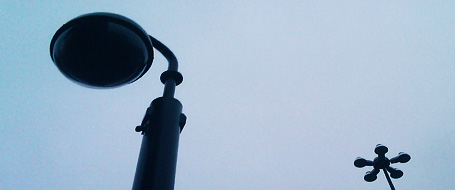
For many economists, the War on Cash will be resolved by their favourite mystical demigod, the market. This guiding force prevails when utility-maximising producers and consumers make rational choices with perfect information about their options and total freedom to choose whether or not to exercise them. If digital payment transaction costs are lower, then the cash will rightly die.
The pristine realm of market theory is unfit to assess the dynamics of this situation. Our sense of what constitutes a legitimate choice does not form in a vacuum. We are born into social power structures that tell us what normality is and shame us for not choosing ‘correctly’. You might be a rebel who challenges prevailing cultural norms, but those norms are conditioned by those with the greatest financial and media clout. At this moment, the blaring of propaganda extolling the short-term conveniences of digital payment is dulling our critical impulses to rearrange our cultural DNA. Who is thinking about the longer-term implications of building our lives around these systems and thereby locking ourselves into dependence upon them?
Unlike a battle fought using violence, hegemony is the assertion of power by getting people to believe in it, to see it as inevitable, unassailable and normal. Visa’s four-year plan is one such exercise, and once we’ve internalised it, we’ll choose to build their power. We’ll feel strangely comforted by the MasterCard billboard endorsed by the Mayor of London. We’ll find ourselves downloading ApplePay like a dazed child accepting a gift.
So, let’s prepare for the War on Cash. Remember, this is not about romanticising the £10 notes with the Queen. This is about maintaining alternatives to the stifling hygiene of the digital panopticon being constructed to serve the needs of profit-maximising, cost-minimising, customer-monitoring, control-seeking, and behaviour-predicting commercial bureaucrats. And fear not, the Germans are onside, along with the criminals, the homeless, the street-side buskers and an army of people whose lives will never get a five-star rating on a mainstream reputation scoring system. We will forge alliances with purveyors of non-bank alternative currency systems and maintain the option to use our payment cards. Because what we fight for is precisely that. The option.
When looking at the many artistic projects focused on how and why we use the internet, it’s easy to find yourself lost in a field which doesn’t show obvious, strong ties with what we normally know as “traditional art history”. This is due to historical and social reasons that emerged between the 80s, 90s and early 2000. These artists were at the vanguard of art culture and pushed at the edges of what art could be, whilst living in a post-punk and postmodernist era, and on tip of this, the arrival of the Internet in 94 changed everything. Many artists took on the challenge of what the Internet offered the world creatively, and explored it not merely as a marketing tool or a place to upload images and videos, but as a medium in its own right, inventing new technically informed, artistic tools and also building grass root led, networked art groups with new infrastructures as cultural platforms. Turning away from anything relating to the mainstream art world and what was seen as outmoded and tired traditions.
In the last decade, we’ve seen the expansion of the Internet and its use by younger generations where the medium is no longer something you exploit to change the culture, but more to integrate in traditional terms, canonical contexts.However, artist Jan Robert Leegte (born in 1973) is a very important figure to reflect upon, in order to understand this transition; while other artists of his generation were taking the internet for a non-hierarchical distributed system, he chose to explore it from a classical studies background that forged the cardinal points of his artistic research. He reflects an Internet art influenced practice which not only exists online but also in physical space. In fact, we can safely say he can be considered as one of the first Post-Internet artists. This makes him a pivotal figure in this historical segment and it’s under this light that one must visit the online exhibition On Digital Materiality (Carroll / Fletcher Onscreen, 3 August-12 September 2016). It’s a retrospective show presenting some of the most important and representative works of the Dutch artist, who wrote for the occasion an essay in which describes some of the most important aspects of his work.
Leegte says, the “materials I first used were basic HTML objects, buttons, scrollbars, frame borders, table borders, and also plain color fields and found images. I questioned what it was that rendered this practice similar to making installations rather than collages. At first it was the simulacrum of real world interactive elements (buttons, window frames, etc.). The operating system extended this haptic strategy with traditional paper-based forms, like check boxes, text fields, lists, etc, and, along with the form elements and the interactive document, led to an ecosystem of fake 3D, interactive objects.”
The work fluctuates between working on the surface and thinking in three dimensions. The same difference can be found with his use of Photoshop and HTML. If in the former case an image editing software operates directly on the final result, for the latter there is the need to know how to write code while at the same time imagine what the potential results will bring via its translation in the public space, the internet. In this sense, we do not hesitate to define Leegte as an artist who studies and uses the tools of the sculptor; he wonders how to place objects in the space, he feels the problem of contextualising a work in relation to a public and physical environment.

The perception of a substantial difference between surface and space is also proven with his interest in the basic elements of composing the digital interface (scrollbars, mouse pointers, etc). His research examines the artificial environment built by Microsoft and Apple designers. The colours and the shapes were designed to not be perceived as evident mediating agents between the user and the content – in this sense, it is interesting to note that Microsoft has often chosen a minimalist style (shades of grey, square shapes) while with Apple systems the style is usually more exuberant.
However, we should not look at the former as a less culturally relevant product. In the same way, we should not take the white cube exhibition space as a synonym of neutrality (unless we want to think that the whiteness and emptiness stay for an objectivity). This is an aspect that the artist does not seem to detect (in the text, he writes that he “preferred the aesthetics of the Windows classic interface design because of its minimalistic design – no rounded corners and ribbings like the OS 9 design, but simple beveled grey rectangles and a button object was merely a highlight and a shadow, nothing more”).
The artist reflected on how specific design elements may in some sense be preserved, as reflections and products of a particular aesthetic and cultural taste: “In Memory of New Materials Gone” (2014) is a work made by a print of the OS9 scrollbar placed in a transparent case in the same way you would do with an object no longer fashionable. This project and all the other works belonging to The Scrollbar Composition Series programmatically address the perception of virtually anonymous and transparent objects on the screen in a three-dimensional space. In a situation where their significance must be noticed; it’s the artist himself who begs to not see in this a disruptive act, an action that reveals the subtle ways in which they influence us. It is, however (but not “in opposition to”), a reflection on the artist’s activity; as we previously noted, these works are shown on the internet in the same manner in which they would be set up in a gallery space.

Perhaps, the highest point of the artist’s reflection on the differences you meet working on a surface or in three dimensions is The Photoshop Marquee Selection Series. “Random Selection in Random Image” (2012), in which a randomly generated selection marquee is shown within an image randomly obtained from the net. It is the most important work of this series because it opens three-dimensional gaps which have been created sculpturally in two-dimensional images – a dynamic that has echoes of “Scrollbar Composition” (2000), in which the Web browser’s monodimensional space is broken down and reassembled in many windows, many independent spaces sharing only the mathematical material they are made of.

The works featured in this exhibition are related to questions that go beyond the historical and cultural contingency in which they have been created. This makes many of them feel very much alive even 20 years after their creation (a novelty in digital art, I would say). This allows a healthy dialogue between different generations of artists to exist as common ground. It also engages art experts who want to be introduced to artistic issues linked to the internet. It is a dynamic that makes this exhibition a special opportunity for us all to relook at this so-called digital culture and its traditional and non-traditional art theories and its practice under a peculiar and exciting light.
On Digital Materiality – an Internet exhibition is online at Carroll / Fletcher Onscreen until 12 September 2016
During my visit to Ars Electronica I was humoured by the excessive amount of ‘hello world’ creativity that is often produced when science and technology meet and exhibit interactive spectacles that make very little claim other than an enchanting proof of concept. What I thought would be an interesting media festival turned out to be a robotics road show. This tech road show attracts over 90,000 people from Europe and Asia to wonder at the latest innovations in robotics, VR, bio-hacking, 3d printing, drones and anything that glossed the pages of Wired magazine as the next big thing.
The alchemists of our time, or as I like to call them ‘Dumb wizards’, are continuing to design and exhibit technological achievements in self-fulfilling speculative words that have very little concern, consideration or critique with any relevant social issues of our time. Excluding the CyberArts exhibition (curated by Genoveva Rückert), which I thought was a top selection of some of the best media art works of the last years, Ars Electronica is predominantly occupied by interactive spectacles that neglect to examine the social & political impact of technology.
To overlook how smart phones, big data and network computing are changing privacy & security, or how cloud based services are transforming the labour market or how Silicon valley start up culture has convinced a sizeable amount of the population that for every problem, there is an app based solution. In the bazaar of innovative design and interactive art I struggled to identify any work (be it art, product, or concept/agency) that voiced or articulated concern or criticism with technology, politics or social change. The most provocative aspects would be the whimsical one liner that is planted to introduce some speculative design projects, showcasing some daft prototype with a splash page and a quote in large font to grab the attention of the viewer.
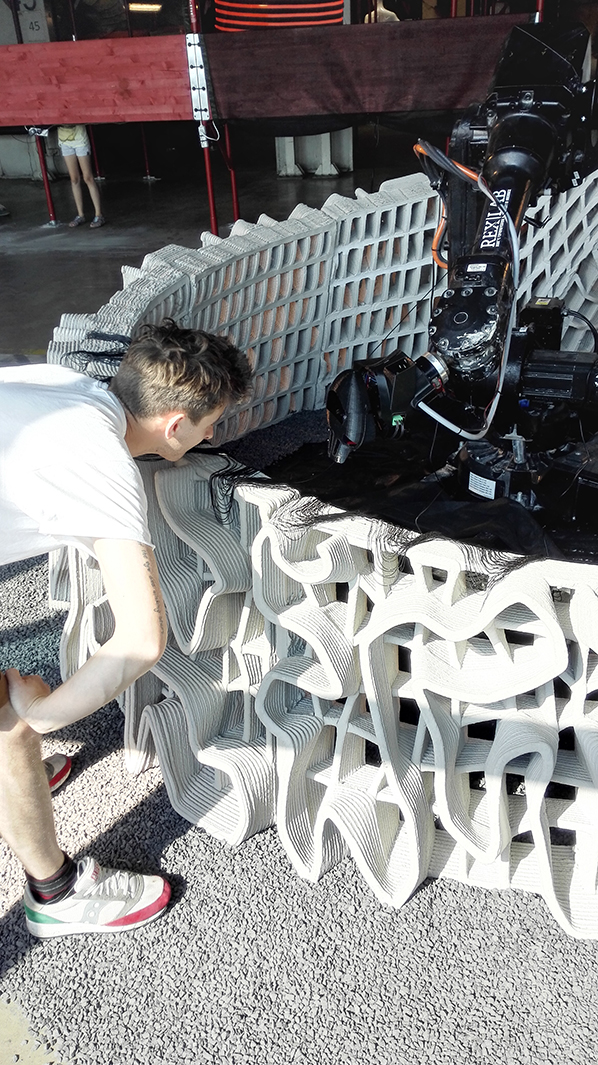
What is the gold of our time?
How do we build a social relationship with others?
Innovation: Where do we go from here?
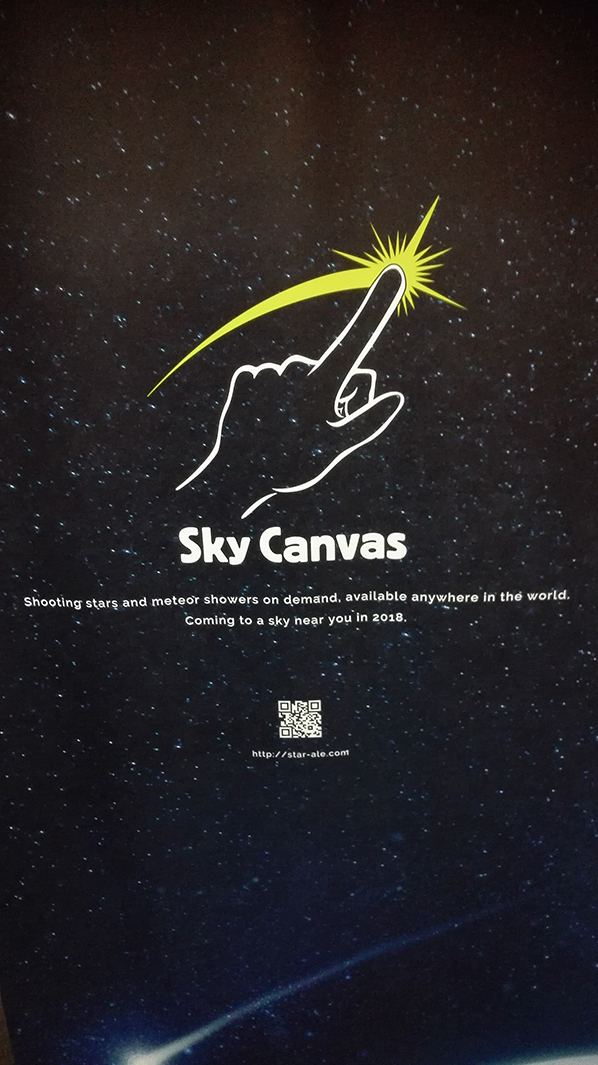
My favourite example of this was the disastrous ‘sky canvas: Shooting Stars. On demand’, an initiative to re-create the magic of a shooting star with satellite technology and glowing bits of plastic that can be shot into the night sky at the tap of a mobile app. The Alchemists of our time have fixed the magic of shooting stars. Great, thanks.
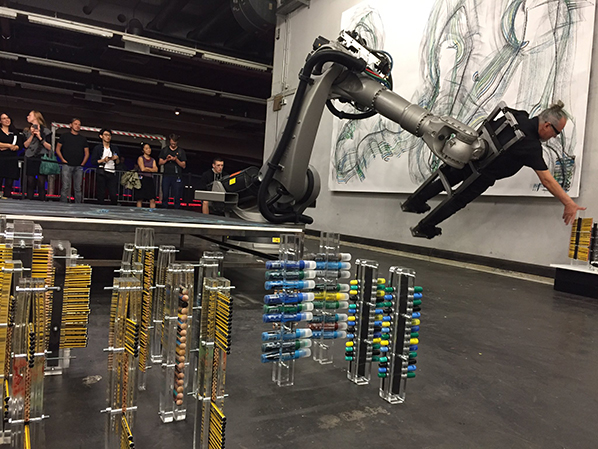
Much of the programme was better suited as light-hearted evening entertainment, drone racing, robot cooking, and endless drawing automaton. This robot, which I called ‘Human Pencil’ would throw around its inventor while he held 20 pencils and tried to make a drawing. Simultaneously inventive, pointless and entertaining; these robotic meme installations are better suited to robot fail video compilations on YouTube than to an art exhibition. The rejection of a critical consideration or a socio-political framing of the role of technology leads to what I call ‘enchantment art’, where the same devices used to execute mass killings in war zones become family friendly evenings entertainment.
Congratulations Dragan Ilić & team. Next performance at 10pm #Arselectronica16 #Artandscience @ArsElectronica pic.twitter.com/HgYXEctsYN
— GV Art (@GV_Art) September 8, 2016
So how has Ars Electronica, one of the longest standing and biggest media arts festivals in the world, found itself so far distanced from the political concerns surrounding technology? The first reason perhaps is that science does not bode well with critical theory. Many of the projects at Ars Electronica (again, excluding the CyberArts exhibition) feel like science museum artefacts that simply demonstrate technical (in)capability.
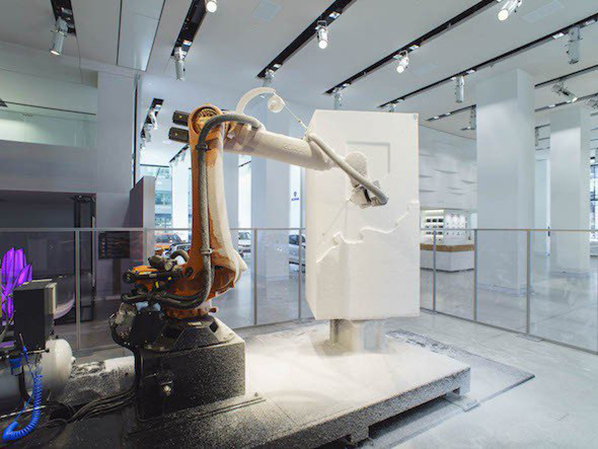
This attitude can be personified by the man I saw wearing a t-shirt stating “SCIENCE – It works, bitches”. Take for example this robotic arm reprinting Michelangelo sculptures which can only underline the immense technical potential of technology. Another possible reason perhaps that many of the works at Ars lacked social awareness is because they are produced by scientists & programmers in isolated laboratories. In this working methodology the viewer is rarely considered apart from in user tests, case studies and de-bugging. I found many maker lab types standing next to their large laser cutters avoiding eye contact while they printed out modular components and hoped for the next entrepreneur to walk past and slam down an investment fund. The lack of social awareness and engagement of issues surrounding our time have begun to impinge on the festival itself and an awareness campaign called #kissmyars is voicing concerns over the lack of female representation at the festival, particularly in the prix art prize which is awarded to men 9/10 times. The gender diversity in technology sector should no longer be ignored; this is one example of a socio-political issue not only overlooked at the festival program but also exacerbated by the organisation itself. I hope that the #KissMyArs campaign will not only rebalance the gender inequality at the event but also encourage the organisers to address other alarming realisations that operate within and around the application of technology in the social, political and economic sphere. Perhaps the Alchemists of our time should stop staring into the night sky planning the next life saving app and begin addressing the issues that applications can’t fix.
#KissMyArs
Leila Johnston was Rambert Dance company’s first ‘digital creative in residence’ from October 2015 – February 2016, having successfully applied to their residency programme, Sprint. The programme aims to enable Rambert to engage more deeply with the digital world, and is framed as experimental and light touch, with no expectations or goals in mind. One of the outputs of Leila’s residency – and the subject of this review – was a report ‘Hacking Rambert’, an incisive account of Leila’s time on Sprint, as well as a reflection on the nature of the creative residencies, dance and technology cultures.
Leila describes herself as an outspoken critic of current technology culture, resistant to its tendency for ‘digital evangelism’. The report belies her frustrations with technology culture – and indeed is a call to arms for rethinking what that culture needs to become. Her approach to the residency reflects this, emphasizing that its value came from bringing her critical perspectives about tech culture to bear, as much as from introducing dancers to ‘tools’ (though this played an important role too). She stresses how opportunities for growth and learning arose ‘through people (and sometimes tech)’ (my italics), and places human interaction and collaboration at the forefront, alongside, if not over and above, hardware and software. Dance is, she says, ‘about extraordinary relationships on every level – with yourself and then the little halo of space around you at all times, and then with greater and greater halos until it’s with everyone you meet.’ People are at the centre of her thinking and writing, and her residency was underpinned by questions such as ‘Is there a way to use technology to do justice to the human lifetimes that go into dance? Is there a way to dignify individuals, to invite confrontations with real people, to respect something other than the movement and acknowledge the part that individual experience plays in the construction of dance?’

Reflections on the cultures of the dance and technology worlds are also central to the report. Leila was struck by the relative openness and accountability of the dance world, which she saw as ‘a home that opens its doors to anyone that knocks’, in contrast to self-aggrandizing, solution-focused, often misogynistic digital world that is so well equipped to sell itself and its benefits. One of the observations that fascinated me most was about the different approaches to labour in the dance and digital worlds. For the former, hard work is a celebrated and central driver – dancers are ‘efficient’ because no work is seen as wasted. By contrast, the digital world wants to recover ‘free time’ by getting the hard stuff out of the way. While tech wants to make things easier – dance wants to make them harder – so that difficulties and limitation can be mastered and overcome.
The dominant tech world rhetoric that technology – coding especially – is ‘for everyone’ is thrown into relief by its absence in the dance world, where no one would expect ‘everyone’ to be a brilliant dancer, since this is something that requires a lifetime of grit and dedication as well as the right body and innate talent. Leila shows us that we can learn from the dancers’ dedication and commitment that ‘not everyone can do anything, and that there are pursuits that arise from the nuanced world of individual lifetimes and personal, emotional, motivation, the results of which don’t resolve into a formula’.
Although her emphasis was on criticality and personal relations, she drew on an impressive range of kit. She experimented with a thermal camera attached to her iPhone, which enabled her to explore a ‘dance of heat’. She observed that ‘the idea that dancers can be expressed as their invisible heat is strange, but absolutely real’.
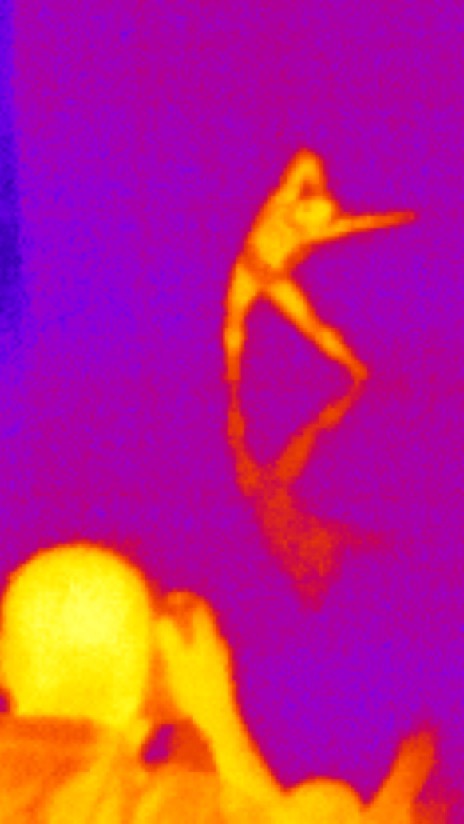
The Point Cloud demo on the Kinect was of great interest to the dancers, for whom it allowed a new kind of 360-degree vision, useful since they are ‘always looking for their own back’. Leila experimented with a Raspberry Pi, using it for a range of experiments including connecting LED panels where she could display words and video. Again though, as well as the tool itself, the Pi gave rise to critical reflection: ‘Why aren’t we teaching dancers and choreographers creative technology skills for their work, rather than reinforcing a hierarchy of expertise by ‘advising’ them on creative direction?’ Emphasizing how accessible and readily available Pis, LED panels and other technologies now are, Leila makes the point that maker culture can be embedded in the dance world at little cost, but this won’t happen organically unless more awareness of each other’s culture is fostered.

Drawing from the residency blog hackingrambert.tumblr.com, Leila reflects on time, truth, and difficulty. She is resolute that time, patience and commitment are needed to make meaningful artistic contributions, and that artists undertaking short term residencies need to be realistic about what can be achieved. Rather than gunning for a finished product, ‘short projects should be about making – what it means to be a creative, and what we learned about the best way to do things in the context of the artificially short creation time.’ Unlike the tech world, quick fix and solutionism will not fare well on a creative residency.
Leila’s reflections on the notion of truth are intriguing; she feels that there is ‘nowhere to hide’ in dance, and draws a parallel between dancers’ bodies and the ‘technical authenticity’ of circuit boards and wires. These forms of hardware offer respite from the slick interfaces that are so characteristic of digital technologies. She notes: ‘I’m interested in the relationship between truth and performance; the unique way in which (dance) performances are honest, how our bodies give away the truth, how things represent what they are very transparently’. These explorations of truth provoke rich questions about authenticity, identity, ‘fidelity’ and representation. The notion of the stripped back body is a striking one, and when one observes a dancer in motion, with their muscles, sinews, bones, sweat, and humanity on display, there can be a powerful connection between the dancer and the audience. However, there is artifice at work in dance too – creating illusions with the body, emphasizing certain lines, creating the appearance of fluidity and ease when the body is being pushed to its physical limits. Can we draw an analogy here to the performance of identity online, where the blood, sweat, tears and humanity are often glossed over with ‘choreographed’ images that appear spontaneous and perfect? Or is the truth of dance and bodies precisely an antidote to this phenomenon? My caution here would be that dancers have identities as well as bodies, and are not immune to the pressures placed on them about their appearance and representation.
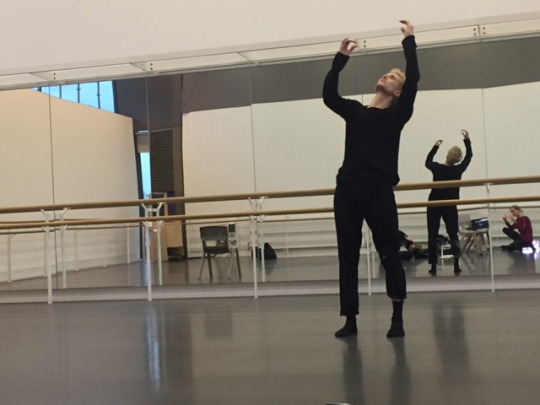
Leila argues that the creative tech community needs to work harder to understand dance, but that dance too ‘has much to gain by creatively educating itself in the available tech options’. Introducing dancers and the dance world to creative technologies can be fruitful, but should not be understood in solutionist terms. Technologists must take responsibility for the enormous power they have in society – it is up to them to ‘educate and differentiate’ between the potentially homogenous mass that is ‘technology. Finally, she makes a case for ‘contemporary creative technology’. The notion of the contemporary connotes the historical nature of a given art form and the contingencies of its evolution – conceptually, technically, physically, socio-politically. The relative nascence of technology, she suggests, leaves it unanchored, and subject to the intentions of ‘commercial forces’. She states ‘A contemporary creative technology could lay down the microphone of narrative and exist in the depths of the present. We could stop writing our own story in the cultural canon – indeed stop telling stories about what we’re doing at all – and focus on being demonstrable and accountable.’
There are moments when Leila seems to idealize the dance world as relatively problem-free, without acknowledging its potential problems – not least the subjection of bodies to punishing regimes and the mental and physical problems this can give rise to, and issues of social inequality, accessibility and exclusivity that come with all creative industries. However, there is clearly a lot the technology world can learn from the culture of dance. Perhaps the tech sector should start having dancers in residence…
Basic Income is often promoted as an idea that will solve inequality and make people less dependent on capitalist employment. However, it will instead aggravate inequality and reduce social programs that benefit the majority of people.
At its Winnipeg 2016 Biennial Convention, the Canadian Liberal Party passed a resolution in support of “Basic Income.” The resolution, called “Poverty Reduction: Minimum Income,” contains the following rationale: “The ever growing gap between the wealthy and the poor in Canada will lead to social unrest, increased crime rates and violence… Savings in health, justice, education and social welfare as well as the building of self-reliant, taxpaying citizens more than offset the investment.”
The reason many people on the left are excited about proposals such as universal basic income is that they acknowledges economic inequality and its social consequences. However, a closer look at how UBI is expected to work reveals that it is intended to provide political cover for the elimination of social programs and the privatization of social services. The Liberal Party’s resolution is no exception. Calling for “Savings in health, justice, education and social welfare as well as the building of self-reliant, taxpaying citizen,” clearly means social cuts and privatization.
UBI has been endorsed by neoliberal economists for a long time. One of its early champions was the patron saint of neoliberalism, Milton Friedman. In his book Capitalism and Freedom, Friedman argues for a “negative income tax” as a means to deliver a basic income. After arguing that private charity is the best way to alleviate poverty, and praising the “private … organizations and institutions” that delivered charity for the poor in the capitalist heyday of the nineteenth century, Friedman blames social programs for the disappearance of private charities: “One of the major costs of the extension of governmental welfare activities has been the corresponding decline in private charitable activities.”
To Friedman and his many powerful followers, the cause of poverty is not enough capitalism. Thus, their solution is to provide a “basic income” as a means to eliminate social programs and replace them with private organizations. Friedman specifically argues that “if enacted as a substitute for the present rag bag of measures directed at the same end, the total administrative burden would surely be reduced.”
Friedman goes on to list some the “rag bag” of measures he would hope to eliminate: direct welfare payments and programs of all kinds, old age assistance, social security, aid to dependent children, public housing, veterans’ benefits, minimum-wage laws, and public health programs, hospitals and mental institutions.
Friedman also spends a few paragraphs worrying whether people who depend on “Basic Income” should have the right to vote, since politically enfranchised dependents could vote for more money and services at the expense of those who do not depend on these. Using the example of pension recipients in the United Kingdom, he concludes that they “have not destroyed, at least as yet, Britain’s liberties or its predominantly capitalistic system.”
Charles Murray, another prominent libertarian promoter of UBI, shares Friedman’s views. In an interview with PBS, he said: “America’s always been very good at providing help to people in need. It hasn’t been perfect, but they’ve been very good at it. Those relationships have been undercut in recent years by a welfare state that has, in my view, denuded the civic culture.” Like Friedman, Murray blames the welfare state for the loss of apparently effective private charity.
Murray adds: “The first rule is that the basic guaranteed income has to replace everything else — it’s not an add-on. So there’s no more food stamps; there’s no more Medicaid; you just go down the whole list. None of that’s left. The government gives money; other human needs are dealt with by other human beings in the neighborhood, in the community, in the organizations. I think that’s great.”
To the Cato Institute, the elimination of social programs is a part of the meaning of Universal Income. In an article about the Finish pilot project, the Institute defines UBI as “scrapping the existing welfare system and distributing the same cash benefit to every adult citizen without additional strings or eligibility criteria”. And in fact, the options being considered by Finland are constrained to limiting the amount of the basic income to the savings from the programs it would replace.
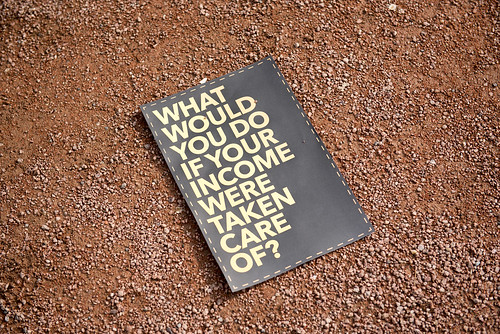
From a social welfare point of view, the substitution of social programs with market-based and charitable provision of everything from health to housing, from child support to old-age assistance, clearly creates a multi-tier system in which the poorest may be able to afford some housing and health care, but clearly much less than the rich — most importantly, with no guarantee that the income will be sufficient for their actual need for health care, child care, education, housing, and other needs, which would be available only by way of for-profit markets and private charities.
Looking specifically at whether Friedman’s proposal would improve the conditions of the poor, Hyman A. Minsky, a renowned and highly regarded economist, wrote the “The Macroeconomics of a Negative Income Tax.” Minsky looks at the outcome of a “social dividend,” which “transfers to every person alive, rich or poor, working or unemployed, young or old, a designated money income by right.” Minsky conclusively shows that such a program would “be inflationary even if budgets are balanced” and that the “rise in prices will erode the real value of benefits to the poor … and may impose unintended real costs upon families with modest incomes.” Any improved spending power afforded to citizens through an instrument such as UBI will be completely absorbed by higher prices for necessities.
Rather than alleviating poverty, UBI will most likely exacerbate it. The core reasoning is quite simple: the prices that people pay for housing and other necessities are derived from how much they can afford to pay in the first place. If you imagine how housing is distributed in modern capitalist society, the poorest get the worst housing, and the richest get the best. Giving everyone in the community, rich and poor alike, more money would not allow the poorest to get better housing, and it would just raise the price of housing.
If UBI came at the expense of other social programs, such as health care or child care, as Friedman intended, then the rising cost of housing would draw money away from other previously socially provisioned services, forcing families with modest incomes to improve their substandard housing by accepting worse or less childcare or healthcare, or vice versa. A disabled person whose mobility needs requires an additional expenditure on accessible housing may not have enough of the basic income left for any additional health care they also require. Yet replacing means testing and special programs that address specific needs is the big idea of UBI.
The notion that we can solve inequality within capitalism by indiscriminately giving people money and leaving the provisioning of all social needs to corporations is extremely dubious. While this view is expected among those, like Murray and Friedman, who promote capitalism, it is incompatible with anticapitalism. UBI will end up in the hands of capitalists. We will be dependent on these same capitalists for everything we need. But to truly alleviate poverty, productive capacity must be directed toward creating real value for society and not toward “maximizing shareholder value” of profit-seeking investors.
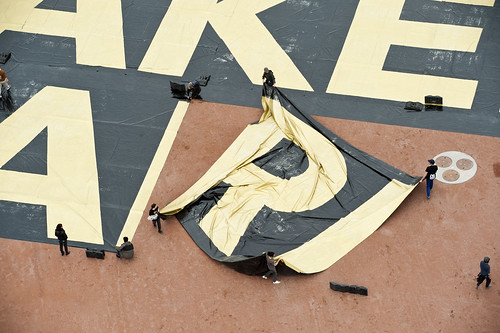
Many people don’t dispute the fact that establishment promoters of UBI are only doing it to eliminate social programs, but they imagine that another kind of basic income is possible. They call for a basic income that disregards the “deal” that Charles Murray advocates but wants UBI in addition to other social programs, including means-tested benefits, housing protections, education and child care guarantees, and so on. This view ignores the political dimension of the question. Proposing UBI, in addition to existing program mistakes, a general consensus for replacing social programs with a guaranteed income for a broad support base for increasing social programs. But, no such broad base exists.
Writing in 1943, with the wartime policies of “full employment” enjoying wide support, Michal Kalecki wrote a remarkable essay entitled “The Political Aspects of Full Employment.” Kalecki opens by writing, “a solid majority of economists is now of the opinion that, even in a capitalist system, full employment may be secured by a government spending programme.” Though he is talking about full employment, which means an “adequate plan to employ all existing labour power,” the same is true of UBI. Most economists would agree that a plan to guarantee an income for all is possible.
However, Kelecki ultimately argues that full employment policies will be abandoned: “The maintenance of full employment would cause social and political changes which would give a new impetus to the opposition of the business leaders. Indeed, under a regime of permanent full employment, ‘the sack’ would cease to play its role as a disciplinary measure. The social position of the boss would be undermined, and the self-assurance and class-consciousness of the working class would grow.”
The conflict between the worker and the capitalist, or between the rich and the poor, can not be sidestepped simply by giving people money if capitalists are allowed to continue monopolising the supply of goods. Such a notion ignores the political struggle between the workers to maintain (or extend) the “basic income” and the capitalists to lower or eliminate it to strengthen their social position over the worker and to protect the power of “the sack.”
Business leaders fight tooth and nail against any increase in social benefits for workers. Under their dominion, only one kind of UBI is possible: the one supported by Friedman and Murray, the Canadian Liberal Party and all others. They want to subject workers to bosses. The UBI will be under constant attack. Unlike established social programs with planned outcomes that are socially entrenched and difficult to eliminate, UBI is just a number that can be reduced, eliminated, or allowed to fall behind inflation.
UBI does not alleviate poverty and turns social necessities into products for profit. To truly address inequality we need adequate social provisioning. If we want to reduce means testing and dependency on capitalist employment, we can do so with capacity planning. Our political demands should mandate sufficient housing, healthcare, education, childcare and all basic human necessities. Rather than a basic income, we must demand and fight for a basic outcome — the right to life and justice, not just the right to spend.
For more than two decades, Italian artist duo Eva and Franco Mattes have sought to subvert and expose the systems which produce power. Their current exhibition, Abuse Standards Violations at Carroll/Fletcher gallery, looks at who and what is made visible and invisible in the process of producing culture for online consumption.
The artists, who did not receive a formal arts education, describe themselves as “a couple of restless con-artists who use non-conventional communication tactics to obtain the largest visibility with the minimal effort.” They repeatedly worry the edges of technical structures – legal, religious, software – observe the resultant content and feed it back into new structures. It’s a process which acknowledges and seeks to communicate erasure, loss and chaos as well as their inverses. In Abuse Standards Violations, the artists acknowledge that chaos, and slippiness of boundaries in the arrangement of work that collides fragments of different disciplines and practices together.
The central work in the exhibition is Dark Content. When their project No Fun (2010), presented unchallenged in a gallery, was removed from YouTube on the grounds of being ‘shocking and disgusting content’, the Mattes’ began investigating content moderation. The video, image and text content we encounter on platforms like Youtube is there because it has been permitted to be there. To gain permission, content once produced must be approved. The approval process involves a number of decision-making structures. The rules determining which content passes or fails (is good or bad, safe or unsafe) are built by, and entangled with, the organisational framework of the platform. To deploy this framework and enforce its rules, algorithms organise data and trace patterns, and people – working as ‘content moderators’ – are paid to decide which criteria a piece of content belongs to, and act accordingly.
Eva and Franco spoke to a number of content moderators about their work. These interviews give insight into a role which is simultaneously powerful and socially stigmatised (one moderator does not tell their partner what they do); which, despite actively forming culture, is in many ways concealed. Following the neoliberal pattern, process is skipped over to reach the content; moderators are scarcely mentioned by the culture in whose production they are thoroughly implicated. This is unsurprising given that the moderators are people like you and me, as well as being points through whom the governing structures of social media can be accessed.
The Mattes’ interviews with content moderators are presented in the exhibition as stock avatars, preserving the anonymity of the speakers; away from the exhibition, the interviews can be seen only on the Darknet. The avatars in Dark Content are displayed on screens within booths constructed from office furniture; structures designed for typing and filing are flipped around like tetris blocks to become a new kind of structure. The furniture is simultaneously recognisable, and out-of-place – particularly, no doubt to the freelance, self-employed person who often works from the sofa or cafe.
BEFNOED (Be Everyone For No One Every Day), deploys unusual positioning of screens in the gallery space. Visitors are required to lie on their backs, crouch down or otherwise contort themselves in order to watch videos of other people carrying out banal tasks such as putting a bucket on their head. The latter group of people has been paid for their work, the tasks having been advertised on crowdsourcing websites. Both groups have spent energy and time on their endeavours, and now both come together in a space. The intimacy is an interface which suggests the connectedness of gallery visitor and global networks and their mutual implication in the way culture is produced.
The works in Abuse Standards Violations relate and separate different lives, different cultures and different kinds of labour. They muddle contexts and objects, creating spaces and structures that are – clearly and disconcertingly – no less strange than those already available in contemporary society. These spaces and structures complicate the difference between reality and simulation. They also make the distribution of power painfully clear. For a powerful structure to appear trustworthy it is useful to appear impartial, logical, scientific; to appear trustworthy it is useful to destabilise or dismantle other structures by choosing what is made visible and what is not, what to make public and what to keep private. Those who are unfamiliar with the regulatory structures become implicated unknowingly. One of the moderators interviewed for Dark Content did not consider their work censorship since they worked for the government. Another comment ran along the lines of ‘I am only enforcing the rules; I don’t make them’.
In making clearer the arrangements of power behind YouTube, the arrangements of power in the art world – one of the routes to cultural production – are necessarily also challenged. The aesthetic choices the artists have made have clear social and political implications which create uncomfortable questions about concepts such as privacy. The complicated act of content moderation makes some information unavailable in order to communicate other information. This process is by no means limited to the world of content moderation – it applies wherever there is a message to pass on.
Invisible labour and visible outputs are separated by social stigma, sophisticated regulatory systems and other factors, local and global, which create a powerful invisibility. The works in Abuse Standards Violations combine objects, images, texts and concepts in surprising ways which give some substance to this invisibility. The job of the content moderator is part of culture, as is the expenditure of energy by bodies, as are rotas, as are company regulations, as are artists and galleries and gallery visitors. Thinking about how such things relate leads to challenging and powerful questions.
Abuse Standards Violations is at Carroll/Fletcher gallery in Soho until 27 August alongside Planetary-scale Computation by Joshua Citarella.
http://www.carrollfletcher.com/exhibitions/55/overview/
In this special feature Steve Jampijimpa Patrick writes about YAMA, the name given to the installation currently on display as part of the exhibition Networking the Unseen at Furtherfield Gallery.
* * * * * * * * * * * *
I want to tell you about YAMA. This is the Warlpiri word for a shadow, or reflection. It’s also a word that we use to describe a meeting or a meeting-place; we gather under a tree that casts a shadow (a reflection of its shape) onto the ground, and we talk in a group – both men and women together, equally – to make decisions and to reflect on ourselves and our lives. But it’s deeper, too. In yapa (Aboriginal) culture, if someone says “you don’t have a shadow”, it means you don’t exist. All the birds, all the small animals, trees – these things all have a shadow; all of your country and everything in it; this is your universe. How can you reflect your universe? And what about you, reader? Does your homeland reflect you?
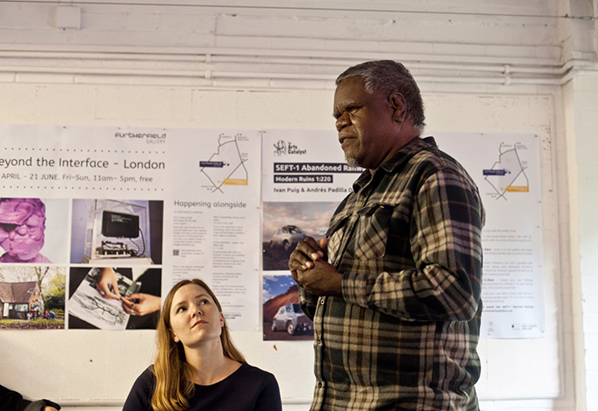
I’ve been all over the world, searching for ngurra kurlu (the home within). Each country’s, each people’s ngurra kurlu is different. If you don’t speak your language, if you don’t know your culture, the songlines of the animals in your country, how can you express yourself or where you’re from? This reflection happens through language, through dance, art, even food – that’s ngurra kurlu. There is a universe and we are its shadow.
We yapa say “don’t become Australian, become Australia”.
That’s ngurra kurlu.
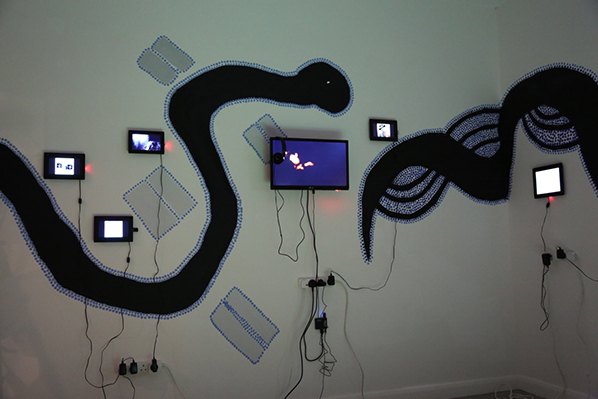
I am writing this from Germany, we (Neil Jupurrurla Cooke and I) were in England for a week working on YAMA, a multimedia installation with Napanangka (Gretta Louw) for the Networking the Unseen exhibition at Furtherfield. Every day we walked through Finsbury Park and the people we saw were really alive there, playing, walking, school children running through, watching the birds and the squirrels. But when we go into town, we feel closed up again. We went to the Horse Guard. Where I come from, the horses roam free – they are really alive. We don’t know their skin name , we don’t have a song for them because they’re feral animals, brought into our country by kardiyah (white people) – but they’re free. When we see the horses there in London trained to stand still like that, like they’re stone, we feel sad for them.
Then we look around and see those buildings round there (in Westminster). We’ve seen those buildings before. Even though we’d never been to London. They’re like underwater, you know, that coral when it dies – when it’s bleached – that’s what those buildings are like. Every thing, both living and created by the living, is a reflection of our universe. Imagine you are a little ant and you are walking through tombstones – this is how it feels for us to be in that place. I guess the people that made those towers are trying to express power, they want to have power over other people. They build those bleached towers and statues tall on columns to make the other people feel small. That’s a crazy world, when I’m coming at it from my culture.
Your home is going to reflect you and you’re going to reflect your home. So, think about your home and what it says about you.
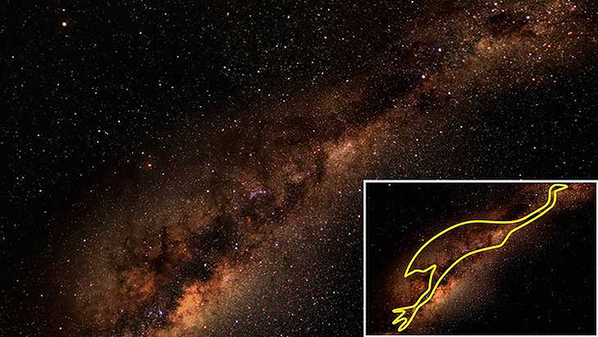
For us, the things we look up at are the stars. We’ve always known them and learned from them. They are part of our ngurra kurlu. What about that North star that you have here in the northern hemisphere – they say it doesn’t move. Maybe that’s why you have one leader, one queen, who doesn’t change. Down in Australia, we have five emus (the southern cross) – we live by that law. We call ourselves an emu country. You bear countries reflect your stars, too. I like to think that the queen is the ultimate kurlungu (guardian) for the country, but a kurlungu needs to really look after all their people and their country. Is that what’s happening in your country?
I wonder what would happen if you brought an emu up here and just let it walk around. I’ve never seen it but I think it might start heading south. We have a word for ocean, mangku-rla, even though we’re a desert mob. This shows how ancient our songlines are – they existed before us; they created us. We were supposed to be noble savages, from the settlers’ point of view we weren’t supposed to know about the ocean or what was on the other side, but our Emu Dreaming tells the story of the emu swimming across the ocean. He was a nervous emu because he was being chased into the water by dogs. I think that was when the emu went between the continents to make relations with the ostrich and the rhea bird and the moa. There were big, flightless birds like the emu on each of the continents. In the Jardiwanpa story, the emu comes out of the water and shakes himself like a dog. This is reflected in the stars as well; our emu stars (the English name is the Milky Way) come up after the wet season.
In yapa culture, we know that we didn’t create the body: our universe, our country created us. That’s why I am a black man from Australia – my country made me like this. This is what you call evolution. You can have bears in the north, and we have emus in the south. Our countries created those beings. Yapa have always known that this is how things are created.

You live in the bear countries; even without people knowing it, they are reflecting what the bear is trying to teach them. We live by the emu. I can’t tell you what the bear is teaching you, I’d need to live here a lot longer, but you can learn to hunt the knowledge that the bear is trying to show you.
There are food sources for your stomach and there are some for your mind. Both are equally important. If you are hunting for goanna you bring it home and share it with your family and your community. If you are sitting, talking, learning that’s also hunting – you are hunting knowledge and you bring it home and share it with your people. The mind and the physical reflect each other – that’s yama.
The Australian coat of arms is meaningful to us, even though we weren’t asked to choose it. The emu is our teacher, wise and kind, and the kangaroo is like a warrior or a judge, strong and powerful. The nature of our land, our country, is reflected in this coat of arms. When I look at the English coat of arms, I see a lion and a unicorn. Do these animals come from your country? What does this coat of arms represent and what does it reflect about your country?


When I ask you to help me hunt the unicorn, will you understand what I mean?
Hunting the unicorn is a way to understand its ngurra kurlu, to try to understand the country and therefore to understand the people. After all, if you’re hunting something, you have to learn to think like the animal that you’re hunting. It’s a way to fit into the country and to feed on that country; that country nourishes you. That’s the most important skill you can have. It’s a skill to understand the prey, and to think like the prey. It’s something I never understood before. But now I do.

If you know how to reflect yourself, you can then reflect other people. Don’t try to do it back to front.
In the second of three articles about the Web 2.0 photosharing service Flickr (the first is here), I continue to make a case for the quiet but profound innovations created by the sheer scale and ease of use, of these services – something which enables self defining artist, outsider artist, hobbyist & people who would run a mile from being called an artist to share and be mutually influenced by each others work. Here I offer some notes on the beautiful, funny and humane photography of London art teacher Joseph Cartwright, who operates under the Flickr name Noitsawasp.
Very few humans directly in these images but everywhere traces, evidence of human activity. Not cold. Full of humour.
Patterns of human activity, some accidental but capable of being invested with new meaning. Some straightforwardly meaningful, interpretable. Evidence of events and activities.
Always formally engaging.
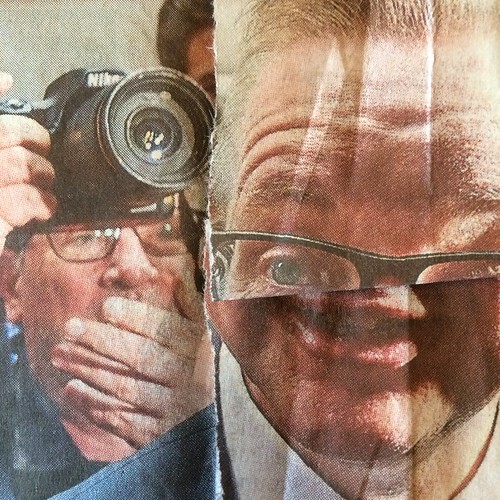
A map of a world. A map of our world. A map of the world of work, of most of us, of the 99%.
Impossible to imagine these images made on streets of a town where less than 50 languages were spoken.
What we see when we look at these is what we see when we look at art.
An invitation to narrative.
Patterns on the one hand // traces of the wake that humans leave behind them in the world.
One of those humans is Joseph C––sometimes the images are records of his interventions in the world of images––those image fold-overs or blends. Sometimes the photos are a record of him as performer, actor, in the world ( but after he has left the stage). Sometimes they seem to place us directly behind his eyes.

I think he looks quizzically at the world. Do you know him––does he look quizzically at the world?
You imagine his eyes darting around––down, to the side, up occasionally, lighting on something, some congruence of objects, pausing to decide whether to make an image…(brows knotted, a sense of pressure, the need to seize the moment…)
look at this; see through this; look into that; make that out
grids; grids; patches of light; a dictionary of cowboy terms
People nail nails, people mend things, people bend things, people break things, people clean, people wash clothes, people read, people admonish, people alert, people have funny feelings––goose bumps, shivers or feelings it’s hard to explain somehow.

I saw a pattern! It was a message to me! It was a message to you. It made me feel…oh…I can’t say what…
This empty table here; those empty chairs there
The café/condiment photos––a series––eating––so basic––and we always remember that but we also think––‘we know this kind of café too’, ‘we go here on these occasions’––and we wonder what kind of a person this serial café goer is, is this an important routine in his life, does it define him amongst others, his friends, colleagues, what does he eat, are the condiments incidental or fundamental to his café visits, does he keep his distance from the condiments, use them with discretion, does he go to the café now only or mainly for his mission to image the condiments or do his meals and his art dovetail nicely, conveniently, pleasantly here. Do his companions laugh when he takes today’s photo? Or does he eat alone?

Cables, pipes, tangles––runes, ciphers, hieroglyphs.
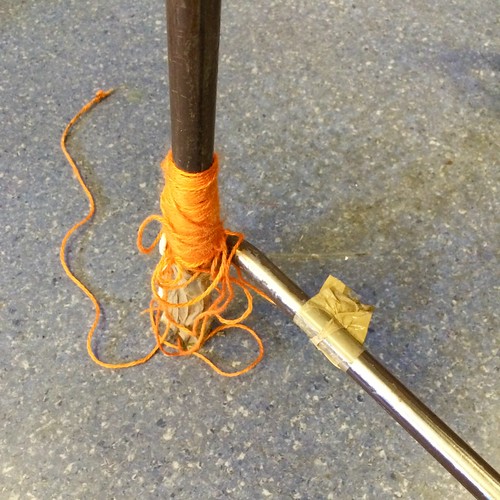
The morning was sunny. It rained. The afternoon was still warm but muggy. There was a rainbow. The sky was blue. The fence was a different blue.
Shadows, folds, stripes, other repetitive patterns. Some there, pre-intended, functional. Some found, loaned, in the process of making the photo.
Objects that are (or have been) useful or functional removed from or seen out of their usual context. (Sometimes by human agency––dumped, temporarily abandoned, or simply cropped)

Estrangement––making us see the world anew // making us remember our world anew.
Found patterns, found juxtapositions.
A lively eye and a lively mind.
Joy in colour. Grace in handling, in apportioning that colour. It’s like he finds the best tidbits and, smiling, hands them to us.
It isn’t abstracting from the world // the function is often still evident so it’s like layer upon layer of meaning and affect and confusion // the original function or action…the strange pattern it makes… its removal from its usual context.
These images lend us Joseph C’s eyes. These images lend us another human’s mind and sensibility.
When you are a child and you’re walking along by the side of a grown-up and they have important things to do or say and so you are free to look around and feel and think and wonder and also you are half their height or less so you have both the utter freedom to look where you will and you lack preconceptions about what it is you see signifies or how it ought to make you feel and on top of that you see it from an angle that will never again be natural to you without a degree of contortion. And you are become magically a kind of still, observing, feeling centre of the world.
Joseph C gives us back some of that.
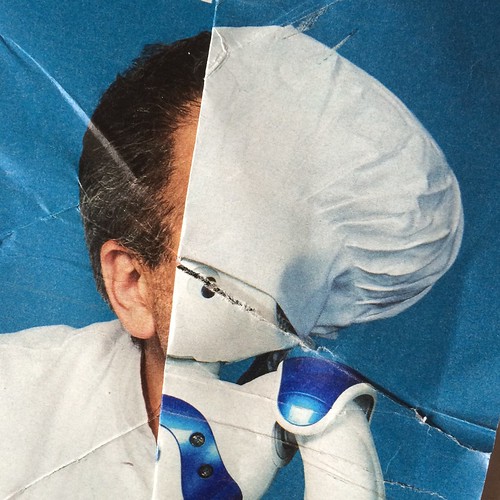
Featured Image: Ubermorgen, “Vote-Auction”, 2000. Installation view from the exhibition “Whistleblower & Vigilantes”
It has been a long time since an exhibition shocked and confused me. In fact, I cannot even remember when it last happened. Yet the exhibition Whistleblowers & Vigilanters has managed to do just that. Curators Inke Arns and Jens Kabisch of the Dortmund art institution Hartware Medienkunst Verein (HMKV) have put up a show in which complete nut cases are presented side by side with political activists, artists and whistleblowers a la Edward Snowden. This makes the exhibition ask for quite some flexibility from the audience. Visitors have to work hard in order to understand the connection made here between, for example, racist conspiracy theories expressed through YouTube videos and the ordeal of a whistleblower like Chelsea Manning.

The very short introduction text to the exhibition guide is part of the puzzle we are presented with. The basic premises of the exhibition are explained in what I think is not the best possible manner, because it leaves out any mentioning or analysis of the huge political differences among the people and works presented. At the same time the use of words like higher law and self-legitimization easily creates a feeling of unease about each practitioner or type of activism in the show:
“The exhibition asks what links hacktivists, whistleblowers and (Internet) vigilantes. What is the legal understanding of these different actors? Do they share certain conceptions? Who speaks and acts for whom and in the capacity of which (higher) law? Among other issues the exhibition will examine the differing legal conceptions and strategies of self-legitimisation put forth by activists, whistleblowers, hackers, online activists and artists to justify their actions.”
By placing the revelations of Edward Snowden next to the complete print out of the manifesto of the Unabomber or (more harmless but still of a different level of impact) the battle over a hostile domain name takeover in Toywar the first impression is a levelling of the practices and people involved. To make some sort of distinction between the various represented rebellious or activist positions in the exhibition guide the whole is divided into sections. The sections however do not indicate socio-political position or relevance, but rather imply the ways people legitimize their actions (1).
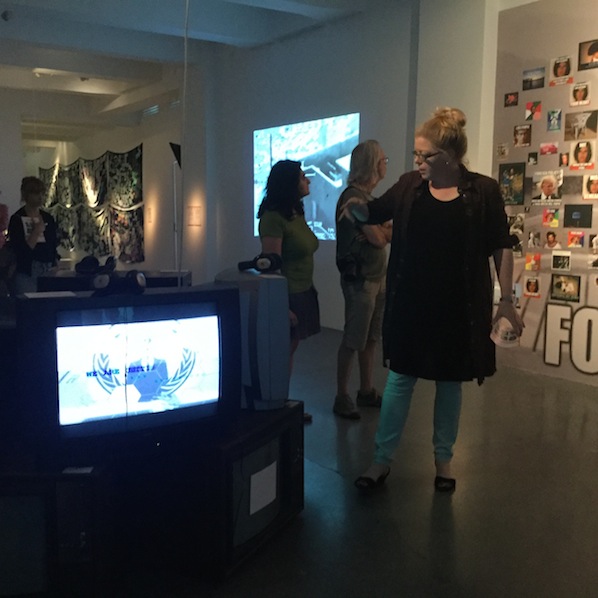
The spatial design and mapping of the exhibition seem to give some indication of political direction, but it is accidental. To the far right of the entry we find all installations labeled ‘Vigilantes’: a website collecting images of online fraudsters (419eater.com), two videos about Anders Breivik and Dominic Gagnon’s collection of mostly right-wing extremist YouTube videos. Slightly controversial is how the Vigilantes section puts together these quite obvious nut cases and criminals with Anonymous and what the curators call ‘Lulz’, the near troll-like jokesters who ridicule anything they don’t like with razor sharp memes. I am not sure whether these two products of the online forum 4chan deserve this simple pairing to YouTube hate preachers. A finer distinction between the various Internet underbelly representatives might have been better here. That this could have been done is shown by Lutz Dammbeck’s archive on the Unabomber’s placement in the Vigilante section, which has two labels. It is the sole representative of the Critique of Technology section as well. Another strange pairing happens in the Antinomism section, where an installation around a video with Julian Assange and a rightwing terrorist bomb disguised as soda machine are the only examples.
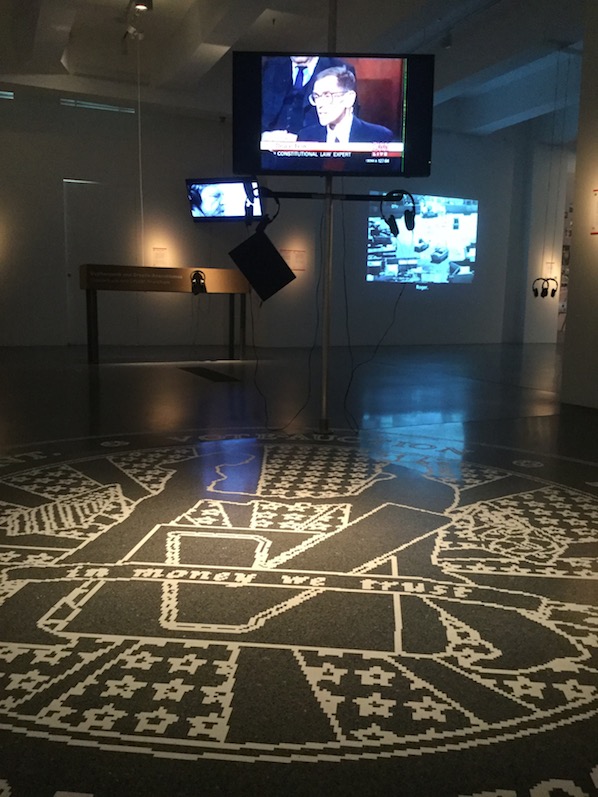
The middle ground of the exhibition shows a mix of artist activism and hacker culture. Mediengruppe Bitnik are here with a video of their Delivery for Mr. Assange. Black Transparency by Metahaven is represented through one utopian architecture model and printed wall cloths. The Peng! Collective’s Intelexit: Call-A-Spy has a telephone stand in the exhibition. The provocative sale of US votes in Vote-Auction by Ubermorgen is here as docu-installation. Etoy’s legendary Toywar is represented as well, with -in my opinion- too small a stand. Traces of many other art works and activist projects are presented in display cases, which give some more background or context to the theme. These were one of my favorite parts of the exhibition, next to the amazingly diligent and meticulous hand-drawn documentation of the Manning trial by Clark Stoeckley.
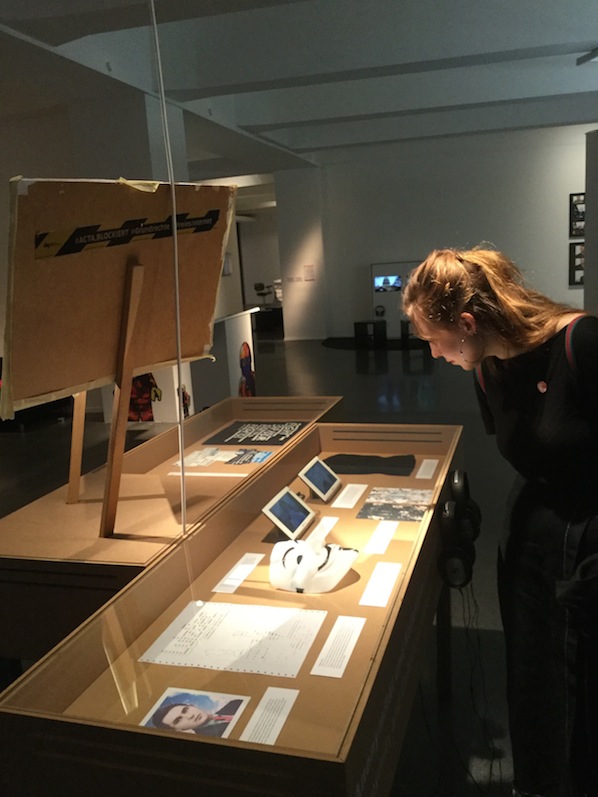
The display cases are dedicated to freedom of speech, tools of online resistance, the Netzpolitik case, anonymity and collective identities and cypherpunk and crypto-anarchism. They provide an important insight into the context within which the other practices in the exhibition exist.
Here we find Luther Blissett, the Italian born collective online identity, with a name borrowed from a former football player. The Blissett identity is related to pre-Internet art practices, in particular Neoism, and has been used for various art pranks and activist projects, particularly in Southern Europe.
Other art projects include the influential book Electronic Civil Disobedience by Critical Art Ensemble, the German hacker art collective Foebud’s battle for free speech and privacy (presented with one of Addie Wagenknecht’s anonymity glasses), and the Electronic Disturbance Theater’s Floodnet. The latter is a DDoS attack software that was used in actions for the Mexican freedom fighters the Zapatistas, by the Yes Men and for Etoy’s Toywar project.
There is also a print out of the Cypherpunk mailinglist. The cypherpunk crypto-anarchist community is responsible for some of the most influential elements of the free Internet. They produced the PGP encryption technology, cryptocurrency such as Bitcoin, TOR, the idea of WIKI and torrent platforms and marketplaces like the Silk Road. Julian Assange was one of its members.
Last but not least the presentation of the Netzpolitik.org case, which covers a German censorship scandal from last year, had to be part of this exhibition. Journalists from the online magazine Netzpolitik were arrested for treason after they had published about classified Internet surveillance plans of the German secret service. A copy of the accusation letter from the state prosecutor is oddly signed with ‘Mit freundlichen Grüßen’ (‘With kind regards’).
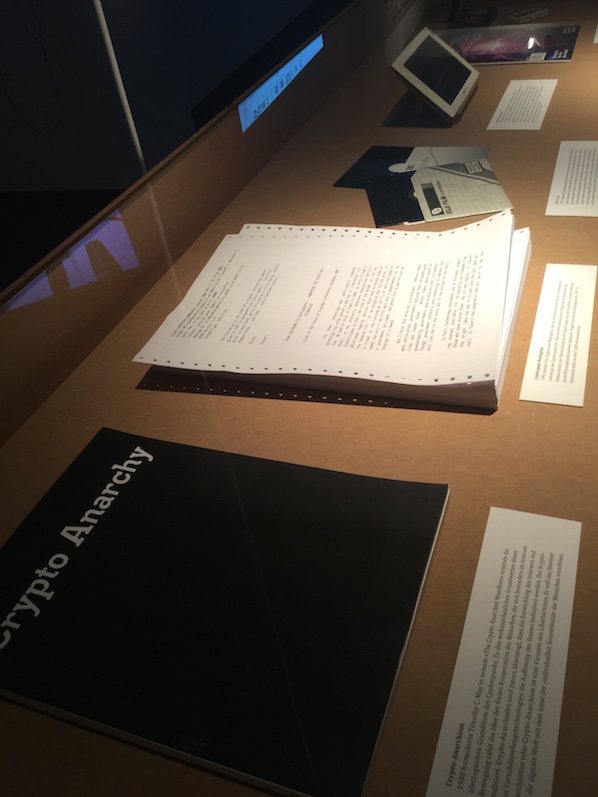
All in all the display cases made me happy to see some of the events and works that have been so hugely influential to the development of the Internet (and thus to the development of our current culture and politics) represented in a physical cultural space. They show a side of Internet culture that is heavily underrepresented in the general discourse around new media technologies in both mainstream media and art. During a private tour of Whistleblowers & Vigilantes for visitors of the simultaneously running Hito Steyerl exhibition Inke Arns explained how for her this exhibition is long overdue as well. According to Arns the threat to our freedom through abuse of new technologies should receive as much attention in art as the anthropocene. HMKV sees it as its responsibility to do something about it.

Whistleblowers & Vigilantes however does not make a straightforward statement. Its structure, both physically and content-wise, is too complex for that. This does not mean it is a bad exhibition. The bringing together of the ‘Lulz’, Anonymous, the Unabomber, net art, hacktivism, hackers and Manning, Snowden, Assange and even Breivik in one space definitely creates a lively exhibition, which cannot leave a visitor unaffected. This strange assembly then needs to be unraveled and this is where the curators take quite some risk. The addition of Hito Steyerl’s installation Factory of the Sun, an exhibition that runs simultaneously on a different floor, could help to bring the serious, crazy and light elements of the show together for that part of the audience that loses its way. In her smart playful manner Steyerl blends science fiction, humor and critique of the surveillance society in a faux holodeck cinema experience. The exhibition also includes a few live events that steer the whole into safe waters. Netzpolitik journalist Markus Beckedahl has given a presentation and so has Jens Kabisch. Kabisch wrote a text about whistleblowers that is available on the website, but this text is unfortunately only available in German. My advice to the non-German audience is to download the press kit in order to get more background information.
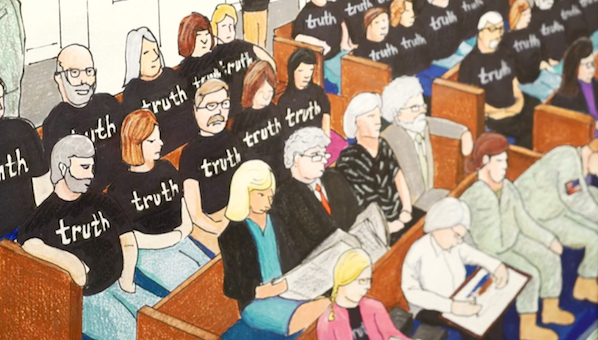
Whistleblowers & Vigilantes is a challenge to the audience. It asks for more reflection and time to take in than most exhibitions. After getting some more grip on it the complexity and scope of the exhibition, however, is impressive. It not only brings together many important, interesting and sometimes scary examples of contemporary forms of resistance and rebellion. What is also represented is the space of resistance and play that escapes attempts at systematic control, even in a full-on surveillance state. Once recovered from my initial shock this is what stayed with me the most. The wide-ranging documents, objects and installations reveal the system’s shadow spaces and vulnerabilities. Whistleblowers & Vigilanters differs from the flood of other art exhibitions themed around surveillance and control by reflecting on the legitimacy of online autonomous political action in general. Indirectly this means it also reflects upon the space of life that exists beyond all control. Rather than create another horror show around the future of privacy and freedom, with Whistleblower & Vigilanten we are presented with the persistence of fringe cultures and of free thinkers. For me this makes this an exhibition of hope.
Whistleblowers & Vigilantes. Figures of Digital Resistance
HMKV, Dortmund
9/4/16-14/8/16
https://www.hmkv.de/_en/programm/programmpunkte/2016/Ausstellungen/2016_VIGI_Vigilanten.php
https://www.hmkv.de/_pdf/Ausstellungsfuehrer/2016_VIGI_Kurzfuehrer_Web.pdf
There is a common sense in place about the fact that civil rights are undermined by a various amount of ‘exceptions’; exceptions which are based on a system, in which governmental decision-making processes are increasingly determined by the rule of money, or else the market. The idea of a constant ‘crisis’ leads to a ‘state of exception’. Regardless of established legal standards – in the name of financial, economical or security measurements – civil rights are constantly taken away. As a result, the social and legal relations between the different members of society and between nation states are increasingly out of balance. This creates an endless pool of watering down legal standards in postdemocratic societies and produces harmful sociopolitical asymmetries. The exhibition “As rights Go By” which took place in freiraum Q21 this spring 14th April – 12th of June 2016 aimed to exactly pinpoint these asymmetries and to unfold the irregularities of a ‘regular legal system’.
The 15 works in the exhibition, curated by Sabine Winkler, focused directly on the complex dynamics between the sources and consequences of disappearing civil rights under the global neoliberal umbrella. The show, which was very well set, had strong internal and external references and what really could struck somebody was the content. The exhibition could be experienced as a single piece, inviting the visitors to discover more more than just the visible tips of the il/legal iceberg and to bring these issues of discussion to schools, universities, festivals, shopping malls and the mainstream media. Of course this doesn’t mean not to exhibit – but it means not to stop there.
As Rights Go By was an exhibition which stays in mind ; the visitors could produce their own individual collages, making sense of the gravity of the problematics involved.
The works presented were the following:
Silvia Becks, who worked with the privileges in the art world, presented an installation which discussed how the special rights in place, like the information accessibilities, the funding resources and the leveling up of the societal status, are at the same time leading to a certain loss of legal rights.

James Bridle, with his video animation “Seamless Transitions”, tried to visualize the physical spaces of the unknown arrest, the legal decision making processes and the juridical judgments involved, offering a virtual insight into the secret spaces of il/legality. His work questioned not only the surveillance strategies of physical space but also the secrecy about trading agreements and legal treaties.

George Drivas’ film‚ “Sequence Error” referred to a typical business setting where a sudden crisis has lead to a collapse. A fictional situation with a more than real deal: The crisis serves as the exception for legal rights to be erased.
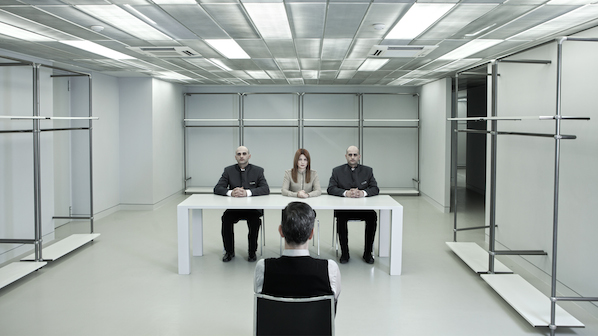
Özlem Günyol and Mustafa Kunt, overlaid the portraits of the hundred wealthiest people of the world fading into one collage of one single passport image projected to the wall. A symbol for lost identities and unidentifiable legal entities.
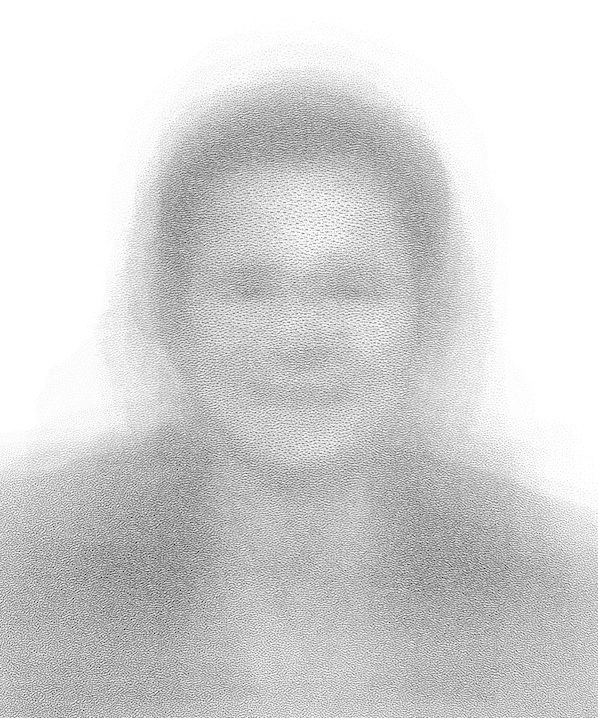
Adelita Husni-Bey video documentation gave a very detailed insight into an urban planning process in Cairo (“Land”) including gentrification processes, which go not only against Egyptian law but actually threaten a huge amount of informal dwellings. The notion ‘participations’, in particular, delivered a learning lesson about contemporary urban development strategies and their methods.
Nikita Kadan used a “Popular Medical Dictionary” of the Soviet era in his work “Procedure Room”. Painting torture methods on ceramic plates, he showed how physical and psychological violence can be justified for a ‘higher’ political order.
The Collective Migrafona reported via Comic strips about the Austrian migration politics. Imaginary Heroes are delivering identities in order fight for political rights.
Vladimir Miladinovic’s research focused on multinational companies and their strong connections to pre- and post-war power structures. His work discussed the power relations, which are in place during setting up regulations between states and their legal standards.
In his film “1014” Yuri Pattison mixed fictional Hollywood scenes with documentary footage from the hotel room where Edward Snowden gave his first interview. The work offered an insight into the conscious loss of legal rights when fiction becomes reality and vice versa.
Lorenzo Pezzani and Charles Heller raised the question about acting against human rights while being aware of the refugee tragedies based on surveillance technology. Their forensic reconstruction of a boat disaster offered a clear insight into the thin borderline between socio political responsibilities and legal settings.
Julien Prévieux work “What Shall We Do Next? 2006-2011“ showed how close technology, law and our bodies are connected; the fact that international corporations obtain patents for specific movements such as scrolling moves on a tablet shows how unaware we are about our daily il/legal routines.
Andrea Ressi related the notion of loss onto her work; loss of living space, loss of rights, loss of freedom, loss of security and represented these losses in her pictograms with modules of exception.
Judith Siegmund’s text based installations produced discomfort. Newspaper quotations about violence against refugees were set up opposite to philosophical text fragments, triggering associations about the relation between violence and competitiveness assuming that people take advantages from others who find themselves in a lawlessness situation.
Lina Theodorou’s project was one of the most intriguing works in the show. Her board game club offered a playful insight into the crisis in Greece and the social and legal consequences of austerity measurements up leading to losing well established rights. The setting would be funny if it wouldn’t be real.

Carey Youngs’ work “Obsidian Contract” transformed the visitor into an affiliate. The public space and the legal space were imagined and lost rights were reconstructed fictionally while watching the contract text through a mirror.
The exhibition did not refer directly to any political action, artivism, hacktivism or any other form of resistance but it implied the embedded hegemonic power structures pointing where it all begins.The exhibition was not a subversive act but it showed how subversion as an act of societal struggle became something illegal. Up to around 15 years ago the notion of ‘subversion’ was relatively easy to connect to counter-cultural productions. But a subversive act wasn’t nesessarily illegal – it was done in a grey shadow light between established settings in order to shake up presumably fixed sociopolitical surroundings. An unclear task under clear conditions.
In the era of global capitalist hegemony, shadows turned straight into black or white areas; no grey is involved anymore. Subversion dissolved into two parts: the legal one, which consists of what is now understood as innovation – or ‘creativity’ as the motor for an ‘idea based economy’- and the illegal one, what now labels all the ‘unwanted’ realities: terror, refugees, homeless; etc. Therefore subversive thinking and acting is no longer part of a cultural discourse but is simply illegal. Why?
The unlimited governmental practices which are today in place show that decisions are made as it happens in the financial markets; everything becomes a derivate, something to speculate with. The future has consequences on the present before anything happens. In times where potentials are seen as threats, the subversive process is turned upside down: subversions themselves become clearly defined and legal settings are turned into grey areas. A clear task under unclear conditions.
The exhibition encouraged, motivated and gave an insight into the power of rights including the absence of it. Focusing on how rights are either set or (il/legally) undermined by their exceptions and on how well these tendencies are sold as (inter)national necessities, it underlined the urge for a collective awareness of these i/legal practices and their consequences.
‘As Rights Go By’ was a very important exhibition; as mentioned above – what was visible was just the tip of the iceberg. As in many shows which include a huge amount of artistic research, a retrospective view in the future will show that this is just the beginning of a different kind of political engagement which most of all is a call for action.
Rights go by and are not falling from the sky.
Featured Image: With 69.numbers.suck by Browserbased
Athens Digital Arts Festival (ADAF) returned this year on the 19th to the 22nd of May with its 12th edition to bring Digital Pop under the microscope. Do machines like each other? Does the Queen dream of LSD infused dreams and can a meme be withdrawn from the collective memory?
Katerina Gkoutziouli, an independent curator and this year’s program director together with a team of curators proposed a radical rethinking of digital POP, placing the main focus on the actors of cultural production. From artists to users and then to machines themselves, trends and attitudes shift at high speed and the landscape of pop culture is constantly changing. What we consider POP in 2015 might be outdated in 2016, as the Festival’s program outlines, and that is true. But even so, in the land of memes, GIFs, likes, shares and followers what are the parameters that remain? ADAF’s curatorial line took it a step further and addressed not just the ephemerality of digital POP. It tackled issues related to governance and digital colonialism, but in a subtle and definitively more neon way.
450 artists presented their work in a Festival that included interactive and audiovisual installations, video art, web art, creative workshops and artist talks. Far from engaging in the narrative of crisis as a popular trend itself though, ADAF 2016 was drawn to highlighting the practices that reflect the current cultural condition. And the curated works were dead-on at showcasing those.

How are we “feeding” today’s digital markets then? Ben Grosser’s sound and video installation work “You like my like of your like of my status” screened a progressive generative text pattern of increasingly “liking” each others “likes”. Using the historic “like” activity on his own Facebook account, he created an immersive syntax that could as well be the mantra of Athens Digital Arts Festival 2016.
Days before the opening of the exhibition, Ben Grosser was asked by to choose the image that defines pop the most. No wonder, he replied with the Facebook “like” button. What Ben Grosser portrayed in his work is the poetics of the economy of corporate data collectors such as Facebook with its algorithmic representation of the “Like” button as the king pawn of its toolkit, that transform human intellect as manifested through the declaration of our personal taste and network into networking value.
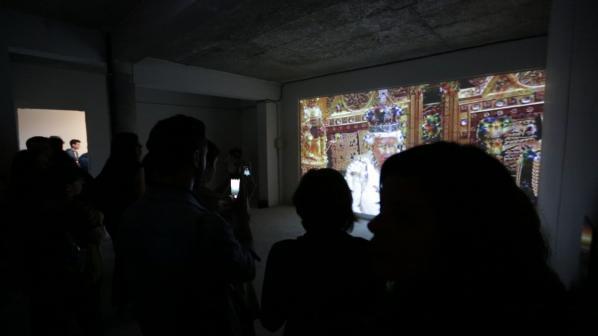
Speaking of taste, what about the aesthetics? From Instagram and Snapchat filters to ever updated galleries of emoticons available upon request, digital aesthetics are infused with social significance. In the Queen of The Dream by Przemysław Sanecki (PL) the British politics and the Royal tradition were aestheticized by the DeepDream algorithm of Google. In an attempt to relate old political regimes and established technocracies, the artist places together hand in hand the political power with the algorithmical one, pointing out that technologies are essential for ruling classes in their struggle to maintain the current power balance. The representation of the latter was placed there as a reminder that it’s dynamic is to obscure this relation, rather than illuminate it.
However, could there be some space for some creative civil disobedience? Browserbased took us for a stroll in the streets of Athens, or better to say in the public phone booths of Athens. There, the city scribbles every day its own saying, phone numbers for a quick wank, political slogans, graffiti, tags and rhymes. With 69.numbers.suck Browserbased mapped the re-appearance and cross-references of those writings, read this chaotic network of self-manifestation and reproduced it digitally in the form of nodes. Out there in the open a private network emerged, nonsensical or codified, drawn and re-drawn by everyday use, acceptance and decline.
Can virality kill a meme? Yes, there is a chance that the grumpy cat would get grumpier once realized that its image would be broadcasted, connoted and most possibly appropriated by thousands. But how far would it go? The Story of Technoviking by Matthias Fritsch (DE) was showcased at the special screenings session of the Festival. It is a documentary that follows an early successful Internet meme over 15 years from an experimental art video to a viral phenomenon that ends up in court. Once the original footage was uploaded, it remained somehow unnoticed until some years later that it was sourced, shared, mimified, render into art installation, even merchandised by users. As a cultural phenomenon with high visibility it fails to be deleted both from servers around the world and from the collective memory even though that this was a court’s decision. In his work Matthias Fritsch mashes up opinions of artists, lawyers, academics, fans and online reactions marking the conflict between the right of the protection of our personality to the fundamental right of free speech and the direction towards which society and culture will follow in the future in regard to the intellectual property.

It’s the machines alright! Back in the days of Phillip K. Dick’s novels the debate was set over distinctions between human and machine. Since then the plot has thickened and in memememe by Radamés Ajna (BR) and Thiago Hersan (BR) things were taken a step further. This installation, situated in one of the first rooms of the exhibition, of two smartphones seemingly engaged in a conversation between them through and incomprehensible language built on camera shots and screen swipes is based on the suspicion that phones are having more fun communicating than we are. Every message is a tickle, every swipe a little rub. In memememe the fetichized device was not just a mechanic prosthesis on the human body, it was an agent of cultural production. The implication that the human might not cause or end of every process run by machines was promoted to a declaration. Ajna and Hersan have built an app that allows as a glimpse into the semiotics of the machine, a language that we can see but we can’t understand.
How many GIFs fit in one hand? If one were to trace all subcultures related to pop culture, then he or she would have to stretch time. Since they are multiplying, expiring and subcategorized not by theorists but by the users themselves and with their ephemerality condemning most of which into a short lived glory. Lorna Mills (CA) explores the different streams in subcultures through animated GIFs and focuses on found material of users who perform online in front of video cameras. In her installation work Colour Fields she is obsessed on GIF culture, its brevity, compression, technical constraints and its continued existence on the Internet.
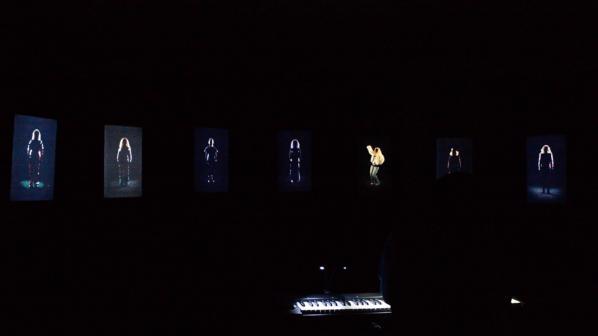
Global pop stars, a blueprint on audience development. Manja Ebert (DE) in her interactive video installation ALL EYES ON US, one of the biggest installations of the Festival, embarked on an artistic analysis of the global pop star and media phenomenon Britney Spears. Based on music videos of the entertainer that typecast Spears into different archetypical female characters, Ebert represented each and every figure by a faceless performer. All nine figures were played by a keyboard, thus allowing the users to recompose these empty cells decomposing Spears as a product into its communicational elements.
Going through the festival, more related narratives emerged. Privacy and control, the representation of the self and the body were equally addressed. People stopped in front of the Emotional Mirror by random quark (UK/GR), to let the face recognition algorithm analyze their facial expression and display their emotion in the form of tweets while they were photographing and uploading in one or more platforms the result at the same time.
Τhe Festival presented its program of audiovisual performances at six d.o.g.s. starting on May 19 with the exclusive event focus raster-noton, featuring KYOKA and Grischa Lichtenberger.
ADAF 2016 brought a lot to the table. Its biggest contribution though lies in offering a great deal of stimuli regarding the digital critical agenda to the local digital community. ADAF managed to surpass the falsely drawn conception of identifying the POP digital culture just as a fashionable mainstream. On the contrary it highlights it as a strong counterpoint.
Featured Image: Julian Rosefeldt Manifesto, 2014/2015 ©VG Bild-Kunst, Bonn 2016
Entering the darkened gallery space in the side wing of Berlin`s Hamburger Bahnhof – Museum für Gegenwart, the visitor first encounters a projection showing the close-up of a fuse cord burning in the dark. Shot out of focus its sparks are flying in slow motion, a firm clear female voice comes in beginning a monologue which includes familiar lines and passages: “I am against action; for continuous contradiction, for affirmation too, I am neither for nor against and I do not explain because I hate common sense. […] All that is solid melts into air. […] I am writing a manifesto because I have nothing to say.”. The fuse cord gradually exstinguishes without leading to an explosion.
Quoting parts of the manifesto of the Communist Party, Tristan Tzara`s Dada Manifesto as well as pieces of Philippe Soupault`s “Literature and the Rest”, the 4-minute video in its function as “Prologue” sets the tone of Julian Rosefeldt`s exhibition “Manifesto”. The opulent 13-channel installation is a homage to the textual form of the artist manifesto – in Rosefeldt´s words “a manifesto of manifestos”. Inspired by the research for his previous work “Deep Gold”, Rosefeldt began looking further into the genre and its poetics. From about sixty popular art manifestos – the earliest from 1848, the latest from 2004 – he collaged twelve new powerful and entertaining manifestos. Said manifestos serve as the source for each of the thirteen videos (a prologue and 12 scenarios) delivered and performed as monologues by Oscar-winning actress Cate Blanchett.
In every film, an extremely versatile Blanchett morphs into another role: From homeless man to broker, newsreader to punk, puppeteer or scientist. Obviously these roles do not represent the manifesto`s authors, they rather show contemporary types chosen by the artist to counterpoint or stress the ideas and attitudes of the text passages they are reciting. As a CEO at a private party, Blanchett is orating in front of an affluent audience, praising “the great art vortex”. Continuing her celebratory speech, she changes the tone to amuse her crowd quoting more passages of the Vorticist manifesto: “The past and future are the prostitutes nature has provided.”. Polite laughter, glasses are clinging. Another scene shows a bourgeois American family sitting at the dining table about to say grace. Blanchett in the role of the conservative mother is leaning her head, folding her hands but instead of the usual blessing, she begins to fervently recite Claes Oldenburg`s Pop Art Manifesto which consists of a series of propositions starting with “I am for an art …” and includes such gems as: “I am for an art that is political-erotical-mystical, that does something other than sit on its ass in a museum.” or “I am for the white art of refrigerators and their muscular openings and closings.”.

All 10-minutes-long videos in the exhibition work according to the same principle: the art manifesto collages are delivered as monologues by Blanchett at first in voice-over introducing the scene, then in filmed action and at its climax as speech to camera. Shown in parallel and installed without spatial division, the monologues interfere with one another, and the visitor is always confronted with more than one narration. While watching Blanchett in the role of a primary school teacher softly correcting her pupils quoting Jim Jarmusch: “Nothing is original. Steal from anywhere that resonates with inspiration or fuels your imagination.”, one can at the same time hear her in the role of an eccentric choreographer slamming the rehearsal of a dance ensemble with the words of Yvonne Rainer, “No to style. No to camp. No to seduction of spectator by the wiles of the performer.” From somewhere else the sound of a brass band appears, introducing the funeral scene in which Blanchett is holding a eulogy consisting of a collage of several Dada manifestos. Sounds and voices overlap and compete for attention until a point in each video when all characters in sync turn towards the camera falling into a chorus-like liturgical chant, filling the dark gallery space with a polyphony – or cacophony – of interfering monologues. It is an impressive experience, but simultaneously the installing method makes it very hard to concentrate on words and ideas expressed in the manifestos.
In general, the exhibition and each of the videos are aesthetically pleasing and entertaining to watch, which is equally due to the scenography with its amusing artifices, the strong selection of text passages as well as its its star power. Rosefeldt´s opulent, multi-layered and choreographed installation blurs the lines between narrative film and visual art. Commissioned by a unique group of partners that include the Australian Centre for the Moving Image, the Art Gallery of New South Wales, Hamburger Bahnhof and Hanover `s Sprengel Museum, “Manifesto” is in no way inferior to most cinematic productions made in Hollywood. But here´s the problem: Although Rosefeldt claims in his intro text and again in the video interview accompanying the exhibition online, that he wanted to emphasize and celebrate the literary beauty and poetry of artist manifestos, the texts are outshined by the cinematic staging of actress, setting and choreography of space. The attention of the viewer is drawn to speaker and theatrical performance, instead of focusing on the poetics and messages contained in each one of the thirteen art manifesto texts.
Another stylistic element that Rosefeldt uses attempting to highlight the manifesto texts is creating tension between text and image. Most of the settings and characters in “Manifesto” deliberately break with the performed text, which can for example be witnessed in the scene of the conservative mother reciting Oldenburg. Both were conceived by Rosefeldt to intensify the contrast between the rebellious rhetoric, idealism and radical notions of the manifesto form and the realities of today´s world. This does not work out at all times, sometimes the performances seem so exaggerated that they tip over and border on the ridiculous, the staging turns into travesty. It reinforces the impression that the exhibition is not in the first place about the texts, their content and reflective presentation, but rather aimed at the maximum achievable effect. But Rosefeldt succeeds in his intention to show how surprisingly current the demands of some of the manifestos presented are, most of them written in the 20th century. A century which was defined by historian Eric Hobsbawm as the short century and “The Age of Extremes” which saw the disastrous failures of state communism, capitalism, and nationalism. The world has more or less continued to be one of violent politics and violent political changes, and as Hobsbawm writes most certainly will continue like that.

So it is no wonder that the manifesto, also serving as a signal of crisis, is experiencing a revival. With the internet as an easy means of dissemination, the manifesto form has been revisited by a great number of single artists and artist activist groups, it spread out in every niches of the art world, and was adapted by academia and beyond. So when Rosefeldt in his statements nostalgically praises texts from the “Age of Manifestos” and states that he misses this thoughts focus in today´s discourses, one cannot but wonder if he missed the current debates sparked by texts like the “#ACCELERATE MANIFESTO for an Accelerationist Politics”, “The Coming Insurrection” by the anonymous Invisible Committee, “Xenofeminism: A Politics for Alienation” authored by Laboria Cuboniks collective or texts by individual artists like Hito Steyerl which became important points of reference.
Rosefeldt´s selection of manifesto texts seems random and inconsistent with his expressed intentions: Why was the manifesto of the Communist party included in an assortment of art manifestos? Or why were Jim Jarmusch`s “Golden Rules of Filmmaking” from 2002 and Sturtevant`s ”Man is Double Man is Copy Man is Clone” from 2004 chosen in a selection concentrating on 20st century texts? Instead of concentrating on canonic art movements and a few single artists, it would been more convincing to reflect how the art field since then has been trying to re-position itself within the shifting boundaries of activism, technology and aesthetics. With a subjective selection of simply “the most fascinating, and also the most recitable” texts, “Manifesto” is caught up in an acritical nostalgia to the disadvantage of coherence and focuses rather on text as performance as on persuasive messages and reflection.
As Mary Ann Caws in her anthology “Manifesto: A Century of Isms” states, the manifesto is “a document of an ideology, crafted to convince and convert”. Naturally, there also is some discomfort with or even suspicion of the manifesto form. The obvious example being the Futurists, who in their manifesto glorified speed, machinery and war. Their text largely influenced the ideology of fascism which they supported in the run up to World War II. In the exhibition, the macho-male tone of the Futurist manifestos fittingly and amusingly is performed by Cate Blanchett in the role of a female stockbroker. Rosenfeldt met Marinetti`s dream of an engineered society showing us the violent creator and destroyer financial capitalism.
Julian Rosefeldt. Manifesto
Curated by Anna-Catharina Gebbers & Udo Kittelmann
10.02.2016 to 10.07.2016
Hamburger Bahnhof – Museum für Gegenwart – Berlin
http://www.smb.museum/en/museums-institutions/hamburger-bahnhof/exhibitions/detail/julian-rosefeldt-manifesto.html
Featured Image: Gerald Raunig, Dividuum, Semiotext (e)/ MIT Press
Gerald Raunig’s book on the concept and the genealogy of “dividuum” is a learned tour de force about what is supposed to be replacing the individual, if the latter is going to “break down” – as Raunig suggests. The dividuum is presented as a concept with roots in Epicurean and Platonic philosophy that has been most controversially disputed in medieval philosophy and achieves new relevance in our days, i.e. the era of machinic capitalism.
The word dividuum appears for the first time in a comedy by Plautus from the year 211 BC . “Dividuom facere” is Ancient Latin for making something divisible that has not been able to be divided before. This is at the core of dividuality that is presented here as a counter-concept to individuality.
Raunig introduces the notion of dividuality by presenting a section of the comedy “Rudens” by Plautus. The free citizen Daemones is faced with a problem: His slave Gripus pulls a treasure from the sea that belongs to the slave-holder Labrax and demands his share. Technically the treasure belongs to the slave-holder, and not to the slave. Yet, in terms of pragmatic reasoning there would have been no treasure if the slave hadn’t pulled it from the sea and declared it as found to his master. Daemones comes up with a solution that he calls “dividuom facere”. He assigns half of the money to Labrax, who is technically the owner, if he sets free Ampelisca, a female slave whom Gripus loves. The other half of the treasure is assigned to Gripus for buying himself out of slavery. This will allow Gripus to marry Ampelisca and it will also benefit the patriarch’s wealth. Raunig points out that Daemones transfers formerly indivisible rights and statuses – that of the finder and that of the owner – into a multiple assignment of findership and ownership.
We will later in the book see how Raunig sees this magic trick being reproduced in contemporary society, when we turn or are turned into producer/consumers, photographers/photographed, players/instruments, surveyors/surveyed under the guiding imperative of “free/ voluntary obedience [freiwilliger Gehorsam]”.
The reader need not be scared by text sections in Ancient Greek, Ancient Latin, Modern Latin or Middle High German, as Raunig provides with translations. The translator Aileen Derieg must be praised for having undertaken this difficult task once more for the English language version of the book. It can however be questioned whether issues of proper or improper translation of Greek terms into Latin in Cicero’s writings in the first century BC should be discussed in the context of this book. This seems to be a matter for an old philology publication, rather than for a Semiotext(e) issue.
It is, however, interesting to see how Raunig’s genealogy of the dividuum portraits scholastic quarrels as philosophic background for the development of the dividuum. With the trinity of God, Son of God and the Holy Spirit the Christian dogma faced a problem of explaining how a trinity and a simultaneous unity of God could be implemented in a plausible and consistent fashion. Attempts to speak of the three personae (masks) of God or to propose that father, son and spirit were just three modes (modalism) of the one god led to accusations of heresy. Gilbert de Poitiers’ “rationes” were methodological constructions that claimed at least two different approaches to reasoning: One in the realm of the godly and the other in the creaturely realm. Unity and plurality could in this way be detected in the former and the latter realm respectively without contradicting each other. Gilbert arrives at a point where he concludes that “diversity and conformity are not to be seen as mutually exclusive, but rather as mutually conditional.” Dissimilarity is a property of the individual that forms a whole in space and time. The dividual, however, is characterized by similarity, or in Gilbert de Poitiers’ words: co-formity. “Co-formity means that parts that share their form with others assemblage along the dividual line. Dividuality emerges as assemblage of co-formity to form-multiplicity. The dividual type of singularity runs through various single things according to their similar properties. … This co-formity, multi-formity constitutes the dividual parts as unum dividuum.”
In contemporary society the one that can be divided, unum dividuum, can be found in “samples, data, markets, or ‘banks’”. Developing his argument in the footsteps of Gilles Deleuze, Gerald Raunig critically analyses Quantified Self, Life-Logging, purchases from Amazon, film recommendations from Netflix, Big Data and Facebook. “Facebook needs the self-division of individual users just as intelligence agencies continue to retain individual identities. Big Data on the other hand, is less interested in individuals and just as little interested in a totalization of data, but all the more so in data sets that are freely floating and as detailed as possible, which it can individually traverse.” In the beginning “Google & Co. tailor search results individually (geographical position, language, individual search history, personal profile, etc.” The qualitative leap from individual data to dividual data happens when the ”massive transition to machinic recommendation [happens], which save the customer the trouble of engaging in a relatively undetermined search process.” With this new form of searching the target of my search request is generated by my search history and by an opaque layer of preformatted selection criteria. The formerly individual subject of the search process turns into a dividuum that is asking for data and providing data, that is replying to the subject’s own questions and becomes interrogator and responder in one. This is where Gilbert de Poitiers’ unum dividuum reappers in the disguise of contemporary techno-rationality.
Raunig succeeds in creating a bridge from ancient and medieval texts to contemporary technologies and application areas. He discusses Arjun Appadurai’s theory of the “predatory dividualism”, speculates about Lev Sergeyevich Termen’s dividual machine from the 1920s that created a player that is played by technology, and theorizes on “dividual law” as observed in Hugo Chávez’ presidency or the Ecuadorian “Constituyente” from 2007. The reviewer mentions these few selected fields of Raunig’s research to show that his book is not far from an attempt to explain the whole world seamlessly from 210 BC to now, and one can’t help feeling overwhelmed by the text.
For some readers Raunig’s manneristic style of writing might be over the top, when he calls the paragraphs of his book “ritornelli”, when he introduces a chapter in the middle of his arguments that just lists people whom he wants to thank, or when he poetically goes beyond comprehensiveness and engages with grammatical extravaganzas in sentences like this one: “[: Crossing right through space, through time, through becoming and past. Eternal queer return. An eighty-thousand or roughly 368-old being traversing multiple individuals.”
It is obvious that Gerald Raunig owes the authors of the Anti-Œdipe stylistic inspirations, theoretical background and a terminological basis, when he talks of the molecular revolutions, desiring machines, the dividuum, deterritorialization, machinic subservience and lines of flight. He manages to contextualise a concept that has historic weight and current relevance within a wide field of cultural phenomena, philosophical positions, technological innovation and political problems. A great book.
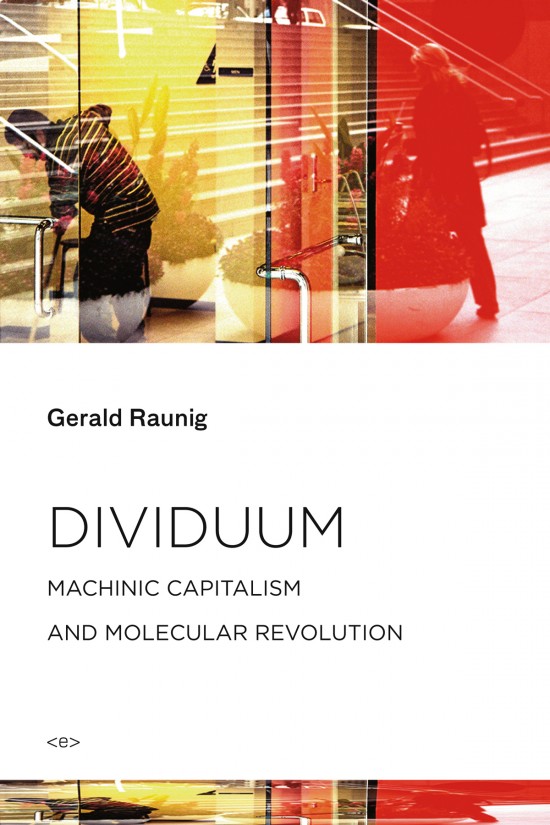
Dividuum
Machinic Capitalism and Molecular Revolution
By Gerald Raunig
Translated by Aileen Derieg
Semiotext(e) / MIT Press
https://mitpress.mit.edu/books/dividuum
Artists to my mind are the real architects of change,
and not the political legislators who implement change after the fact
(William S. Burroughs)
A large-scale model of a CCTV camera made from recycled cardboard peers through the window of the Seventeen Gallery out onto Belmont Street in Aberdeen, alive with passers by. This is the main piece of Under New Moons, We Stand Strong (2016), the project conceived and designed by Teresa Dillon to prompt reflections on solidarity, literacy and symbolism within digital civic governance.
If one gets close enough, it is evident that the eye of this camera is blind for there is no actual watching and recording apparatus inside. Still, the sensation of being watched remains. Bird spikes are mounted on top of the camera. The first thing one notices is the scale of the model: for the first time, what is an almost impalpable and invisible presence (surveillance technologies tend to be increasingly difficult to spot in the urban space) gets amplified, taking a physical presence that invites us to explore our personal relationship with surveillance and the multiple technologies that embody it.
The enlarged cardboard CCTV camera not only reminds passers-by of surveillance, its visual presence, eye to eye and the size of an other, functions to interpellate the viewer as an active gazer. Instead of us being the object of its gaze, the large-scale model allows us to look at the CCTV camera up-front. The exchange of gazes between the two subjects, the surveillance apparatus and ourselves, occurs on an equal level: we occupy a position that is not anymore subservient to the mechanical all-seeing-eye. In the act of looking at the CCTV cardboard model, we can also recognise our own complicit capacity to become overseers.
Teresa Dillon’s installation invites us to become aware of the change occurred in contemporary social and technological developments in the relationship between surveillance and society. This change is subtler than it might appear at first. The Panopticon, Bentham’s prison architecture, was discussed by Foucault in his Discipline and Punish: The Birth of the Prison (1975) as an exemplar, among others examined in the book, of the mechanisms of social control that become permanent and interiorised. The prisoners, in fact, have no need to be actually watched, they know that they might be being watched. The condition of being potentially under surveillance transforms the dynamics of the gaze, causing an interiorisation of the watchtower’s gaze, in such a way that the prisoner becomes her own overseer.
Surveillance studies have pointed out how the Foucauldian metaphor of the Panopticon fails to describe the multi-faceted contemporary figurations of surveillance. It is not anymore a matter of keeping the prisoners in a certain space, but much more of keeping them away. The movement from the Panopticon to the Banopticon, for example, exemplifies the attempt to use profiling techniques to determine who should be placed under surveillance for security purposes. The Banopticon can be described as the attempt to keep away certain social groups (asylum seekers, migrants, suspected terrorists) in the context of global security and border control. This ban, interestingly, is not exercised exclusively upon certain groups or in extraordinary circumstances, but also upon those individuals who do not have the resources (for example credit cards and smartphones) to promptly respond to the enticement of consumer spaces such as shopping malls.
We need to take responsibility for the way in which we exercise the power to look. This was the sense of the two talks arranged as part of Urban Knights, a program of events conceived to provoke and promote practical approaches to urban governance and city living by bringing together people who are actively producing alternatives to our given city infrastructures, norms and perceptions. Programmed during the opening of Under New Moons, We Stand Strong, the first talk saw Keith Spiller, a lecturer in criminology at Birmingham City University, discussing state surveillance and individual rights in the context of his practical experiences of accessing CCTV data in London. Heather Morgan, a Research Fellow at the Health Services Research Unit, University of Aberdeen, presented her on-going research on sousveillance (in the context of health self-monitoring wearable technologies). In the middle of our smart cities, caught up in the illusion of being in control of smart technologies we are actually constructing our own prison.
Dillon’s interventions successfully unfold what the two talks left implicit at theoretical level, that is the passage from Foucauldian surveillance to “surveillant assemblage”. Deleuze’s and Guattari’s concept of surveillant assemblage makes visible processes in which information is first abstracted from human bodies in data flows and then reassembled as “data doubles” (Deleuze and Guattari 1987). Thus, a new type of body is formed, whose flesh is pure information transcending corporeality. The body is an assemblage, comprised of component parts and processes that need to be observed. Moving away from a hierarchical top-down gaze, in a rhizomatic-fashion, surveillance expands in multiple fractured forms.
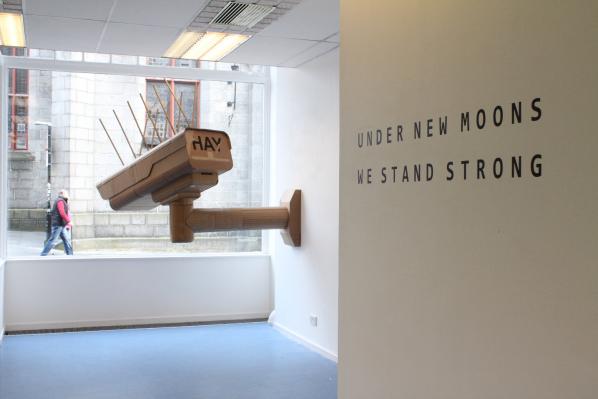
Going back to Dillon’s installation, on the gallery wall there is a digital print portraying a snowy owl in mid-air flight. This is a special edition print related to an episode on January 3rd, 2016 in Quebec, where a CCTV camera captured a stunning image of a snowy owl in mid-air flight. Four days later the images were tweeted by Quebec’s Transport Minister and went viral, turning the snowy owl into an “Internet star”. In Greek mythology the owl represents or accompanies Athena, the goddess of wisdom – and military strategy. Curiously, the next generation of surveillance technologies developed by the United States military bears the names of Greek mythological creatures. Argus Panoptes, which recalls the all-seeing giant monster with a hundred eyes, is a monitoring system that allows the constant surveillance of a city. Gorgon Stare, an array of nine cameras attached to an aerial drone, takes the name of the monstrous feminine creature whose appearance would turn anyone who laid eyes upon it to stone.
The owl is a highly metaphorical and yet ambiguous presence in the exhibition. On the one hand, the owl symbolises knowledge, wisdom and perspicacity. With its appearance, “flying only with the falling of the dusk” to paraphrase and transpose the famous passage from Hegel where the owl incarnates the appearance of philosophical critique and appraisal, the owl of Minerva (the Roman goddess identified with Athena) makes explicit the ideas and beliefs that drove an era but could not be fully articulated until it was over. Therefore, the owl is revealing something to us about our own epoch – it is our task to decipher the content of the message.
On the other hand, the owl is also the physical medium through which collaborative interspecies strategies of resistant actions to surveillance can be organised. Dillon’s techno-civic intervention, as the artist herself calls her work, is ideally connected to another artistic project, Pigeonblog, made by Beatriz da Costa, artist, academic and activist, member of the Critical Art Ensemble and graduate student of philosopher and science and technology scholar Donna Haraway. Pigeonblog was a grassroots initiative designed to collect and spread information about air quality to the public. Pigeons were equipped with small air pollution sensing devices capable of gathering data on pollution levels. The data could be then visualised and accessed by means of Internet (da Costa and Kavita 2008). Da Costa’s Pigeonblog was inspired by a photograph depicting a technology developed in Germany during wartime but then never implemented: a small camera, carried by a pigeon and set on a timer, was designed to take pictures at regular intervals of time as pigeons flew over specific regions of interest – possibly military targets. Pigeons were participating agents in this early surveillance technology system. Da Costa resuscitated that idea to create a surveillant assemblage formed by a living animal and technology but with civilian and activist goals.
By means of this mythological creature, the owl, Teresa Dillon asks us to learn to look at those technologies of surveillance, to re-adjust our gaze in order to be ready to face them upfront. The role played by mythology is evident not only in the installation but in the procession that accompanied the exhibition on Saturday May 7th. The public were invited to gather together and take part in a “forensic anthropological walk”, as the artist labelled it, throughout the city of Aberdeen, with participants holding hand-held models of two-dimensional CCTV cameras. Stopping in front of the CCTV cameras encountered in Castle Square during the walk, the artist revisited the world history of CCTVs, starting from the first documented use of surveillance cameras in Germany in 1942 for the documentation of Test Stand VII, the V-2 rocket testing facility, through the introduction of CCTVs in the urban landscape in the US in 1968, and more recent examples of surveillance technologies in the UK.
Dillon blends story-telling techniques with an emotional urban cartography created by means of walking together. Namely, the walk cannot be described in the guise of a city tour: the performative element transformed the walk into a procession, a collective rite, consumed on the Aberdeen beach where the paper cameras were set alight by participants. The history of surveillance technologies is in fact interwoven with mythological, symbolic and ritual elements, from the owl to the closing ceremony on the beach. Like in Cities of the Red Night, written by Beat Generation novelist William S. Burroughs, Dillon’s multiple interventions combines history with rituals and performance to evoke magical elements, doomsday scenarios and our phobias about the powers that control and enslave us.
The different interventions conceived and designed by the artist (the artwork itself, the performance, the walking tour through the city, the talks that accompanied the opening of the exhibition) can be read as artistic enactments of the cut-up and fold-in literary technique used to re-arrange and combine the pieces of a text to form new narratives. The technique can be traced back to the Dadaists of the 1920s. It was then popularised by Burroughs in the 1960s as a radical and creative method of socio-political subversion. It is evident that the cut-up and fold-in technique can be applied to contexts other than literature as Dillon demonstrates. It helps overcoming conventional associations (in this case, surveillance as a merely technological apparatus) to create new ones (the literacy infrastructure of surveillance), transforming the reader/player/visitor from a passive consumer of other people’s ideas into the architect of her own knowledge and action.
Under New Moons, We Stand Strong allows citizens to become not only more aware of the technological power infrastructure at work in our cities but also to learn how to read it, confront it, possibly resist it. The beach, at the outskirt of the urban space, a liminal site, nowadays often associated with the refugees crisis, becomes a space of freedom and catharsis. To set the cardboard cameras alight is, simultaneously, an act imbued with mythology – Prometheus’ gift of fire, the first techne, to humankind for their survival – and a collective gesture of transformation and renewal. Having freed ourselves from the idols, from all-seeing eyes, we can stay up-front, together, as a community, to face the darkness of our time.
Seventeen, Art Centre, 17 Belmont St, AB10 1JR, Aberdeen
Supported by Scotland’s Festival of Architecture, Peacock Arts Centre & Aberdeen City Council
Date: Thurs 5 – Sat 28 May 2016
Location: Seventeen, 17 Belmont St, AB10 1JR, Aberdeen
Opening: Thurs, 5 May, 6pm with special edition of Urban Knights
Procession: Sat 7 May, 8pm from Seventeen, 17 Belmont St, AB10 1JR, Aberdeen
Credits
Model & assistance: Jana Barthel
Commissioned by: Festival of Architecture, Scotland, 2016; Peacock
Visual Arts, Aberdeen & Seventeen Gallery, Aberdeen
What does the comic book heroine Wonder Woman have to do with the lie detector? How is the Situationists’ dérive connected to Google Map’s realtime recordings of our patterns of movement? Do we live in Borges’ story “On Exactitude in Science” where the art of cartography became so perfect that the maps of the land are as big as the land itself? These are the topics of the Nervous Systems exhibition. Questions that are pertinent to the state of the world we are in at this moment.
The motto “Quantified life and the social question” sets the frame. Science started out as a the quantification of the world outside of us, but from the 19th century onwards moved towards observing and quantifying human behaviour. What are the consequences of our daily life being more and more controlled by algorithms? How does it change our behaviour if we are caught up in a feedback loop about what we are doing and how it relates to what others are doing? Does this contributed to more pressure towards a normalized behaviour?
These are just some of the questions that come to mind wandering around the densely packed space. You have to bring enough time when you visit “Nervous systems” – it is easy to spend the whole day watching the video works and reading the text panels.
There are three distinct parts: the Grid, Triangulation and the White Room. Each treats these questions from a different perspective. The Grid is the art part of the show and features younger artists like Melanie Gilligan with her video series “The Commons Sense” where she imagines a world where people can directly experience other people’s feelings. In the beginning this “patch” allows people to grow closer together, increasing empathy and togetherness, but soon it becomes just another tool for surveillance and optimizing of work flows in the capitalist economy – an uncanny metaphor of the internet.

The Swiss art collective !Mediengruppe Bitnik rebuilt Julian Assange’s room in the Ecuadorian Embassy – including a treadmill, a Whiskey bottle, Science Fiction novels, mobile phone collection and server infrastructure – all in a few square metres. The installation illustrates the truism that history is made by real people who eat and drink and have bodies that are existing outside of their role they are known for. Which is exactly why Assange is confined since 2012 without being convicted by a regular court.
The NSA surveillance scandal does not play a major part in the exhibition as the curators – Stephanie Hankey and Marek Tuszynski from the Tactical Technology Collective and Anselm Franke, head of the HKW’s Department for Visual Arts and Film – rather concentrate on the evolution of methods of quantification. For this reason we are not only seeing younger artists who directly deal with data and its implications but go back to conceptual art and performance in the 1970s and earlier.
The performance artist Vito Acconci is shown with his work “Theme Song” from 1973 and evokes the Instagram and Snapchat culture of today by building intimate space where he pretends to secrets with the audience. Today he could be one of the Youtube ASMR stars whispering nonsense in order to trigger a unproven neural reaction.
Harun Farocki’s film “How to live in the FRG” on the other hand shows how society already then used strategies of optimization in order to train the human material for the capitalist risk society.
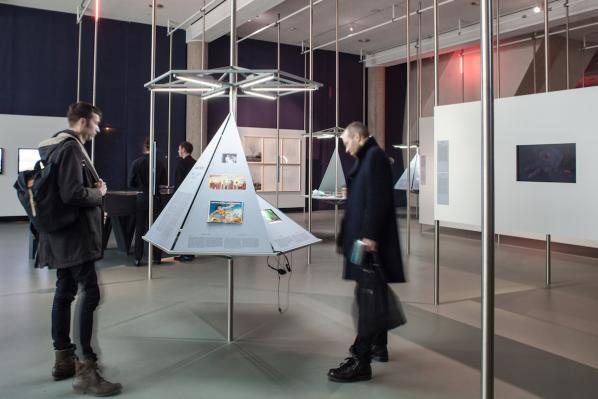
Triangulation is the method to determine the location of a point in space by measuring the angles from two other points instead of directly measuring the distance. As a method it goes back to antiquity. In the exhibition the Triangulation stations give a theoretical and cultural background to the notion of a quantified understanding of the world. Here the exhibition give a rich historical background mixing stories about the UK mass observation project where volunteers made detailed notes about the dancing hall etiquette with analyses of mapping histories and work optimization.
The triangulations in the exhibiton are written by eminent scholars, activists and philosophers. The legal researcher Laurence Liang writes about the re-emerging forensic techniques like polygraphs and brain mappings that have their roots in the positivism of the nineteenth century. Other triangulations are about Smart Design (Orit Halpern), algorithms, patterns and anomalies (Matteo Pasquinelli) and quantification and the social question where Avery F. Gordon together with curator Anselm Franke speaks about the connection of governance, industrial capitalism and quantification.
“Today’s agitated state apparatuses and overreaching institutions act according to the fantasy that given sufficient information, threats, disasters, and disruptions can be predicted and controlled; economies can be managed; and profit margins can be elevated,” the curators say in their statement. We see this believe everywhere – the state, the financial sector, in the drive towards self-optimization. A lot of the underlying assumptions can be traced back to the 19th century – the believe that if we have enough information we can control everything.
Like Pierre Laplace and his demon we believe that if we know more we can determine more. The problem is that knowing is only possible through a specific lens and context so that we become caught up in a feedback loop that only confirms what we already know to begin of. Most notably this can be seen in the concept of predictive policing which is also present in the triangulation part of the exhibition. Algorithms only catch patterns that are pre-determined by the people who program them.
Going through The Grid of the art works (the exhibition architecture by Kris Kimpe masterfully manifests a rectangular gridlike structure in the exhibition space) and reading the Triangulation stations the visitor is left a bit bereft. Is there still hope? One feels like at the end of George Orwell’s 1984 – the main character is broken and Big Brother’s reign unchallenged. This is where the White Room comes in. Here the visitors can be active. The Tactical Technology Collective provides a workshop programme where one can learn about how to secure one’s digital devices, how to avoid being tracked – on the web or by smartphone, what the alternatives are to corporate data collectors like Facebook or Google.
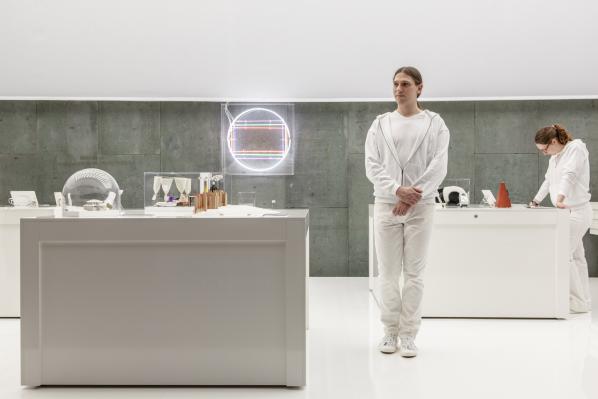
In the end the nature of internet is twofold and conflicting: on the one hand it allows for unprecedented observation and monitoring, on the other it is a tool for resistance connecting people who were separated by space and time. It is not yet clear if this is enough or if (like the radio and other technological media before) it will be co-opted by the one’s in power.
This leads me to one problem of an otherwise very necessary and inspiring show: For all its social justice impetus that narrative that is presented here is very androcentric – there are few if any feminist, queer or post-colonial perspectives in the exhibition. If they are presented then from the outside. This is not a theoretical objection as women, people of colour and other minorities (who are actually majorities) are especially vulnerable to the kind of hegemonic enclosures on the basis of data and algorithms. In a talk in the supporting programme the feminist philosopher Ewa Majewska gave some pointers towards a feminist critique of quantification: the policing of women’s reproductive abilities, affective labour or privacy as a political tool. More of this in the exhibition itself would have gone a long way.
The exhibition is accompanied by an interesting and ambitious lecture programme. The finissage day, May 8, is bound to be especially interesting. Franco Berardi, Laboria Cuboniks, Evgeny Morozov, Ana Teixeira Pinto and Seb Franklin are invited to think further about digitial life, autonomy, governance and algorithms.
Nervous Systems. Quantified Life and the Social Question
March 11 – May 9, 2016
Haus der Kulturen der Welt Berlin
Opening hours and information about the lecture programme on the website.
Featured Image: Stock photography from Google Image search “happy creative tech startup”
Neoliberal Lulz: Constant Dullaart, Femke Herregraven, Émilie Brought & Maxime Marion, and Jennifer Lyn Morone.
Showed at the Carroll/Fletcher Gallery 12 February – 2 April 2016.
Neoliberal Lulz asserts to have born witness, arm-in-arm with rest of us, to an unprecedented shift in the volatility and increasing speculative power of financial markets and the dissolution of value indexing to physical commodities. This relationship has been made particularly palpable in the realization that investment banks and corporations hold a tremendous sway (perhaps even tremendous to an unknowable degree) over our lives. The four artist/groups brought together make work as a way of trying to bring this dynamic into knowing.

Neoliberal Lulz is not so much about this relationship, or the realization of this relationship, between market forces and lived experience. It’s more accurate to say that the exhibition and the artworks contained within it rather serve as a populist blueprint for how individuals can talk to the market. If political economies speak in the limited language of supply and demand, then how can we make ourselves heard?
New media is a particularly good way of addressing this question because of the way hardware and software must constantly negotiate the terms of inter-communication. The success of media is dependent on this trafficking in translations, between file formats, online and IRL, technical apparatuses, outdated and current softwares. So when artists like Constant Dullaart, Femke Herregraven, Émilie Brought & Maxime Marion, and Jennifer Lyn Morone make themselves “corporate,” mimicking the neoliberal virus, this move feels right at home with the kinds of techno-alchemist work being displayed.

Femke Herregraven makes the mystifying lifespan of high frequency trading material, which feels a lot like spinning straw into gold (or perhaps the other way around). Her works rehearse this slippery, ambivalent relationship between value and objects, indexes and standards. In this way Herregraven’s works ground the exhibition in a similar way as does Constant Dullaart’s Most likely involved in sales of intrusive privacy breaching software and hardware solutions to oppressive governments during so called Arab Spring: by memorliaizing in cold, clunky materiality the “immaterial” processes that are active under the banner of neoliberalism everyday. Three of the four artists on display have incorporated—Jennifer Lyn Morone™ Inc, Untitled SAS (that’s Émilie Brought & Maxime Marion), and DullTech™ (Constant Dullaart). Between these companies the process of how to become a company is cracked open, revealing how sophomorically simple and complicated the process is, how much paper detritus and nondescript stuff is secreted as byproduct. Constant Dullaart here adds a lesson on the aesthetics of startups with an entire room dedicated to the oddly-familiar B-roll shots of airplanes cut with inspirational platitudes. Jennifer Lyn Morone adopts the the aesthetics of a kind of good life marketing that is gender-targeted, and operates by corroding away what’s already there (mental health, well-being) to make its own market gap.
But I tell you this: the best part of the exhibition isn’t on display. Ask the front desk about buying shares of either Untitled SAS or Jennifer Lyn Morone™ Inc. This is the heart of the exhibition, and it’s either lamentably sidelined or a brilliantly premeditated that just inquiring about the purchase can reveal so many gaps and uncertainties.
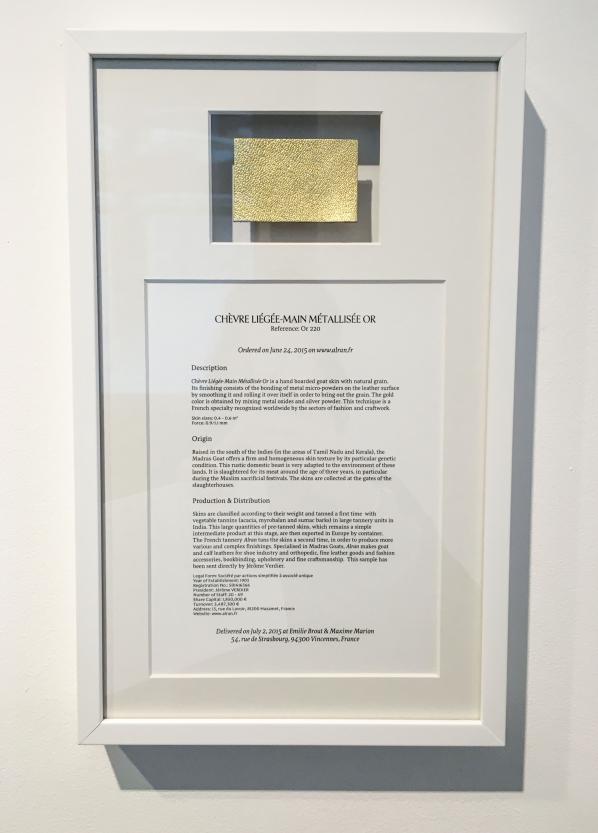
When I visited the exhibition, gallery attendants very kindly filled me in on the bold point details of buying shares, to the best of their ability. They explained that Unititled SAS shares sold for €30.00, with a €25.00 admin fee that went straight to Émilie and Maxime. It is not split with the gallery, as often the the sales of an art object are. Was the gallery entitled to any part of the sale of shares of Untitled SAS? Sort of: fifty-percent went to the French government, twenty-five percent went to Émilie and Maxime, and half of the remaining twenty-five percent went to the gallery. Did a new contract have to be drawn up to negotiate the profit negotiations between the gallery and artists who had incorporated some capacity? No, the normal consignment contracts were used (they did not share what the terms of these contracts are; I did not inquire).
What about shares of Jennifer Lyn Morone™ Inc.— how much did they cost? This was a decidedly trickier question, with nationality and class-based restrictions and allowances. The general gist was that since Jennifer Lyn Morone™ Inc. is registered in the U.S.A., that American citizens are subject to tax; English citizens are not. For English citizens there are also different price points and clauses for lower-income prospective investors. This does not apply to U.S. citizens, who are required to prove salary requirements before purchase can be approved.
Had anyone bought any shares yet, for either company? No.
Eventually, the attendants printed me a Jennifer Lyn Morone™ Inc. Instructions for Prospective Investors document: four-pages single-sided, unceremoniously stapled together. For those unfamiliar with this kind of legalese, it’s a bizarre artifact from another planet. Everyone should ask for a copy.
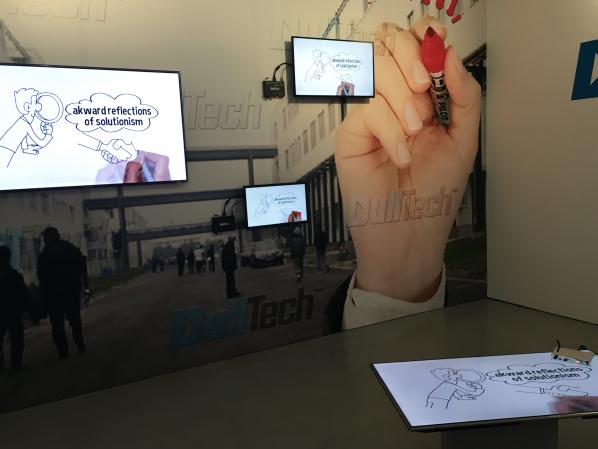
The title Neoliberal Lulz might tip its hat to the tradition of online trolls and their persistent, agnostic vitriol, but the exhibition itself feels like it sets out some very real stakes. This is a good thing, because an exhibition interrogating the asymmetrical relations of production and profit taking place at a prominent art gallery in Fitrovia (a borough in itself that is paradigmatic of these inequities) could have really been smug, smarmy, shit. The hypocrisy of an exhibition that singularly railed against the unmitigated growth of big business while standing amongst its spoils would be too much. But Neoliberal Lulz is not this: it is far more nuanced in its message, far more unclear on its value judgments. As an art exhibition Neoliberal Lulz did well to espouse the artist-as-researcher model. It helps make sure that the exhibition has legs outside of the exhibition space. The fact that most of these artworks have a life outside of the domain of art, circulating within the very thing they’re critiquing, legitimates their output. The other thing that Neoliberal Lulz does well is not to dwell on the narrative of the disenfranchised. I don’t say this because it’s not important but rather because it just simply wouldn’t read.
Neoliberal Lulz feels like a prompt that comes at a timely moment, slotting in to conversations like this, this, and this. It criticizes at the same time as it offers options, which seems like a rare combination these days. “What is to become of the future for young artists?”–the people wail, lamenting that much of the young, creative elite inevitably ends up siphoned off into the tech startup culture. Neoliberal Lulz seems to say this doesn’t have to be a bad thing, and I’m inclined to agree. All’s not lost when artists adopt an if you can’t beat ‘em, join ‘em ethos, particularly when they do so with a critical bent. Deeply sardonic and ruthlessly interrogative, Neoliberal Lulz is a successful venture into addressing the malleability of contemporary political economies to more progressive ends.

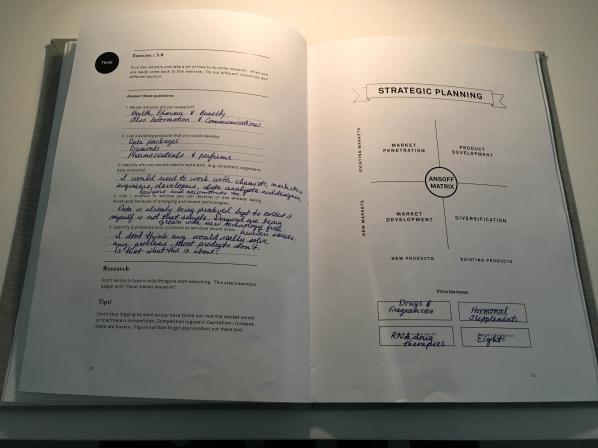
Carroll/Fletcher Gallery
56-57 Eastcastle St.
London W1W 8EQ
Despite its image of rapid technological change, progress under capitalism has stalled. Spinning ever faster is not the same as going somewhere. Contemporary Accelerationism wants to take off the brakes, and it is enlisting art’s help to do so.
Taking its name (like every good movement) from one of its critics – Benjamin Noys claims credit for naming the historical tendency in 2008 – contemporary Accelerationism has both a philosophical and a political form with the latter only weakly related to the former. What Epistemic (philosophical) and Left (political) Accelerationism have in common is an attitude of “prometheanism”, of amplifying our capabilities, of rationally overcoming intellectual and material limits. Of hacking the systems of philosophical and political thought to find the exploits that will allow us to increase our knowledge of them, our control of them, our reach through them. Hopefully this will work out better than it did for the original Prometheus of Greek myth (or for Ridley Scott).
Contemporary Accelerationism may seem heretical compared to the “folk politics” and philosophy that it contrasts itself with but it is not (however some people may start essays) the capital-intensifying Accelerationism of 1970s continental philosophy or its killer-robot-welcoming successor in 1990s cyberculture. From the point of view of the former it is too immediately critical of capitalism and from the point of view of the latter it is an off-ramp on the road to the singularity. It is also not the pure speed of Paul Virilio’s dromology, or the experience of lack of time of the overworked neoliberal subject.
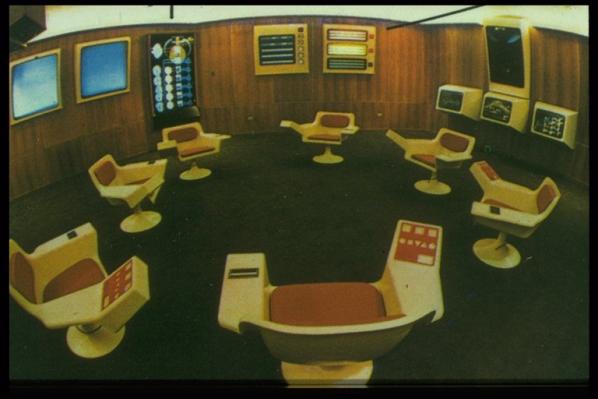
Accelerationism is a progressive attitude towards the liberation of reason and production – and therefore selectively technology – rather than the fetishisation of them. The “real” accelerationists in these senses aren’t working at Google, although they might in time exploit technology developed there. Chile’s early 1970s Cybersyn project provides an informative precedent. It sought to accelerate transition to a socialist economy using limited and almost obsolete mainframe and teleprinter technology. Its Accelerationism lay in the attempt to rationally analyse and spur growth in industry to increase the rate at which it developed, not in technofetishism.
Philosophical Accelerationism is “Epistemic Accelerationism”, represented in the writing of Ray Brassier, Reza Negarestani, Peter Wolfendale and others. This is a neo-rationalist philosophy, a programme of “maximizing rational capacity” and the ability to reason about or navigate our knowledge of the world. This is a self-revising, non-monotonic, socially situated reason very different from the logicism of 20th century rationalism and its detractors (although logics have advanced considerably as well).
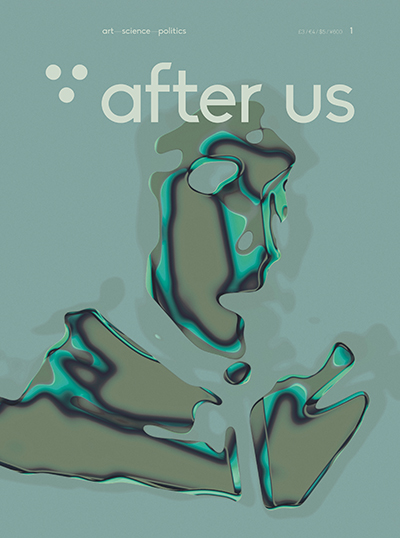
Two new journals are taking an Epistemic Accelerationist approach to art and culture. In the UK, “After Us” shares a designer with former CCRU member Kode9‘s Hyperdub record label. In France, “Glass Bead” takes its name from Herman Hesse’s imaginary game of knowledge described in his novel of the same name. Both are haunted by the legacy of C. P. Snow’s 1950s “Two Cultures” of science and the humanities, with “After Us” explicitly invoking the need to reconcile them. This isn’t the first time such a move has been called for, and previous attempts make clear that scientists tend to make as bad artists as artists make scientists. The contemporary artworld is also not under-populated by transversal and interdisciplinary research and its aesthetics. Regardless, both provide thought-provoking cultural insights and resources. And the first issue of Glass Bead features, among other articles and interviews, Colombean mathematician Fernando Zalamea, whose accessible promotion of contemporary mathematics and production of a synthetic philosophy based on it deserves much wider attention.
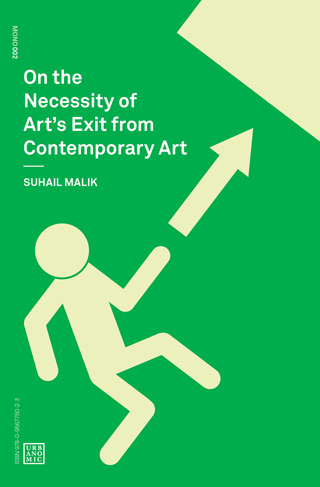
Escaping the radial velocity of asset-class zombie formalism is the focus of Suhail Malik’s “On the Necessity of Art’s Exit from Contemporary Art” (I’ll be reviewing the book for Furtherfield). Malik describes Contemporary Art’s self-image of escape (from society and art’s own limitations into a space of freedom) that disguises an inescapable and complicit recuperation of novelty. To move beyond this he proposes a strategy of exit (which contrasts interestingly with designer Benedict Singleton’s discussion of traps). This is not a seasteading-style fantasy of libertarian secession, rather it is an attempt to identify the next move in the game of art after a long impasse and to return art to a more grounded and constructive role in society.

A group centred around The New Centre For Research (whose events and video archives I cannot recommend highly enough) are seeking to apply neo-rationalism to art in order to effect just such an escape from the outsideless beige singularity of Contemporary Art. This would be an art intentionally constructed to make the rules of contemporary art and of its own construction explicit, allowing artists to reason about this and to thereby come to understand how to escape the seemingly irresistible aesthetic and political cage of contemporary art. Amanda Beech‘s “Final Machine” (2013) prefigures this kind of analysis of the structure of images and their situatedness in the networks of power that produce contemporary art. Diann Bauer‘s collaboration on the art and finance R&D project “Real Flow” is another good example. Bauer has also produced videos for Laboria Cuboniks (see below) and for accelerationism-related events. Beech, Bauer and others have held a series of discussion panels on the subject of “Art and Reason” (one) (two).
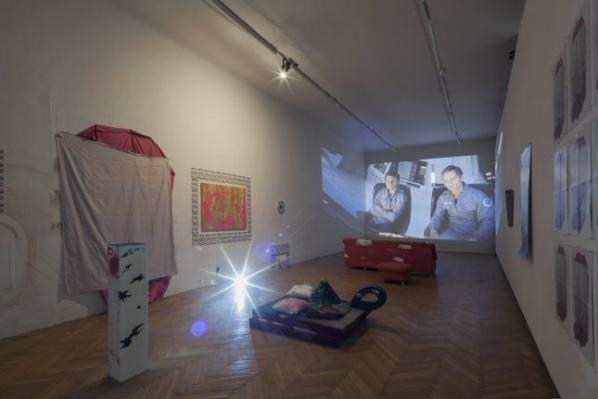
Curator and critic Mohammad Salemy has curated a series of art shows with Epistemic Accelerationist themes – “Encyclonospace Iranica” in Vancouver, “For Machine Use Only” in Vienna, and most recently “Artificial Cinema” in Prague. Each of these has created an artistic critical context for networked systems of perception and knowledge, engaging with the political possibility of their being repurposed to more emancipatory ends in the future.
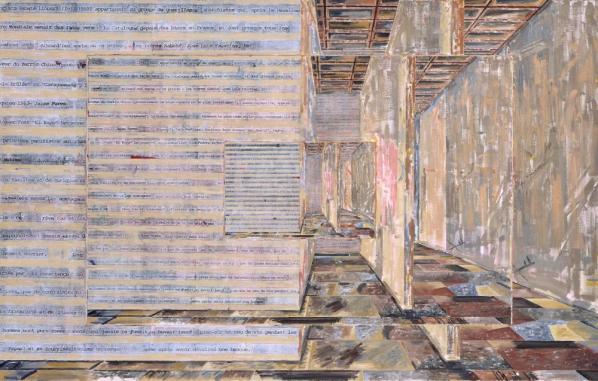
A self-aware, critical, politically committed art aware of its institutional context that is nonetheless still recognisable as art may sound like a stretch but there are precedents in the work of veteran conceptual art collective Art & Language, most obviously in their early “Index” installations and in their later “Incident In The Museum” paintings. There is another way in which Art & Language provide a precedent for the New Centre group – a decade ago they theorised genre as a means of interrupting the frictionless misrepresentations of Contemporary Art, similarly to Malik’s (and, as we shall see, Beech’s) emphasis on recategorisation.
Contemporary political Accelerationism is “Left Accelerationism”, exemplified by the writing of Nick Srnicek and Alex Williams. Initiated by the “Manifesto For An Accelerationist Politics” and fleshed out in the book “Inventing The Future“, Left Accelerationism claims that some of the technologies created by capitalism can be repurposed and even intensified to enable an achievable socialist future and unleash the creative forces in society that they currently repress. As Srnicek and Williams make clear in “Inventing The Future”, this is not in opposition to other struggles but rather a means of materially supporting them.
As a group that often struggles with basic material support, the Left Accelerationist project can hold some appeal for artists. Universal Basic Income (pursued as Srnicek and Williams propose – within rather than as a reason to dismantle the rest of the Welfare State) for example would benefit artists (and musicians, actors and other creatives) in much the same way as earlier welfare state provisions. Artists can support this, rather than having to make the specific moral case for artworld subsidies, as an effective means of solidarity.

Full automation, another of Srnicek and Williams’ proposals, is the theme of the show at Kunsthalle Wien. The diverse work included drives home that art and curation needn’t be propagandistic, uncritical or overly serious to promote or engage with Accelerationist themes.
In their essay in the book “Speculative Aesthetics” (2014), Nick Srnicek proposes an Accelerationist aesthetics of transforming a “data sublime” into forms comprehendible by human beings, an aesthetic of user interface-style efficiency and transparency rather than beauty. The example Snicek gives is of transforming a complex economic model into a tool for the manipulation of economies. In the same volume, Amanda Beech (again) argues that rather than “asking what images mean, or if it is possible to mean what we say” we should produce an art that leaves behind the category of the uncategorisable in order to unravel the political project that contemporary art is subject to.
Likewise Alex Williams’ consideration of Accelerationist aesthetics in the article “Escape Velocities” (2013) emphasises aesthetics as a means of presentation of conceptual spaces, rendering them tractable to the human imagination, as well as explicitly discussing interface aesthetics with reference to Cybersyn. They also mention the concept of Hyperstition, which we will return to below.

Laboria Cuboniks are a pseudonymous collective who have produced the “Xenofeminism” accelerated feminist manifesto. It’s a strikingly designed production (the website was designed by artist Patricia Reed) that is already inspiring artistic production. The “3rdspace” show describes itself as “a response to XF and an exploration into the potentials of technology to escape modern structures of control”, building on Promethean themes.
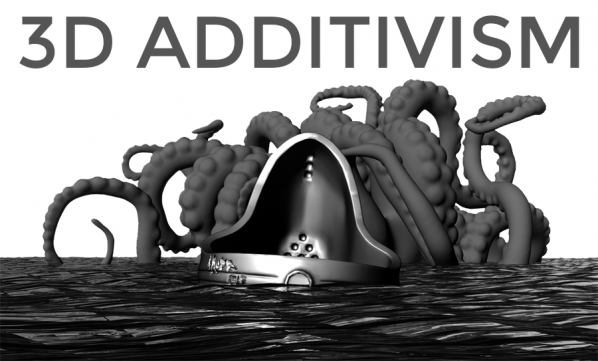
Morehshin Allahyari & Daniel Rourke have produced the Additivist Manifesto for art in the Anthropocene (the video for it features the “Urinal” 3D printable model I commissioned from Chris Webber). They “…call for you to accelerate the 3D printer and other technologies to their absolute limits and beyond into the realm of the speculative, the provocative and the weird”. This is the kind of acceleration through (and into) art that works as both epistemic and left accelerationism without merely illustrating the program of or being instrumentalised by either. It is accelerated critical theory.

And beyond the visual arts, musician Holly Herndon’s most recent album was described by collaborator Mat Dryhurst as being designed to support Left Accelerationism.
While contemporary accelerationism is at pains to signal how far removed it is from CCRU-era Nick Land (let alone their contemporary work), the CCRU’s instrumentalised mythological theory-fiction has resources that are of interest. The slippery concept of “hyperstition”, essentially self-creating science fictional or mythical entities, is key. Cyberspace is hyperstitional, as was the writing of H. P. Lovecraft, as was Neoliberalism, and the music of Hyperdub. They are all unreal entities that bootstrapped themselves into reality via the human imagination. Hyperstition is an example of rational irrationality, or at least rationalised irrationality.
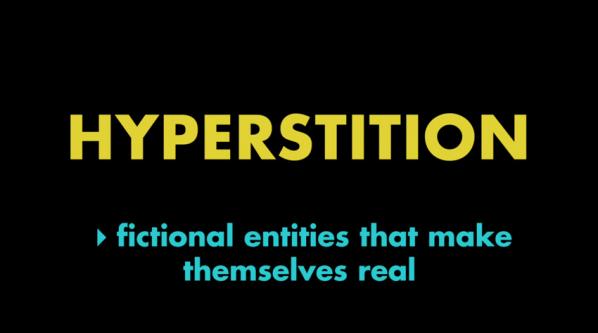
Seeking to harness hyperstition for a moral or political programme has something of the air of trying to summon Cthulhu for social justice, or to turn Skynet into a phone tree, but Williams’ “Escape Velocity” mention of Hyperstition as a means of creating visions of a better future as something that will have been possible is compelling. Hyperstition should be more (mis-)used in art than it currently is, and its creation all but demands activity outside the existing artworld.
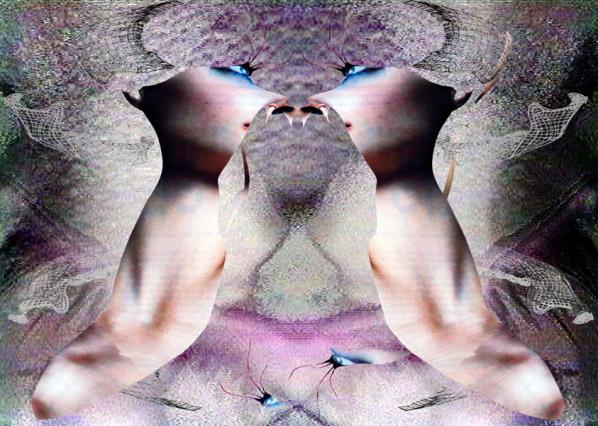
International art collective (and CCRU collaborators) Orphan Drift‘s autopoietic mythologies realised in glitch art videos, installations and writing provide a historical point of reference here.
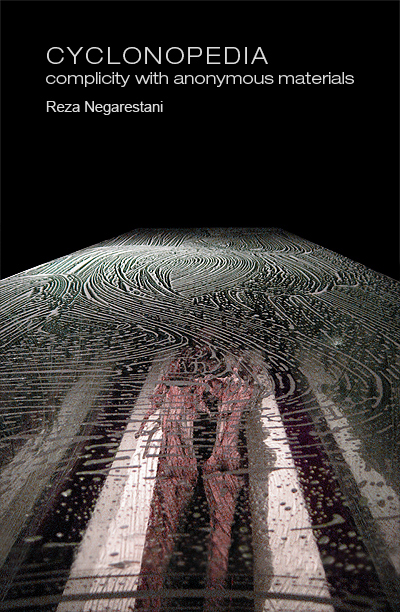
The earlier work of Reza Negarestani serves as a bridge between the CCRU era and the present. His novel of theory-fiction “Cyclonopedia“, 2008, evokes hyperstitional entities from the layers of trauma present in the politics and geology of oil and the Middle East.
In art, reason and rationality may inspire memories of dry conceptualism or stern Soviet abstraction but contemporary art’s hidden and totalising rules are no less binding and are in desperate need of exposure and critique. The task of uncovering and overcoming them presents a challenge to perception and representation that meeting will amount to much more than “art about art”. Perhaps we can use Deep Learning and neural nets to pull the ghosts of genre and medium specificity out of contemporary art then intensify them rather than make puppyslug kitsch… but that’s another story.
Left Accelerationism’s design tasks and the hyperstitional making of its future seems to have always been possible to provide more challenging alternative projects to the manufacturing of yet more zombie formalism, and as “The Promise Of Total Automation” demonstrates this needn’t take the form of uncritical propaganda.
In contrast to these approaches, I feel it’s worth asking what a direct equivalent to Left Accelerationism for Contemporary Art would look like. Which aspects of the contemporary artworld would be worth intensifying, appropriating and pushing further to create an alternative? And what would the vanishing point for such an art be in order to avoid recuperation into the generic space of Contemporary Art?
Accelerationist art is working out how to climb over the event horizon of contemporary art, helping to make a better future seem possible, analysing and transforming technocapital, and ironically intensifying the trajectories of new technology to critical excess. As the logic of neoliberalism colonizes personal space, time and identity, suggesting that we need to move faster in any way may seem perverse or complicit. Accelerationist art is part of a project to grab the wheel rather than slam on the brakes and to thereby move beyond the exhausted constraints and artistic apologetics of the logic that is eating the world.
(Updated 2016-05-18 to include more examples.)
Accelerationist Art by Rhea Myers is licensed under a Creative Commons Attribution-ShareAlike 4.0 International License.
The global financial dictatorship presents us with a paradox: while the economic transactions capable of shifting the destinies of entire countries are the result of performative language, it is language itself that, in turn, is transformed and subjected by the flows of financial markets. Such a paradox may be understood as a negative feedback loop: a relational process in which one of the actors of the relationship is amplified and expanded (the economy) while the other is weakened and submitted (language). The effects of this paradoxical feedback loop on politics are evident and clear: the linguistic exchange which feeds the public sphere, and therefore the possibility of thinking about the democratic organization of society, diminishes and becomes neutralized because of its submission to the market, up to the point of canceling politics itself. Politics, considered as a space where daily life becomes realized, is reduced to an engine which merely executes the algorithms of finance. In this reconfigured field, the common good becomes increasingly unimaginable as individuals are transformed into cellular automata: inside their bodies, the code of economic behavior and the flat, mutilated language that capitalism requires to operate frictionlessly are already inscribed.
Whoever refuses to enter life as a mere cellular automaton will be annihilated by the financial dictatorship, which is currently passing through an extremely murderous stage: necrocapitalism. Achille Mbembe claimed that the ultimate expression of sovereignty lies broadly in the power and the capacity of deciding who may live and who must die. This was known as necropolitics. Today, the dictatorship of finance prescribes a progressive and quick reduction of the sphere of politics, with the aim of canceling the restrictions that laws and codes used to impose on the flow of capital. And governments have indeed shrunk, turning thus into little more than facilitators of the unstoppable progress of capitalism. However, they have not stopped to exercise their operational capacity to kill and let live. True power has been transferred directly into the hands of capital, who now determines which lives should be halted and which should continue. The power of capital has increasingly turned into a murderous one that, nevertheless, is still executed by the officers of the old sphere of politics.
Mexico passed from necropolitics to necrocapitalism not by force but by the signatures of the presidents and ministers of finance of Mexico, the United States of America and Canada who, in 1992, signed the North America Free Trade Agreement (NAFTA). What has happened in Mexico since then? A chaotic chain of privatizations, looting and crime, all of which have been executed with a hitherto unknown intensity thanks to the almost complete destruction of the former sphere of politics.

After the forced disappearance of the 43 students of Ayotzinapa, Elisa Godínez wrote that “it is not surprising that the corporate sector is heading the demands to repress all social protests which directly affect their properties and interests, arguing that the rule of law should be respected.” [1] It is true that, in the post-NAFTA era, such a position comes as no surprise. However, the true novelty lies in the fact that now the Mexican State no longer defends only the interests of national corporations, but also those of multinationals. And this is not a minor novelty: all sorts of extraction industries, for example, have multiplied their concessions and profits thanks to such a defensive stance. And they have done so while devastating lands, ecosystems and people with almost complete impunity. According to data collected by the Red Mexicana de Afectados por la Minería (Mexican Network of Persons Affected by Mining), 450 tons of gold have been extracted from Mexico, a quantity almost three times larger than the 185 tons extracted during Spain’s colonial domination. This unprecedented looting has particularly benefited Canadian and North American companies, who make up almost 85% of all private mining concessions, while paying back a mere 1% of what they extract to the Mexican government [2].
Article 27 of the Mexican Constitution deals with the property of land, water and natural resources. It originally established that “the property of lands and water resources inside the limits of the national territory corresponds to the Nation.” Obviously, this vision had to change radically under necrocapitalism since, instead of recognizing the primordial nature of private property and the right of capitalists to posses it, it indicated that “the Nation” was, in principle, the sole owner. Now, thanks to recent reforms to Article 27, “the Nation” has acquired the right to transfer the dominion over lands and territorial waters (and, consequently, over the humans and non-humans who inhabit them) into private hands. Article 27 is today the red carpet extended by the Mexican State to welcome the financial and linguistic flows and algorithms of necrocapitalism in grand fashion.
The piece “El 27 | The 27th” is an example of what algorithmic politics can be. Far from trying to point to a possible escape from the horror and exploitation of necrocapitalism, algorithmic politics deepens its murderous potential instead. Despite its relative usefulness as a hired murderer, the traditional sphere of politics is terminally ill: it is too old to carry out rapidly and efficiently the demanding tasks of necropolitics. So, once exhaustion has completely died out its powers, politics made by humans will have to be substituted by algorithmic politics, that is: politics made by machines.
In this piece, an algorithm operates directly on the text of Article 27 in the following way: every night, after the activity at the New York Stock exchange has come to an end, a robot obtains its last closing price and its respective percent variation. If the variation is positive, another robot chooses a fragment of Article 27 randomly, translates it into English automatically, and inserts the translation into its corresponding place within the original text written in Spanish. Given enough time, the algorithm will produce a version of Article 27 fully readable in an effective – yet incorrect – English. An automated English that will already have attempted to displace humans brutally, even though they might still be fighting for a territory delimited by language only, and refusing to die. An automated English that will have already eroded a land delimited by language only, rendering it unrecognizable: torn, exploited, almost dead.
“El 27 | The 27th”: http://motorhueso.net/27
“[A] hundred reasons present themselves, each drowning the voice of the others.” (Wittgenstein, Philosophical Investigations: supra note 11 § 478).
For Part 1 click HERE.
For Part 2 click HERE.
Voice and unintelligibility play a greater, complex role in reasoning than the Left or Right accelerationists are prepared to admit, or fail to see. Establishing ones political voice is far broader and extensive than any of these thinkers take it to be, and is not simply the by-product of a phenomenological given unable to envisage any political alternative. Voice has to take priority here, for how else does one actually communicate? By this, we don’t have to take Voice to be the literal act of saying something out loud, or examining the behaviour for doing so. It can interpreted both as a metaphor and means encompassing every political act to which it can be applied; having a voice, or an opinion, hearing the public representation of someone, or of a community, wanting to being heard, letting someone have a say in the matter, etc. Above all it takes on the force of voicing ones own condition.
Might every form of modern communication then, be it a WhatsApp message, a bored glance at a meeting, cynical internet comments to nondescript mumbling, be one of ordinarily voicing our own condition? Perhaps even more so when it is mediated by an infrastructure (sometimes especially so). Both Voice and infrastructure are components of communicating indirectly, as most language games tend to do, whether face to face, face to mirror or interface.
The problem with philosophy is that the ordinary gets blamed, largely as the historical list of philosophy’s complaints almost always aim for the ordinary first as if its triviality is, by itself, not to be trusted with political or rational action. Indeed the very task of calling the ordinary to our attention, takes into account that we have lost interest in it. Perhaps it was already assumed that the market silently reduces the depth of ordinary communication and circumstance to capitalist knowledge anyway. Or maybe since ordinary life is increasingly and consistently mediated through online platforms, technology has overtaken its significance.
Yet what Ordinaryism seeks to uncover is that Voice does not constrain freedom because of its vulnerability: it is only because of vulnerability that voice expresses the freedom to reason in the first place. This is the split that severs both the sovereign rationality of Accelerationism (and Sellars), and the non-sovereign self of Ordinaryism (and Cavell). Indeed, this appears to be Cavell’s political lesson: it seems rational to want build a platform for others to air their democratic voice and decry any ineffective basis in favour something more determinate, more grounded, more inhuman. Yet freedom and justice only begins if a community is capable of ‘finding’ their own voice in the face of injustice. Likewise freedom is constrained if other voices repudiate the voice of others. There is no cognitive purchase for this, and no pre-built, implicit, or explicit ground for determining intelligibility either. So we have to ask, how else can the inhuman make itself intelligible unless it gives voice to its own condition? (As an aside, what else is philosophy but a set of specific and singular voices crying out for recognition in their appeal? A voice that may be acknowledged, yet equally repudiated? Just as the sound and look of Voice matter in reasoning, [how it persuades, how it strikes you] so too does the sound and look matter to philosophising arguments and deductions.)

The easiest way to round these political concerns up is to show how the very need to bypass the vulnerability of Voice, the need to provide an ‘answer’ or ‘solution’ to that vulnerability, is the same philosophical question that concerns solving skepticism. This is the heart of Cavell’s philosophy.
Following Naomi Scheman, the heart of transcendental inhumanism to which the epistemic accelerationists follow aims to draw attention to what underlies the possibility of our ordinary lives. But in Ordinaryism, the Cavellian rejoinder must insist that “the ordinariness of our lives cannot be taken for granted; skepticism looms as the modus tollens of the transcendentalist’s modus ponens.” (Scheman, “A Storied World”, In Stanley Cavell and Literary Studies, 2011 p.99). Whereas Accelerationism posits a renewed set of tools to re-determine intelligibility in an era of supposed ‘full automation’, Ordinaryism speaks to these same conditions but where intelligibility routinely breaks down, is endlessly brittle, always delicate, sometimes connects, but is never ensured or determined by philosophical explanation alone. What might it mean to understand the fragmented world of machines as a uniquely literary responsibility?
In other words, a future world of increased automation needs a romantic alternative. And it is sorely needed, because in this future order where automation is assumed to outpace human knowledge, or supersede it in any case (amplifying existing industries, or creating new ones) Ordinaryism speaks of new moments of doubt which constitute the skeptical fragments of ordinary life with machines. Perhaps also of machines. It might take on a specific personal form of questioning and living with what these new forms takes on; “what does this foreign mapping of data really know about me”, “what does it know about all of us?”, “Am I just being used here?”, “How can I know whether anyone is spying on me?”, “why are they ignoring me?”, “what on earth does that Tweet mean?”, “what’s happening?”, “what am I supposed to think about this”, “Why would I care about you’re doing?”, “I need to know what they’re doing.”
There are innumerable ordinary circumstances where a life with machines begins to make sense, but also starts to break down in all the same places: how might one suggest that a machine “knows” what it’s doing, or that “it knows” what to do? Where does the scalability of automated systems start to break down, and what sort of skepticism does it engender when it does? What happens when software bugs, and unpredictable acts of mis-texting chagrin habitual pattern? How might such finite points of knowledge exist, so as to understand and inhabit systemic doubt? What are the singular and specific means for how such systems are built, conceived or decided? And most of all, how might we even begin to characterise and acknowledge the voices which emerge within these systems? You might say that Ordinaryism wishes to extract acknowledgement out of the knowledge economy.
What is required then, is both a Cavellian critique of epistemic accelerationism (what potential political dangers might arise if Voice is repudiated) and why its solutions to solve skepticism through collective reasoning and self-mastery are no different from skepticism itself. But to do that, one also has to take account of how Cavell brings an alternate approach to imagining how normative rules are implicit in practice. This is not an act of opposition, more of a therapy, which might be needed, especially as politics is involved.
Now, despite the fact that Cavell’s philosophical questions work (almost) exclusively in the Wittgensteinian domain of articulating and expressing normative concepts which regulate speech and pragmatic action (beginning from his first essays Must We Mean What We Say? and his later magnum opus, The Claim of Reason) these texts don’t appear to be required reading in accelerationist and neo-rationalist circles.
Take the newly released art journal Glass Bead, whose aim is to suggest that any “…claim concerning the efficacy of art – its capacity, beyond either it’s representational function or its affectivity, to make changes in the way we think of the world and act on it – first demands a renewed understanding of reason itself.” If such a change in thinking is motivated by a renewed post-analytic approach to reason in a world of complexity (and an additional capacity for aesthetic efficacy), the continued omission of Cavell’s work into reason and aesthetics, is notable by its complete and utter absence. It’s enough to warrant the claim that certain imaginings of reason – in this case the abstract inferential game of giving and asking for reasons – are to be favoured over other types (usually with a secondary, pragmatist demand that science is the only authentic means for understanding the significance of the everyday).
In fact there’s a good reason for that omission: because Cavell discovered that he wasn’t able to ignore the threat of skepticism entirely, and instead discover it to be a truth of human rationality (is there anything more paradoxical than discovering ‘a truth’ in skepticism?). He instead sought to articulate how such concepts were not inherent features of inhuman ascension by means of inferential connection, but fragmented conditions of differentiated identity. In the eyes of the epistemic accelerationist, it’s as if there isn’t any possible option in-between some half-baked, progressive ramified global plan to expand the knowledge of human rationality, and a regressive fawning over the immediacy of sensual intuition. Fortunately, Cavell’s ‘projective’ approach to rationality questions this corrosive forced choice.
Wittgenstein’s Philosophical Investigations sets up the key differences here. Instead of using Wittgenstein’s text as an introductory tool to show how the public expression of saying something can be explained and correctly applied (as Robert Brandom pedantically attempts), Cavell paid attention to Wittgenstein’s voice, as it invokes a specific and personal literary response to what happens when we are in search of such explanatory grounds (and how they always disappoint us). Perhaps more pertinently, Wittgenstein alluded towards an effort ‘to investigate the cost of our continuous temptation to knowledge.‘ (Cavell, The Claim of Reason, p. 241) Compare this to the current neo-rational appeal which has little to no awareness that the pursuit of certain knowledge (and the unacknowledged consequences for when it will go astray) might itself be inherently unproblematic. Because reason presumably.
It’s no accident therefore that Philosophical Investigations has become one of the oddest literary feats in Western philosophy, insofar that it presents itself as a personal account, rather than a systematic one. Cavell was not only the first to prise out a Kantian insight from Wittgenstein’s text, but also to ask the simple question of why does he write like this? It’s as if every single word, every ordinary word, now takes on the full power and insight as any theoretical term of jargon: as if a theoretical vocabulary isn’t wanted or needed. Why does Wittgenstein provide provocative literary fragments to elucidate his philosophical struggles? (the infamous ‘mental cramps’) Why does he raise literary devices to flag up disappointing conclusions: where a rose possesses teeth, beetles languish in boxes, and lions speak in packs of darkness? It’s an insight which lies in acknowledging that Wittgenstein’s unique literary voice is inseparable from his philosophical ambitions. It is not that he offers an anti-skeptical account to fully fix and explain what it means to say something: nor does he posit an implicit mastering of normative concepts, whereupon said possibilities are subject to further explanation (the conditions under which cognition or experience become possible).
It’s as if the theoretical problem doesn’t come with fully understanding norms implicit in practice, but the very situation in which using words like “rules”, “freedom”, “determine”, “correct” and so on, do not have the desired theoretical effect (in the accelerationist case, freedom). These are very nice words after all, but the neo-pragmatist theory is found wanting in their full expression, sufficient to the limits given when they are spoken not as a licensed inference, but as a creative effect. Cavell’s take on language thus, is that there is always something more to words than the current practice in which they are put to use.
The appeal to Wittgenstein’s literary conditions is what motivates Cavell to suppose that his theory of norms in practice isn’t something to which words are used to line up a certain conclusion, rather, the specfic and singular non-formal ordering of ordinary words in themselves provide a certain crispness and perspicuity, as well as difficulty and confusion. As Paul Grimstad suggests:
“Cavell wonders what one would have to do to words to get out of them a certain kind of clarity; to ground their meaning in an order. A kind of literary tact—the soundof these words in this order—would then serve as the condition under which we are entitled to mean in our own, and find meaning in another’s, words. The sort of perspicacity striven for here is not a matter of lining up reasons (it would not be “formal” in the way that a proof is formal), but of an attunement to arrangements of words in specific contexts.”
As Sandra Laugier chooses to describe it, Cavell’s posing of the Ordinary Language Philosopher’s question – “What we mean when we say” arises from “what allows Austin and [the later] Wittgenstein to say what they say about what we say?” For Cavell jointly discovered a radical absence of foundation to the claims of ‘what we say’, and further still, that this absence wasn’t the mark of any lack in logical rigour or of rational certainty in the normative procedures that regulate such claims. (Laugier, Why we need Ordinary Language Philosophy – p.81)
If agreement in normative rules becomes the presupposition of mutual intelligibility, then any individual is also committed to certain consequences whereupon certain rules might fail to be intelligible. Therein lies a simple difference: the espousal of following a universally applicable rule (as Brassier holds) and everyone else wondering whether that same rule has been correctly followed.

To mean exactly what we say, or to mean anything in fact, might be contingently mismatched to the specificity of what we say and project in any given context, hence one must bare the normative challenge that *what* we mean may differ from what we say.
The ordinary is saturated with these innumerable variations of mismatch through specific and singular situations, to which our attunement is threatened: when a co-worker fails to turn up to a meeting because they misunderstood someone’s directions or when a poor sap fails to get the joke he or she is the brunt of, or when a close friend misunderstands a name in a crowded bar. These moments are not insignificant wispy moments of human limitation swallowed up in a broad history of ascension, but become the necessary exhaust that emanates from a social agreement in which the bottom of our shared communal attunement falls away. With a language, I speak, but only insofar as we are already attuned in the projections we make.
As Cavell put it in this famously long (but necessarily long) passage;
We learn and teach words in certain contexts, and then we are expected, and expect others, to be able to project them into further contexts. Nothing ensures that this projection will take place (in particular not the grasping of universals nor the grasping of books of rules), just as nothing ensures that we make, and understand, the same projections. That on the whole we do is a matter of our sharing routes of interest and feeling, modes of response, sense of humour, and of significance and of fulfilment, of what is outrageous, of what is similar to what else, what a rebuke, what forgiveness, of what an utterance is an assertion, what an appeal, when an explanation – all the whirl of activity that Wittgenstein calls “forms of life”. Human speech and activity, sanity and community, rest upon nothing more, but nothing less, than this. It is a vision as simple as it is difficult, and as difficult as it is (and because it is) terrifying. (Cavell, Must We Mean What We Say? p.52)
If the reader might allow a Zizekian-style joke here (apologies in advance), it might elucidate Cavell’s insight further than the lofty quote above: “Two guys are having an heated exchange in a bar. One goads to the other, “what would you do if I called you an arsehole?”, to which the other replies “I’d punch you without hesitation.” The first guy thinks on his feet: “well, alright, what if I thought you were an arsehole? Would you hit me then?” The second guy reflects on his reply, “well, probably not” he says, “how would I know what you’re thinking?” “That settles it then,” says the first guy, “I think you’re an arsehole.”
Although the mismatch is played to (a rather ludicrous) comical effect, it offers a way into Cavell’s strange appreciation of skepticism’s lived effect. We intuitively know these ordinary situations, ordinary utterances and yet such acts are not instances of reason ascending its limits through knowledge, but are necessary and specific instances where reason’s endless depth and vulnerability enacts itself within such limits. The intelligble process by which the concept of “I think you’re an arsehole” arises, does little only to serve how brittle the semblances between saying and thinking portray. This for Cavell produces an anxiety; and it “… lies not just in the fact that my understanding has limits, but that I must draw on them, on apparently no more ground than my own.” (Claim of Reason, p. 115).
But it also presents a shift from the commonness of ordinary language to the question of a community where that commonness resides. And for Cavell if it is the case that there’s no firmer foundation than shared practices of common speech and community, there cannot be a shared conceptual framework, so as to collectively determine an objective intelligible method of treating and avoiding skeptical claims. Thus, any instability between what we find intelligible (what we cognitively understand or grasp) and how it is expressed in what we say, is also indicative of the social and cultural conditions that sustain such vulnerabilities. This is why for Cavell, the social conditions of a language game are fundamentally aesthetic in character, because we are both attuned to the conditions of a game and the experimental moments in which one tries out new and progressive literary arrangements that push against the game’s limits.
Which is why the history of the inhuman is constitutive of skepticism as barbed wire is constitutive of blood stained fences. And in conclusion, we’ll begin a preliminary move towards a bona fide Ordinaryist alternative to epistemic accelerationism (to be fleshed out in the final part). Key to this alternative is to understand that reasoning is not explainable by rule-governed inhuman rationality, but has a hand in the general projection of words, criteria and concepts in ordinary language (and moreover how inhuman Exit threatens this reasoning). Just because political action within reasoning can often fail to be intelligible, does not render it subject to inhuman ascension.
Nonetheless, Accelerationism operates as if there’s no other type of future worth wagering on, nor any method other than the force of reason suitable enough to supply the tools required. The morality put forward hence is that the more we are able to harness our knowledge of our social and technical world, the better we will be able to effectively rule ourselves and the greater chance of a strategy to overcome capitalism. The chief rejoinders that usually face criticisms of renewing the Enlightenment, consist in labelling detractors as complicit with skepticism, misunderstanding skepticism, languishing in sophism, abandoning reason for irrationality, justification for complicity, and trading off modern knowledge for theological assumption. Brassier recently referred to this skeptical questioning as the “unassailable doxa” of the humanities, constitutive of an influential strand of 20th Century European philosophy (from Nietzsche onwards), where the desire to know is “identified with the desire to subjugate”. Brassier goes on;
This is skepticism’s perennial appeal: by encouraging us to give up the desire to know, it promises to unburden us of the labour of justification required to satisfy this philosophical desire. Thus it is not certainty that skepticism invites us to abandon, but the philosophical demand to justify our certainties.
What Brassier takes for granted however, is that refusing to adhere to the force of reason and the ongoing project of attaining knowledge does not instantly amount to embracing skepticism, or that such knowledge will always be inadequate (and a violent act). What is at stake is not *simply* an inadequacy of knowledge as a cognitive resource. To view it as this, is what Cavell associates as skepticism, even if the desire is to then overcome it, or, in some way pushing skepticism to a deeper conclusion. The issue is not sophism, but skepticism.
Cavell’s romantic inclinations towards ordinary language philosophy offers a way out of this forced choice: skepticism simply cannot be refuted in favour of a renewed inhuman anti-skepticism. Entertaining skeptical doubt isn’t something which philosophers are especially adept at, treating it as an intellectual error to refute or ward off afterwards. Skepticism inhabits itself as an everyday, ordinary occurrence, equally puzzling and troubling, eternally unsatisfied and yet utterly enticing. It is a strange, yet equally relentless human drive to repress and reject the very attuned conditions that sustain intelligibility: conditions which also contain the ability to attune to one another’s projections.
In consideration of the fact that Accelerationism wants to conceive our conditioned intelligibility as a product of rule-governed knowledge this poses problems worthy of the best tragedies the humanities have to offer. Here’s Cavell’s take on the matter (my emphasis):
I do not […] confine the term [“skepticism”] to philosophers who wind up denying that we can ever know; I apply it to any view which takes the existence of the world to be a problem of knowledge […]. I hope it will not seem perverse that I lump views in such a way, taking the very raising of the question of knowledge in a certain form, or spirit, to constitute skepticism, regardless of whether a philosophy takes itself to have answered the question affirmatively or negatively. (Cavell, The Claim of Reason, p.46).
Brassier would probably lambast this certain condition as a conformist view of ‘I should or ought to live my skepticism’, such that it hides an implicit refusal to investigate or question these forms (leading to various, inexorable ‘end of’ philosophies). But in doing so he takes on, at least in Cavell’s eyes, the compulsive epistemic assurances that skepticism compels. By implication Brassier’s endorsement of an anti-skepticism hides the fragility and depth of normative claims, and that claims are always voiced and projected. The problem with espousing rules for generating normative freedom is that a rule is neither an explanation nor a foundation – it is simply there (note that in saying this Cavell does not deny any rigour, moral or political commitments to normative rules). What Brassier and Accelerationism share is to answer a source of disquiet; that the validity of our normative claims seem to be based on nothing deeper than ourselves, or how words are put. And this attempt to reject Cavell’s insight, to erase skepticism once and for all, backfires only by reinforcing it.

Cavell’s treatment of skepticism is that it must be reconfigured away from an entrenched view of epistemological justification as a product of certainty: or that the existence of other minds, objects, procedures, processes and worlds can be reduced to problems of (and for) knowledge. The head on effort to defeat skepticism allows us to think we have explanations when in fact we lack them. Or put better, the idea that we can theorise a clean break from skepticism is itself a form of skepticism. The point is that we clearly can approach communities, other minds, systems and communities which often appear incomprehensible, unintelligible; but such appearances are features of vulnerability, and vulnerable grounds which we depend on nonetheless. Yet change only occurs not because we’re certain about the knowledge we possess, but in response to others whose involvement happens to be beyond my intellectual attempt to know them with certainty. There is nothing more uncertain than a response to alterity.
Politics operates exactly in this way, coming to terms with ones immediate response to injustice, not in “knowing” it or offering an explanation, but by acknowledging it. The “folk” vulnerabilities that Srnicek and Williams find ineffective are constitutive of intelligible injustices that we must acknowledge in order to engage at all. Nothing guarantees this. This is the central point: reasoning with the inhuman, requires a human appeal to acknowledge another – or put differently, making the inhuman intelligible requires that we acknowledge the voice of the inhuman (and equally that this same voice can reject our appeals). After all, what use is a politics based on the epistemic assurances of knowledge, if such knowledge can be regularly doubted?
What Brassier doesn’t acknowledge is that both his position and the skepticism he attacks, are guilty of the same premise: the longing for a genuine inhuman knowledge, without acknowledgment. This appeals to something greater than the everyday which gives voice to such justifications. Nihilism might be fun, but at some point its political actions soon becomes silent to its own screams, as it spins into a void of its own making. The ordinary prevails.
Cavell suggests that this philosophical impetus towards the inhuman is inherent to the skeptical habits of philosophical drive, for there is:
…inherent to philosophy a certain drive to the inhuman, to a certain inhuman idea of intellectuality, or of completion, or of the systematic; and that exactly because it is a drive to the inhuman, it is somehow itself the most inescapably human of motivations. (Conant, “An Interview with Stanley Cavell,” in Fleming & Payne, eds., The Sense of Stanley Cavell, 1989)
Unlike most ordinary language philosophers, Cavell has always been clear that the appeal to ordinary language is not the same as refuting skepticism (as some disciples of Wittgenstein might have it). Nothing is more skeptical, more aversive to the everyday that the “human wish to deny the condition of human existence” and that “as long as the denial is essential to what we think of the human, skepticism cannot, or must not, be denied.” (Cavell, In Quest of the Ordinary, 1988, p. 5) In fact, most of Accelerationism’s Promethean attempts in fully maximising the human drive to transcend itself, were preempted by Cavell: as the skeptics’s treatment of the world (and others) is endless, completely prone to acceleration. One might say, acceleration is built into skepticism when the human mind convinces itself that the world is divorced and devoid of meaning – it encounters nothing but the meaningless of itself. It becomes a tragic temptation which the human creature carries out, an internal argument that it can’t quite relinquish. Or as Cavellian scholar, Stephen Mulhall puts it simply. “the denial of fintiude is finitude’s deepest impulse.” (Mulhall, The Self and its Shadows, 2013, p.48)

Accelerationism becomes a tragedy. A tragedy of never quite knowing what knowledge is enough, or when (it’s tragic enough that in theorising the emancipatory potentials of technology, it hasn’t appeared to go any further than incessantly arguing about it with others on blogs and Facebook threads – this author included).
However this shouldn’t be too much of a surprise when you have a political movement which shares an enthusiasm for building AI systems that are (quoting Mark Zuckerberg early last year); “better than humans at our primary senses: vision, listening”. When Facebook’s CEO thinks it’s unproblematic to invent a future sending unmediated telepathic thoughts to each other using technology (and your response to this is that it’s merely constrained by neo-liberal market forces) skepticism has reached a new apex. Ordinaryism makes no conservative attempt to preserve some fabled image of humanism located outside of technology, nor provide any Heideggerian technological lament, but instead reflect on what this tragic apex of skepticism will mean for us, what it says about our condition, and how the vulnerabilities of Voice make themselves known nonetheless. More than anything, how will this new apex of skepticism change the ordinary?
No doubt the Left-Accelerationist’s hearts are in the right places: but nonetheless, the dangers become obvious. If the solution to overcoming capitalism takes on the same inhuman skeptical impulses for epistemological certainty that constitute it, what exactly stops the Left-accelerationist’s proposals from being used for reactionary purposes? What sort of decisions must it undertake to control the ordinary, and to that effect, the ordinary voices of others who might doubt their knowledge?
This is why Cavell takes skepticism to not only be the denial of reason having any epistemic certainty, but the entire explanatory quest for epistemic certainty tout court. Both are latent philosophical expressions of what he calls ‘the skeptical impulse’ and both inhabit the very denial of this impulse whilst also becoming its mode of expression. The problem with attaining knowledge of the world, isn’t knowledge, but its theoretical desire for knowledge as certainty. Brassier would have you believe that any deviation from the emancipating Platonic discipline of ascending human finitude – the desire to know – risks disengaging reason from mastering the world. Whereas in the ordinary, reasoning becomes essential because it can never master the world, only inhabit its projections. Under ordinary circumstances reason can only appeal, in numerous and multifaceted paths, experimenting with different kinds and types of intelligibility taken from a shared linguistic attunement. It’s ability to appeal is never achieved as ascendancy, but by the endless vulnerabilities of ordinary language. Intelligibility is a continual, vulnerable task, who failures become the engines for relentless re-attunement with others and the world. Exactly ‘what’ is said, ‘how’ something is said, can make all the difference: and in politics, especially so.
Reason shouldn’t and doesn’t progress by ascending itself, it progresses by tiptoe. It re-engages with the world critically, and can only appeal to others in doing the same. The moral desire of Ordinaryism is exactly this: not to exit the world, but to be in it, to be present to it, and give it and others a voice which might make that desire intelligible, so as to modify the present situation. This is why we always have to acknowledge what we say when. To show how the world attracts itself to us and how it does so in each singular and specific case. When the future comes, it’ll emerge (as it always does) in some sort of vulnerable ordinary way.
Refuting skepticism, is in itself a performative expression that simply repeats skepticism; it denies the very truth and reality of living a skeptical existence, that knowledge as certainty is an ongoing disappointment. Quoting Sami Pihlstrom, “…there is no skeptical failure here requiring a “solution”; the attempt to offer a solution is as misguided as the skeptic who asks for it.” (Pihlstrom , Pragmatic Moral Realism: A Transcendental Debate, 2005, p. 76). Once the fight to close down skepticism is enacted, accelerationism encourages its major conditions – that the problem of knowledge about the world, of other minds, of systems, global insecurities, economics becomes a problem of certainty. And yet, at the same time, Accelerationism neglects skepticism’s fundamental insight that there are specific and important problems about the role of knowledge which might have to be acknowledged. It neglects the truth of skepticism. We live our skepticism. Daily.
The surprising conclusion that arises from this quagmire, is that the skeptic is in fact right – and yet, simultaneously, skepticism is fundamentally wrong. Well, not exactly wrong: just a refusal to accept that the human creature is also a finite creature, or as Cavell put it, skepticism manifests itself as “…the interpretation of metaphysical finitude as intellectual lack.” (Cavell, In Quest of the Ordinary, 1988, p.51). As Áine Mahon puts it, “Cavell’s strategy is paradoxical: he strips s[k]eptical doubt of its power precisely by showing that it is right…. the skeptic’s doubt results from a *misunderstanding* of the truth she discovers.” (Mahon, The Ironist and the Romantic, 2014, p. 23). He takes skepticism to not only be a standing menace that denies an ordinary intimacy with the world, but also as a necessity to acknowledge ones finitude. For Ordinaryism too, also challenges political immediacy that Srnicek and Williams lament, but does so on the grounds of renewed intimacy with the ordinary. The issue is not binary: either of knowing or not-knowing, but of acknowledging (and regrettably, failing to acknowledge). The ordinary is grounded, not on knowledge (implicit or explicit), explanation, proof, logic, nor material, it’s grounded on nothing more and nothing less, than the acknowledgement of the world.
For the skeptic is in fact right, because everyday knowledge is vulnerable: the existence of the external world, other minds, and God falls outside the scope of what language can prove. Wittgenstein’s criteria can tell us what things are, but not whether things actually exist or not. This, however, does not mean that Cavell doubts the existence of things, and especially not the existence of other minds. It means that ultimately, such modes of existence must be accepted and received: moreover they have to be recovered and acknowledged.
Bracketing the abstraction here, one can immediately look to timely instances of ordinary life, in which Cavell’s ideas on skepticism seem at first distant, and then suddenly intuitive. Consider the natural, anxious reality of parenting for example (interwoven within a broad tapestry of anxiousness). I speak of first time parenting predominantly here: for doesn’t the very task of living with skepticism, responsibility and finitude, become central to the activities of childrearing and all attempts to find clear answers to the contingency, uncontrollability and unpredictability it engenders? It’s not the normative fault of parents for wanting to find something deeper, clearer and surer in order to solve the anxiousness that childrearing brings: but yet equally nothing solves it either. But there isn’t any normative basis, or universal demand for suggesting that a parent ‘ought’ to know, or ought to justify an explanation on the act of learning how to parent effectively. One simply does so, but in doing so, skepticism is not refuted, or made to temporarily vanish by competent practices alone: it is lived. More importantly, it is lived with others who also live it.
This is what Brassier’s anti-skeptical demands of accelerationism gets wrong: it makes the wrong normative demands on what ‘ought’ or ‘must’ be attained for the conditions of intelligibility to function. He makes little contention in suggesting that skepticism might also be understood as a failure to accept human finitude (Cavell, In Quest of the Ordinary, p.327), than it is a failure to justify one’s certainty in knowing. Nothing is more skeptical than the precarious efforts to reconstruct human language and communication on a more ‘rational’ or more ‘justified’ foundation, one which would avoid any need for a less tidy, ambiguous, disruptive – and above all – vulnerable aspect of ordinary expression.
It completely bypasses any option that having access to other minds and the things of this world can operate on anything other than certain knowledge. No doubt we have knowledge, and it runs deep, but it also has clear limits. As Cavell brilliantly words it; “the limitations of our knowledge are not failures of it.” (Cavell, The Claim of Reason: p. 241) Is there anything that undermines the accelerationist premise more than the ill-fated attempt to pit human knowledge against an inhuman idea of knowledge? Or if it appears that computation has no limits, neither should humans? Of course the issue here is staked in the idea that computational reason is a transcendental destiny of human knowledge, when in ordinary practice, it automates all the same vulnerabilities that chagrin us daily.

By implication any form of skeptical utterance or speech becomes unintelligible, meaningless, and thus not amenable to normative, rational ascension. By another, machines operate in a weird inhuman world of untapped knowledge, which humans are yet to match their conditions to. But this is not just an accurate reflection of ordinary speech, it’s not even an accurate reflection on how computers work as a specific and singular thing.
Epistemic Accelerationism falls into a skeptical trap – whilst all the while, masquerading itself in as a new heroic anti-skeptical saviour of reason: when knowledge becomes disappointing or fails, it flips into a binary skeptical register of an either/or: either we have knowledge or not at all. But whilst the skeptic realises that true knowledge cannot be attained, they opt for the total withdrawal from any access to the world whatsoever. Anti-skepticism takes on the basic contours of this view, and opts to simply refute skepticism wholesale, reducing the world to laws of thought.
The result of unexpectedly reinforcing skepticism is not (as the skeptic and anti-skeptic thinks) that the world becomes unknowable, or we lose the capacity to claim anything, but that we ourselves become unintentionally mute and unknowable to others. In political terms, this has much to do with how the sovereign usurps the voice of its subjects, rejecting the acknowledgement and attunements of a shared world, evading the responsibility of others to speak politically for themselves by losing the ability to express a political voice. It omits the possibility of an alternative exemplar voicing injustice on behalf of members within a community.
A claim’s meaning is a function, only in its specific use in a specific context but a specific speaker. Epistemic Accelerationism, in speaking to a universal inhuman knowledge evades any sort of position that attempts to speaks on behalf of others, or allowing others to speak, by speaking on behalf of no-one. Except probably machines. With speaking in general, claims of reason are more about saying something as a literary responsibility for what we say (and the specific literary insecurities for how it will be treated, communicated) than it is playing a game of giving and asking for reasons (in what sense is there even a ‘we’ in a game of giving and asking for reasons?). Making claims intelligible means paying attention to such ordinary literary conditions.
For Cavell, acknowledgment operates as a wider form of knowledge which cannot be a function of certainty. Acknowledgement is a delicate concept, specifically created to oppose the idea that intellectualist knowledge attains entirely new information about the world. Instead we acknowledge, that is, re-conceptualise things that have always been before us: what (or that) we already know. What we ordinarily know, as if we approached it for the first time, can suddenly become vulnerable. Therein perhaps provides a putatively solid difference for what aesthetic claims do, separate to scientific ones; science provides new knowledge about the world, aesthetics re-conceptualises what we already know. Influenced by Cavell (and equally Arendt and Butler), Rosine Kelz, encourages this insight, stating that;
…it is precisely when we come into contact with others that the finitude of knowledge and understanding most sharply comes into focus. [Cavell] maintains that communication can not only potentially fail, but that indeed the failure to grasp and communicate ‘fully’ is a defining feature of the human condition, [and]… is mired by our inability to control not only what the other understands or acknowledges, but also by an unwanted ‘excess’ where what we say always reveals more than what we intend. (Rosine Kelz, The Non-Sovereign Self, 2015, p.80).
In the face of political injustice, acknowledgement might take on the marginalisation of race, gender, migration, class. We can only know these political injustices, not through certainty, but by paying attention to particular situations we already acknowledge and respond to (in the same way the ordinary language philosopher responds to how the literary responsibility of ordinary language is specifically voiced and projected). As Cavell puts it in this famous passage:
How do we learn that what we need is not more knowledge but the willingness to forgo knowing? For this sounds to us as though we are being asked to abandon reason for irrationality… or to trade knowledge for superstition… This is why we think skepticism must mean that we cannot know the world exists, and hence that perhaps there isn’t one… Whereas what skepticism suggests is that since we cannot know the world exists, its presentness to us cannot be a function of knowing. The world is to be accepted as the presentness of other minds is not to be known, but acknowledged. (Cavell, Must We Mean what We Say?, p. 324)
‘Justification’, ‘political change’ and ‘practice’ in this regard, must also be reconfigured by the same method of acknowledgement and presentness. Because skepticism and anti-skepticism start from the same desire, they provide greater explanatory positions than they actually can. Anti-Skepticism’s “self-portrait […] tends to [..] scientize itself, claiming, for example greater precision or accuracy, or intellectual scrupulousness than, for practical purposes, we are forced to practice in our ordinary lives.” (Cavell, In Quest of the Ordinary, 1988, p. 59). Or is accelerationism still pretending that philosophers, futurists and scientists have special access to knowledge that bearers of ordinary language fail to possess?
Cavell’s point is that there is knowledge in acknowledgment, but one that is ethically responsive and politically culpable in projecting political change into the world. This is politically significant insofar as acknowledging someone or something isn’t a practice of seeing what we had previously missed, or not known, but takes on the role of an admission: a confessional quality to it. After all in confessing, you don’t offer an explanation for your reasons and claims, you can’t be certain about them: you can only persuade, or at best describe how it is with you. But there is a wider, ethical and political issue that splits apart the task of certainty in knowledge and the vulnerability faced (and facing) us in acknowledgment – and it has a polarising effect when reason is limiting. As Cavell puts it;
A ‘failure to know’ might just mean a piece of ignorance, an absence of something, a blank. A ‘failure to acknowledge’ is the presence of something, a confusion, an indifference, a callousness, an exhaustion, a coldness. (Cavell, Must We Mean what We Say?, p. 264)
This is at the core of Ordinaryism’s return to a progressive romanticism. Having the philosophical demand to justify our reasons is perfectly respectable: but in attempting to force this task because the demands of thought have failed to know the world, is something else entirely.
It will require a Romantic return for philosophy to become literature, not in the literal sense of imprisoning a subject in language, but the complete opposite, insofar as “literature” names the tension between the projection of words and their future applications. Nowhere is this more perspicuous than in the use of online platforms, and our increasing reliance on them for sharing communities. In this new sense, Ordinaryism – in its most romantic set of moods – sets itself an alternative task, which as Cavell puts it, “the task of bringing the world back as to life.” (In Quest of the Ordinary, p.52f) as if we became astonished with a quiet, naive disbelief that the world and ordinary communication existed at all, or took it to be obvious. But a more helpful way to look at it, is that Ordinaryism is open to modes of expression that require acknowledgement of something beyond the reach of conceptual assertion, both of human creatures that reason in a shared social practice and of the world. Regrettably these are possibilities which Accelerationism and the history of the Enlightenment rule out a priori.
The question that follows, one that for Cavell was too early to consider, is why our current technological situation has made us think otherwise? To what extent has the freedom to Exit become entirely obsessed with a certainty of knowledge that smart technologies supposedly provide? And why is Voice, (understood in these terms as ‘ineffective’ and indirect ‘human’ communication) now viewed with suspicion and redundancy? To provide an insight requires understanding how the eventual ordinary can arrive under the hood of explicit awareness: and how such Cavellian themes of projection, acknowledgment and attunement now play different, albeit, new defining roles in lives insatiably entangled with digital culture, infrastructure, automation and computation.
By any standard, our response to the future will be established by our changed attitude to reason and freedom. When faced with the onslaught of the Anthropocene, and diminishing opportunities to establish a progressive alternative of change, we might need to be clearer with how reasoning comes to emerge: is it through the self-determination of ascension or the persistent acknowledgement of its vulnerabilities?
As part of transmediale’s opening night in Berlin, audiences were sat in front of three large screens and taken on a journey through the abstract infrastructures of the imminent ‘smart city’. Liam Young, a self-proclaimed speculative architect, narrated the voyage whilst beside him, Aneek Thapar designed live sonic soundscapes complementing the performance. For Young, the smart city is a space where contemporary anxieties are not only unearthed but increasingly multiplied. The smart city manufactures users out of citizens, crafting an expanse whereby the hegemonic grip of super-production evolves into a threateningly subversive entity. According to Young, speculative architecture is one of the methods of combating the city’s supremacy – moulding the networks within a smart city to facilitate our human needs within a physical realm. It is a means of becoming active agents in amending the future.

Speculative architecture as a term is relatively new, however the concept’s origins date back to the 1970s Italian leftist avant-garde. Back then it was called ‘Radical Architecture’, a term initiated by SUPERSTUDIO’s conceptual speculation regarding the structures of architecture. SUPERSTUDIO’s methods were transcendental as they favoured the superiority of mental construction over the estranged act of building. The founders of the group, Adolfo Natalini and Cristiano Toraldo di Francia, acknowledged modernist architecture as reductive to man’s ability of living a free life since its core foundations were built on putative methods of indoctrinating society into a pointless culture of consumption. The development of The Continuous Monument was a declaration to end all monuments since the structure itself was designed to cover the expanse of the world. Its function was to form ‘a single continuous environment of the world that would remain unchanged by technology, culture and other forms of imperialism’ as stated by SUPERSTUDIO itself. A function sufficiently egalitarian, and in some respects utopic, The Continuous Monument, much like Tatlin’s Third International in the 1920s, was never intended to be built, but instead to uncover the notion of total possibility and arbitrariness. Likewise, Young’s performative smart city does not purpose itself around applicable techniques of construction – it creates scenarios of possibility exploring the autonomous infrastructures that lie between the premeditated present and the predicted future. Hello City! intends to transpire the idea that computation, networks and the anomalies that surround them are no longer a finite set of instructions, but instead constitute an original approach to exploring and facilitating speculative thought through imagined urban fictions.

Liam Young’s real-time cinematic narration cruises us like a ‘driverless vessel’ through the smart city beyond the physical spectrum. The smart city becomes an omnipresent regulator of our existence, as it feeds on the data we wilfully relinquish. Our digital footprint re-routes the city, traversing us into what Young calls ‘human machines of the algorithm’. His narrative positions human beings as ‘machines of post-human production’ within what he names a ‘DELTA City’. As an envisioned dystopia which creates perversions between the past, present and future, Hello City! is reminiscent of Kurt Vonnegut’s post-modern narrative in Cat’s Cradle. San Lorenzo, the setting for Vonnegut’s book, is on the brink of an apocalypse – the people’s only conjectural saviour would be their deluded but devoted faith to ‘Bokononism’, a superficial religion created to make life bearable for the island’s ill-fated inhabitants. Moreover, the substance ‘Ice-9’, a technological advancement, is exploited far from its original purpose of military use, leading to looming disaster. Both Bokononism and the existence of Ice-9 resonate Young’s narrative as they explore the submissive loss of free will and the consequences of allowing the future to be dictated by uncontainable entities. In Hello City! the metropolis becomes despotic and even more complex as it is designed by algorithms feeding on information instead of the endurances and sensitivities of the human body.
Like software constructed by networks, the future landscape will be a convoluted labyrinth for physical beings. Motion within the city will be ordained by a form of digital dérive structured by self-regulated and sovereign systems. Young’s video navigates us through blueprint structures simulating the connections within networks thus proclaiming the voyage as unbridled by our own corporal bodies. The body is no longer dominant. He introduces us to Lena, the world’s first facial recognition image, originally a cover from a 1972 Playboy magazine. Furthermore, he makes references to Internet sensation Hatsune Miku as a ‘digital ghost in the smart city’ whilst the three screens project and repeat the phrase ‘to keep everybody smiling’ ten times. We may speculate that for Young, the smart city has the potential to function like Alpha 60, a sentient computer system in Godard’s film Alphaville, controlling emotions, desires and actions of the inhabitants in the ‘Outlands’. As Young dictates ‘the City, looks down on the Earth’ – it becomes a geological tool and engages the speculative architect to remain relevant within the ever-changing landscape of that space.
In a preceding interview, Young refers to the speculative architect as a ‘curator’, ‘editor’ and ‘urban strategist’ attempting to decentralise power structures from conventional and conformist architectural thought. In 2014, Young’s think tank ‘Tomorrow’s Thoughts Today’ envisaged and undertook a project titled New City. New City is a series of photorealistic animated shorts featuring the cities of tomorrow; one is The City in the Sea, another is Keeping Up Appearances and the last is Edgelands. Too often, these works are projected and interpreted with the foreseeable frowning of rising consumerism concurrent with the dissolute development of technological super structures. Without a doubt, the supposition that technology is alienating us from our identities as citizens of a city is undeniable and exhaustively linked to the creation of super consumers and social media. Nonetheless, New Cities is more than just about that – comparable to the architectural intrusions of SUPERSTUDIO, the narrative of Cat’s Cradle and Alphaville,New City underlines the impending subsequent loss of human liberty with the advent emergence of the smart city whilst Hello City! injects the audience in within it.
Young’s notion of the smart city is consolidated within a Post-Anthropocene existence. Without any dispute, our world will inevitably divulge a post-anthropocene reality, but until that critical moment arrives, acts of speculation, such as speculative architecture, only exist within the hypothesis of potentiality. In fact, throughout Hello City! speculation cannot be positioned as either a positive or negative entity – it appears to lie within a neutral area of hybridity and experimentation. The narrative of Hello City! is purely speculative and thus exceedingly experimental. Like much of SUPERSTUDIO’s existence, antithetical notions of egalitarianism and cynicism run throughout Hello City! triggering perpetual seclusion of the audience’s contemplations. Conflicting positions reveal an ambivalence resulting to escalated concerns towards the act of execution. Speculative architecture itself is a purely narrative process designed on a fictitious future that is not formulated and so the eternal battle between theory and practice will always occur. Uncertainties raise an issue of pragmatism and whether speculation, evidently in architecture, is commendable. Seeing as speculation for the future is, in its most basic form, an act of research, it is regarded as the most pragmatic practise when taking into consideration any future endeavours. As the performance draws to an end, Young declares that ‘In the future everything will be smart, connected and made all better’ and then indicates towards the contradicting existence of Detroit subcultures that the future map will be unable to locate. A message loaded with properties that are paradoxical and thus ambiguous in their intent, Hello City! occupies itself with inner contradictions that only create the possibility for plural futures, a functional commons for the infrastructure of tomorrow.